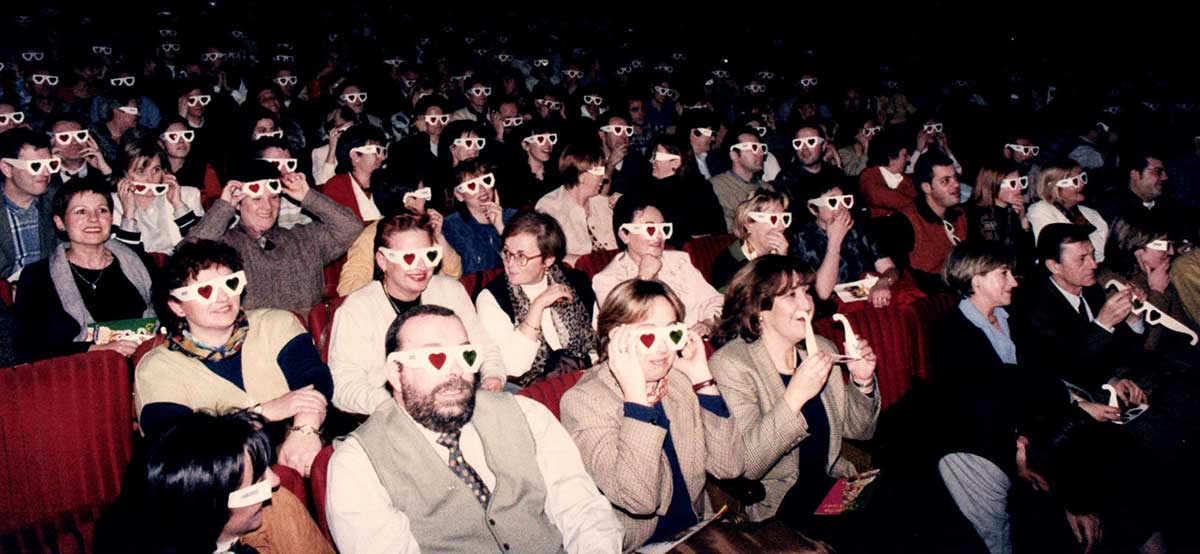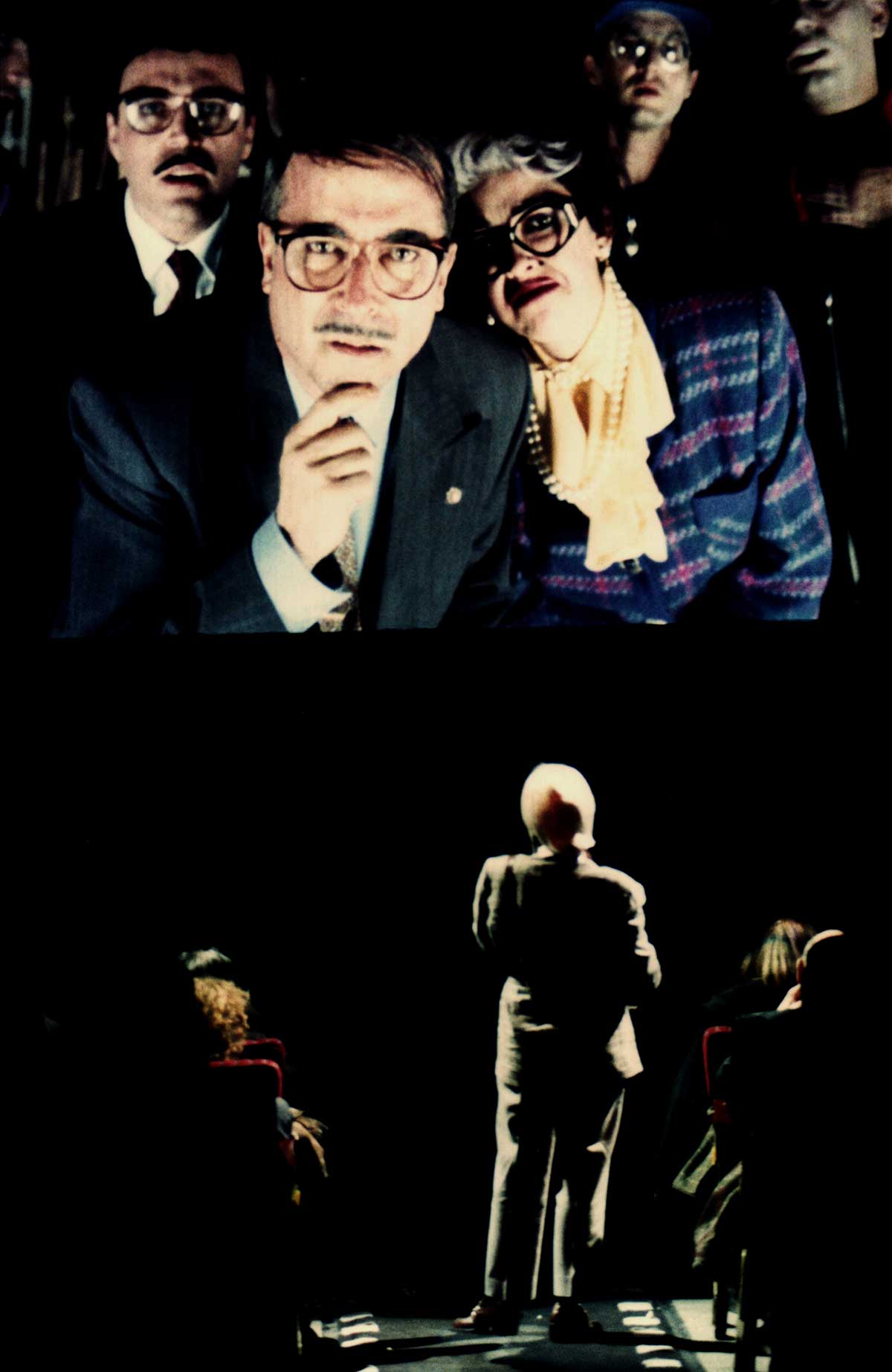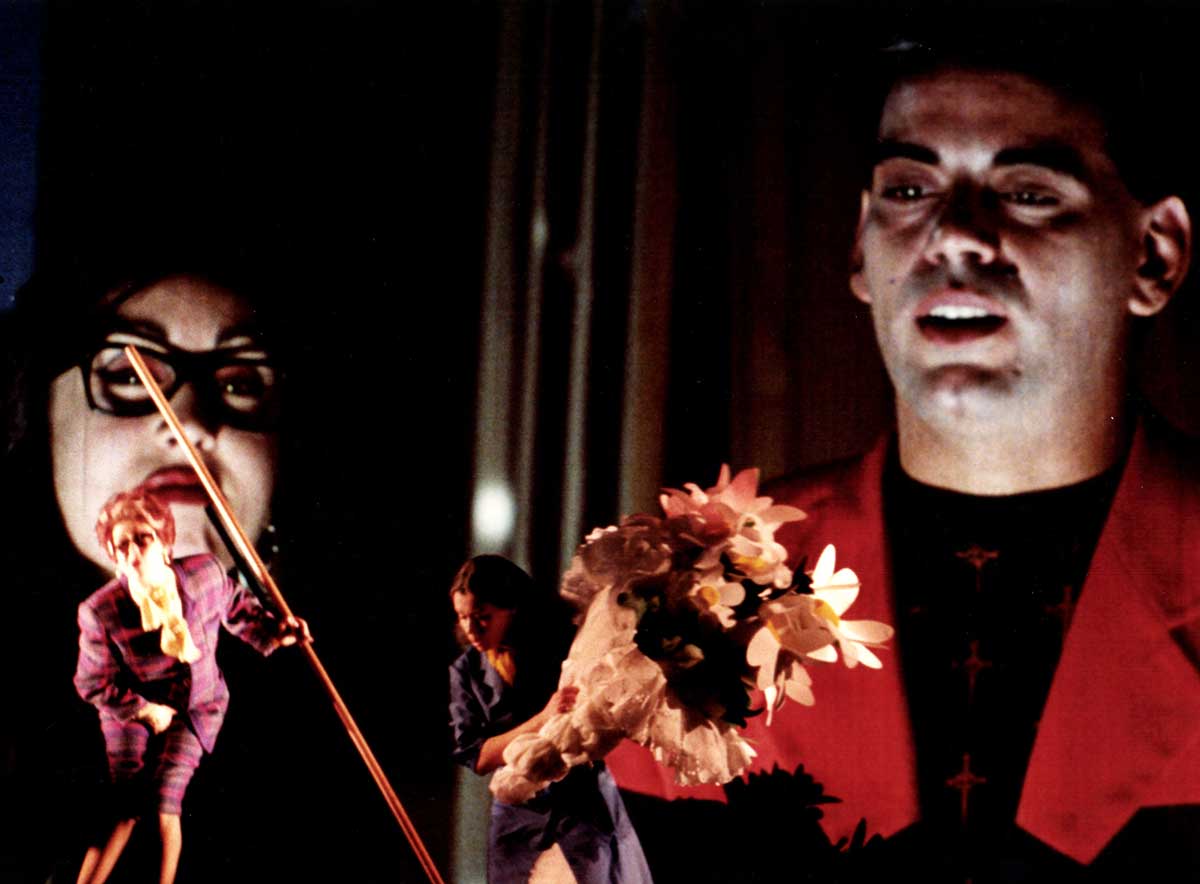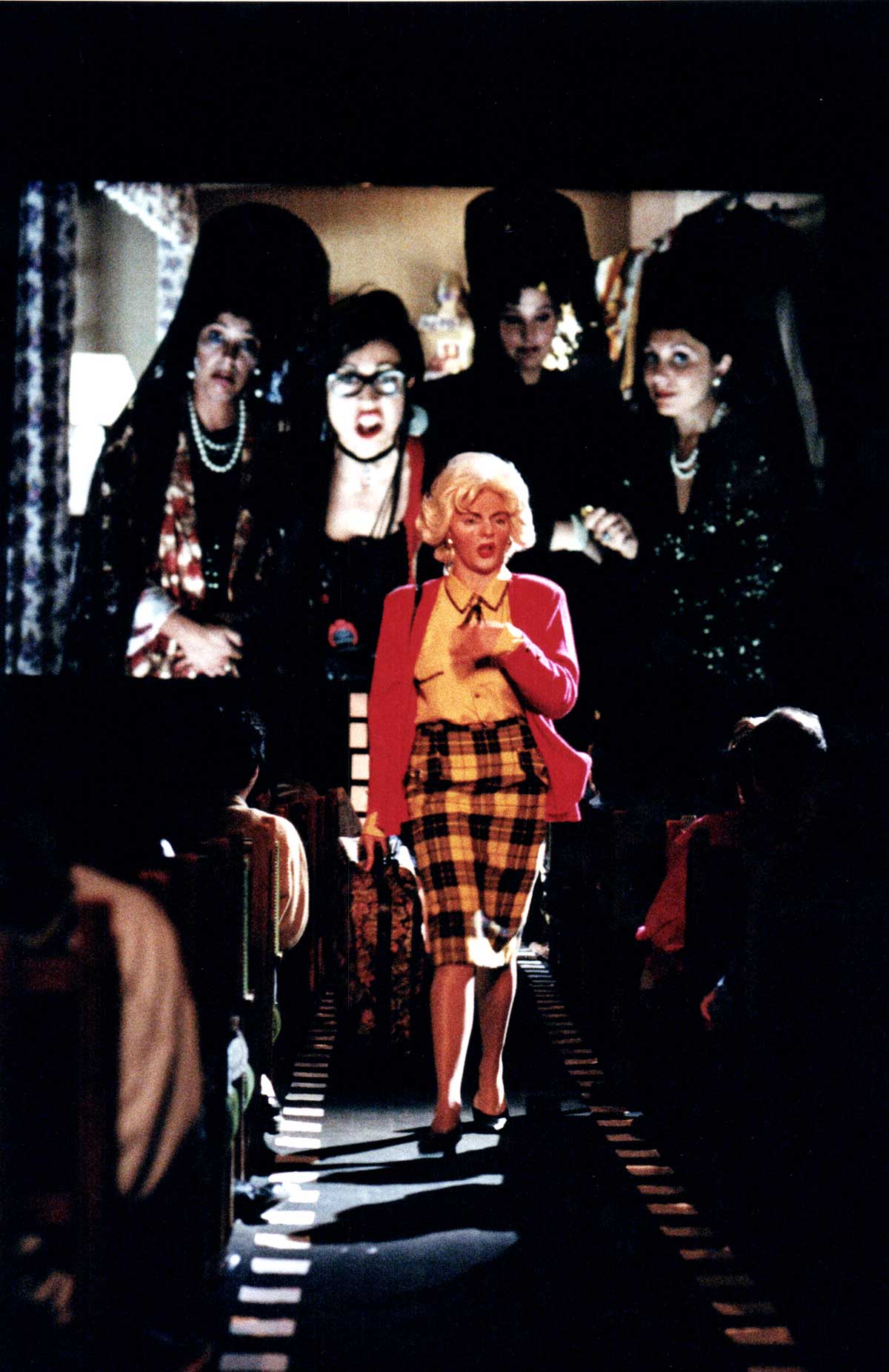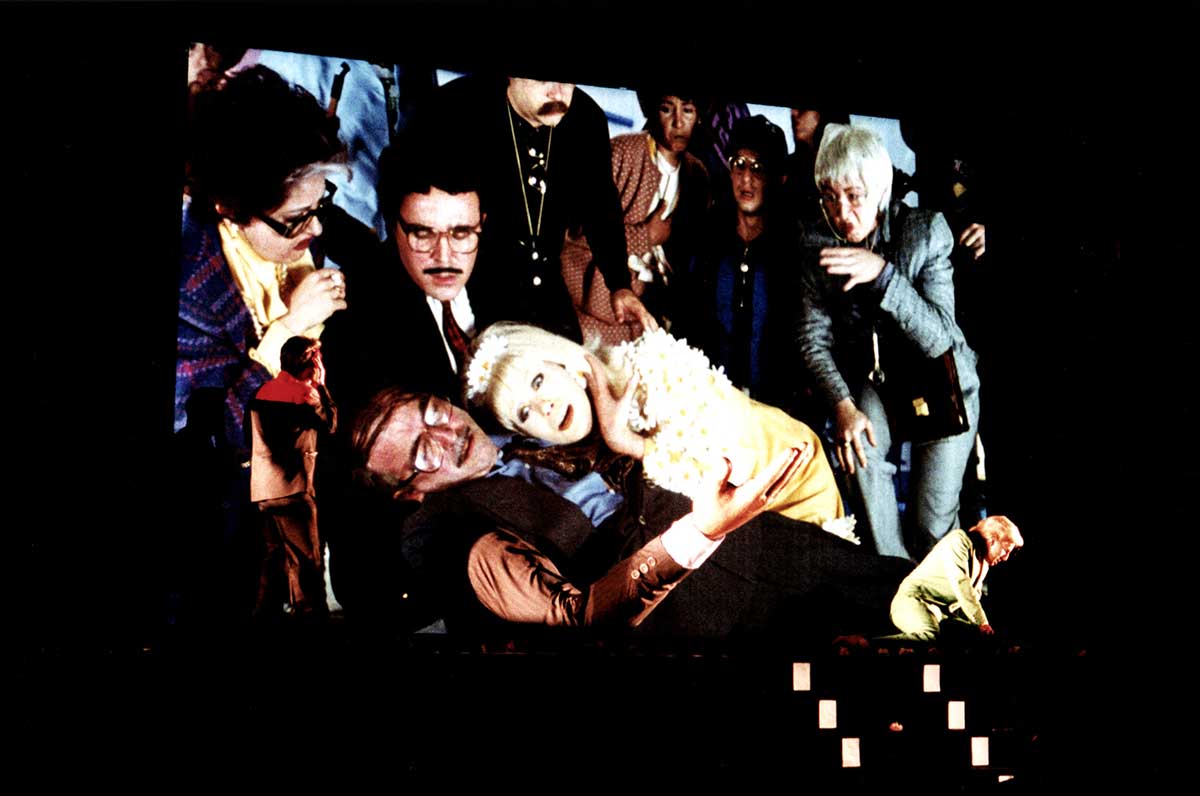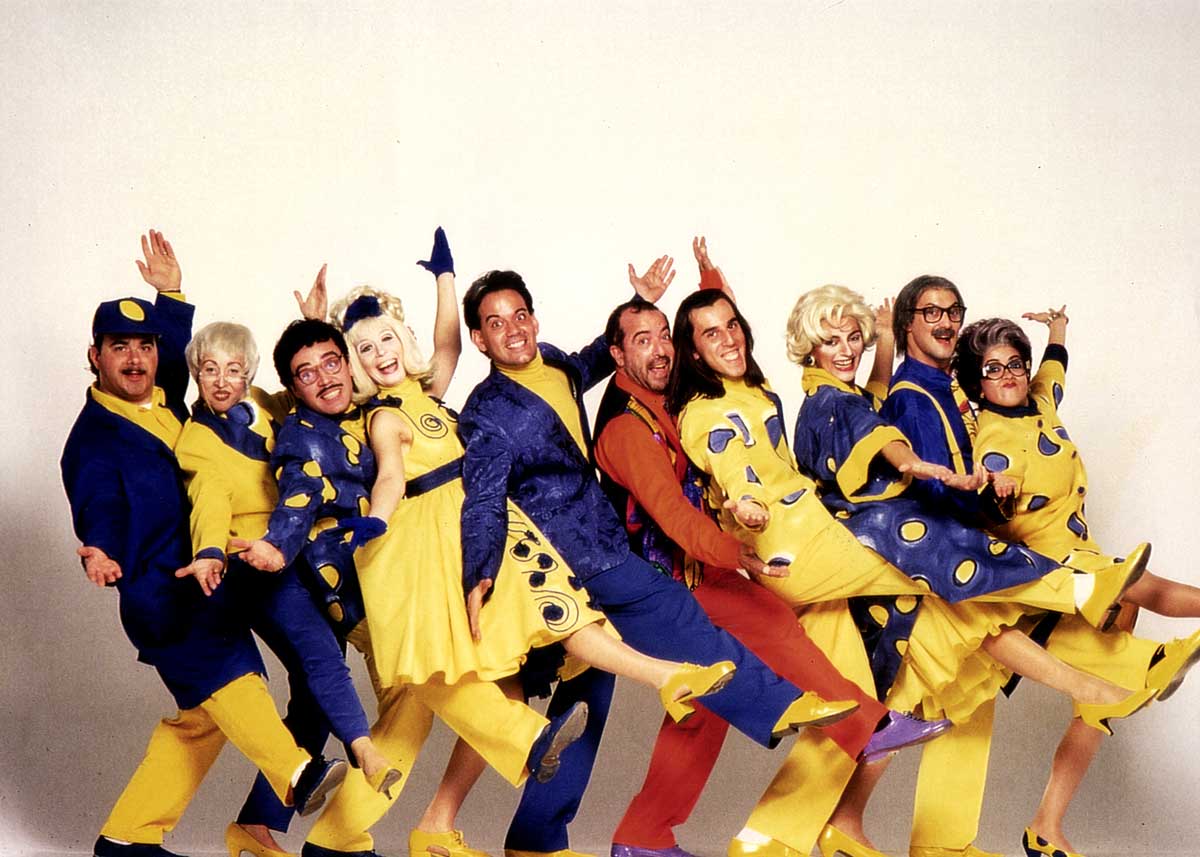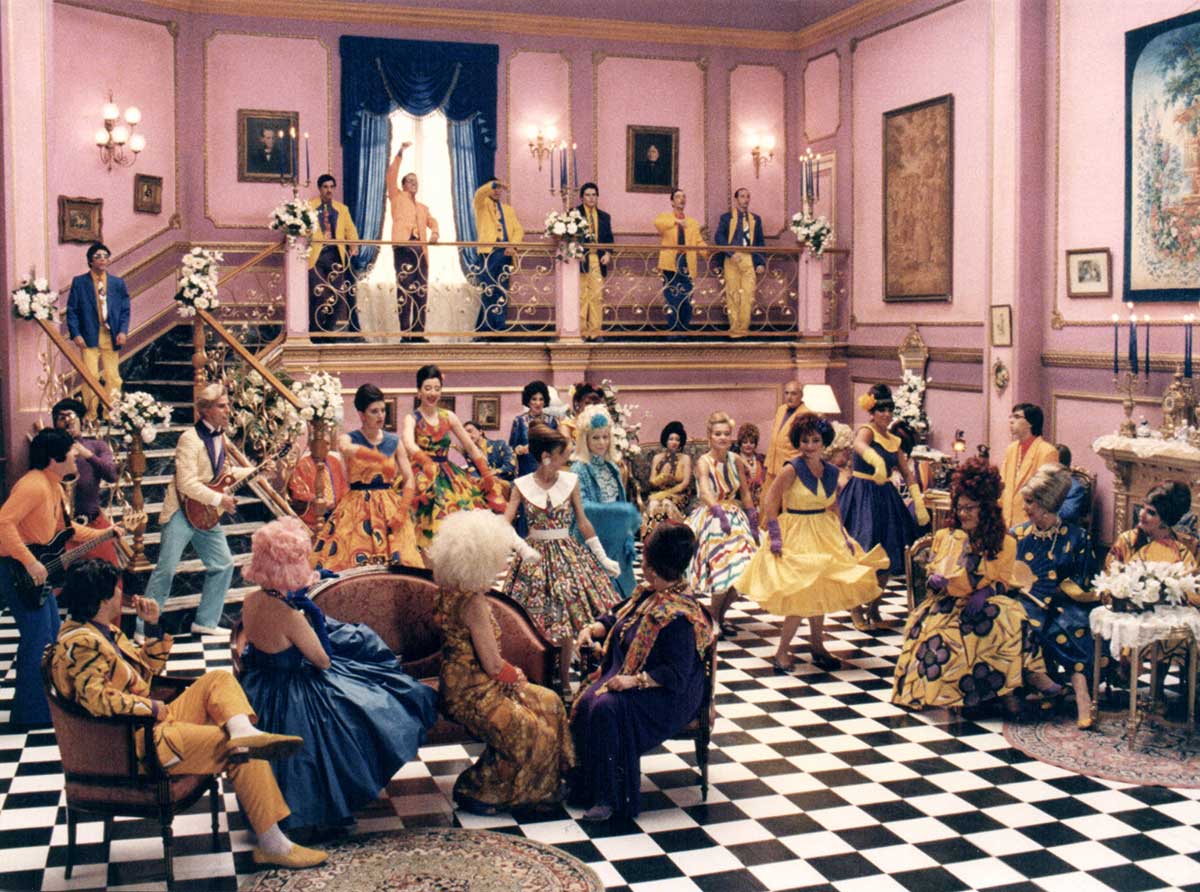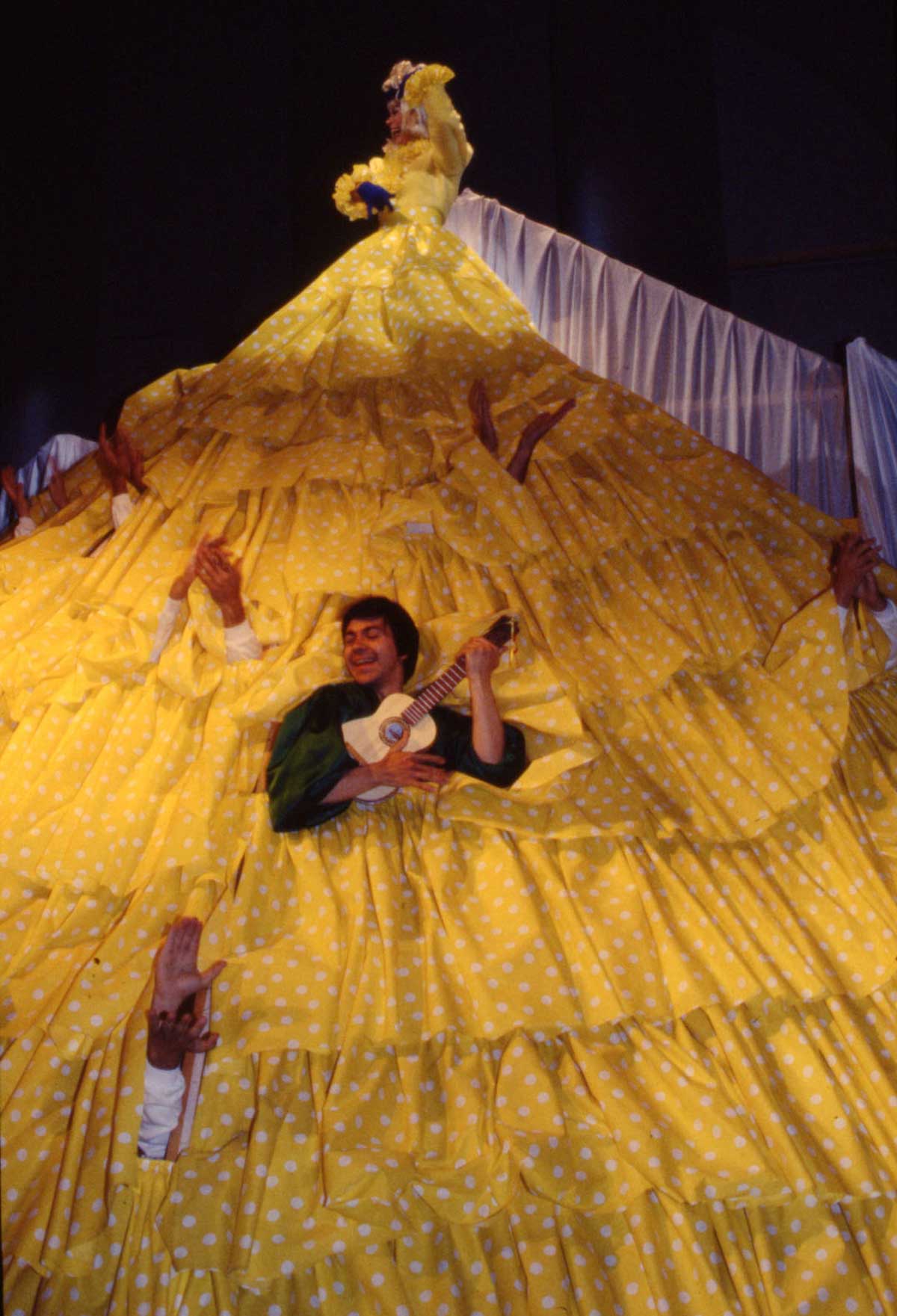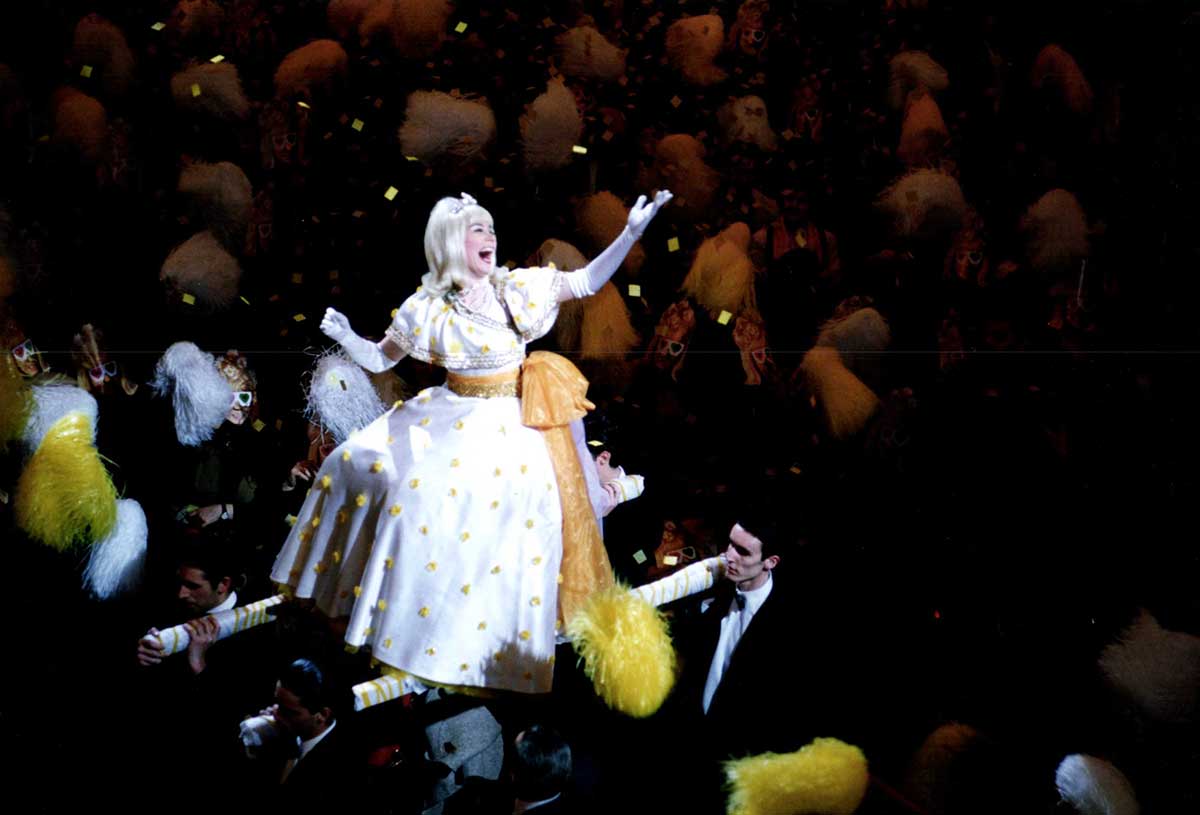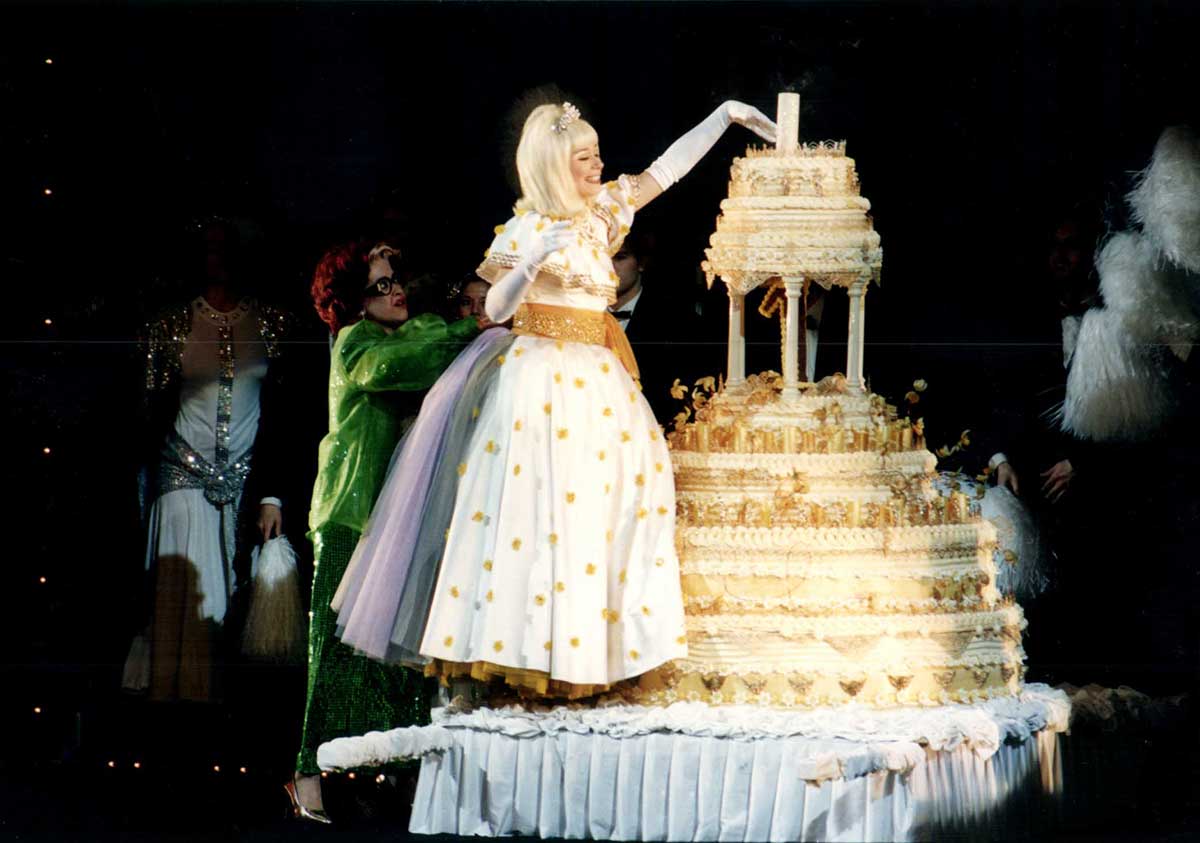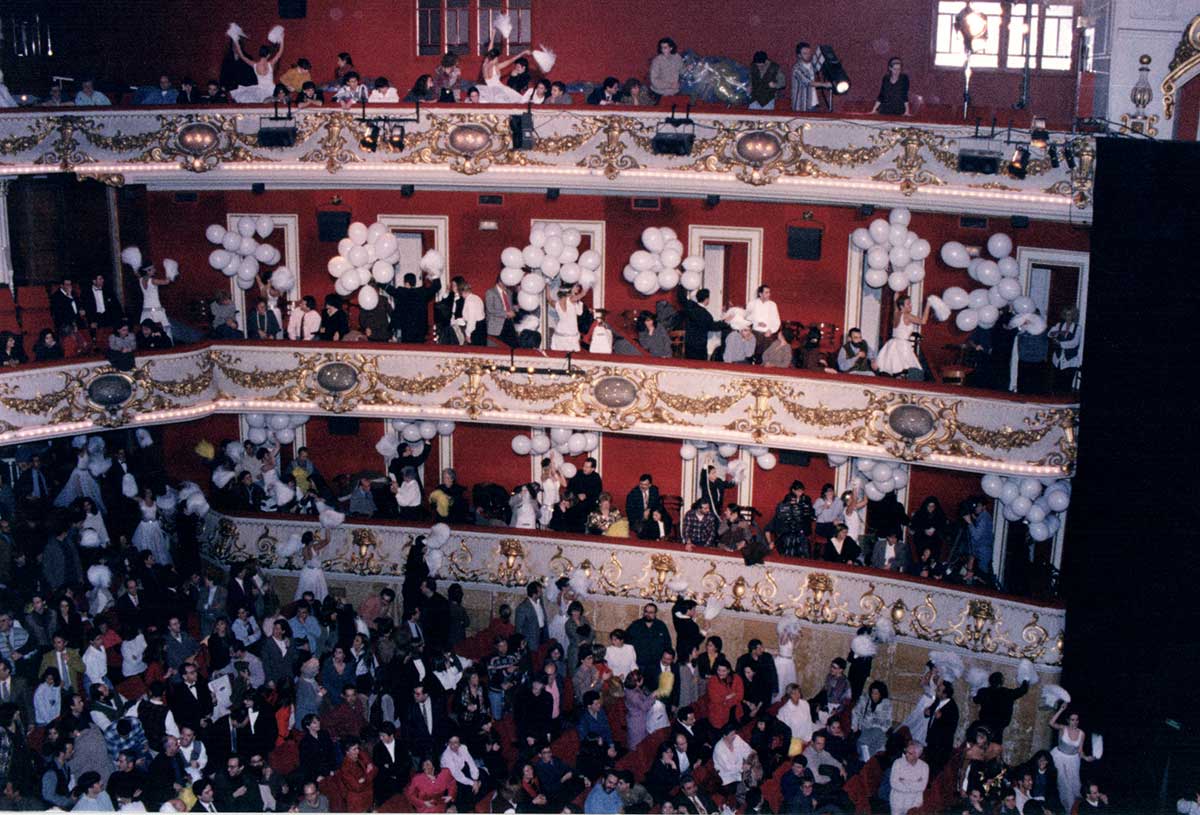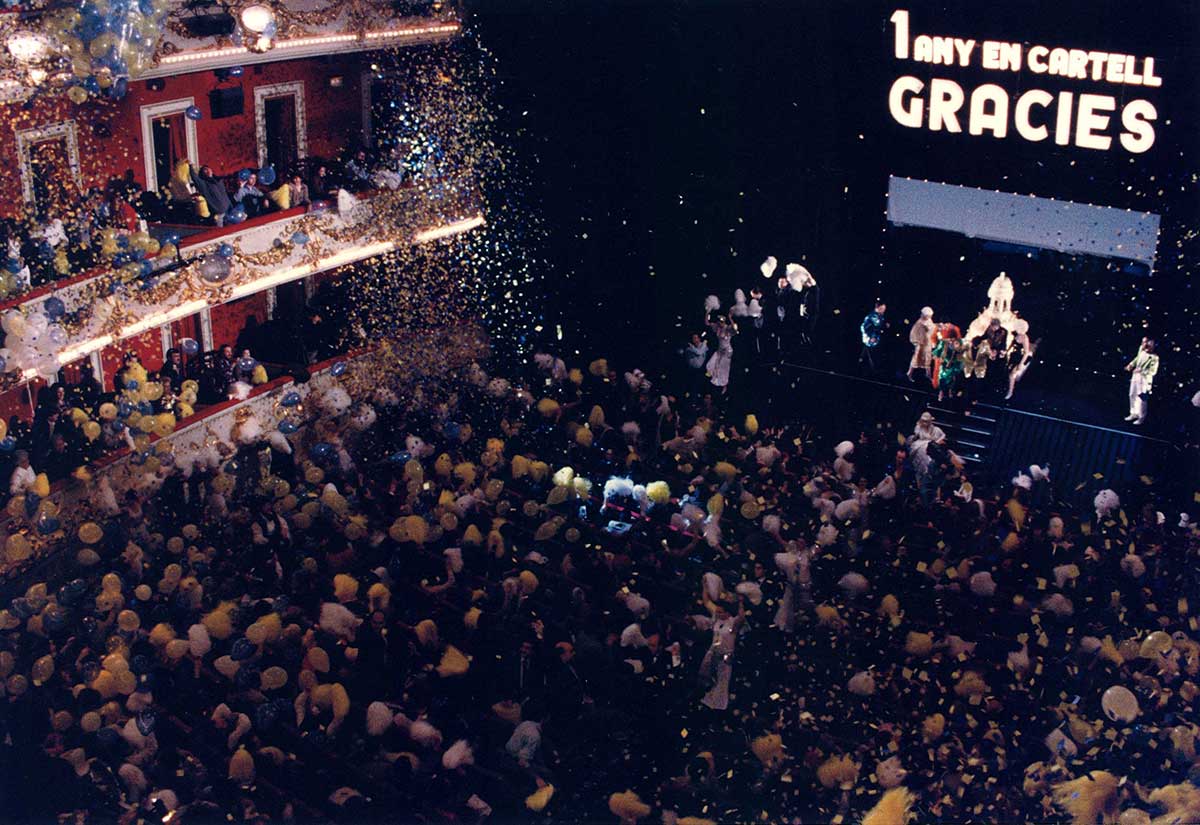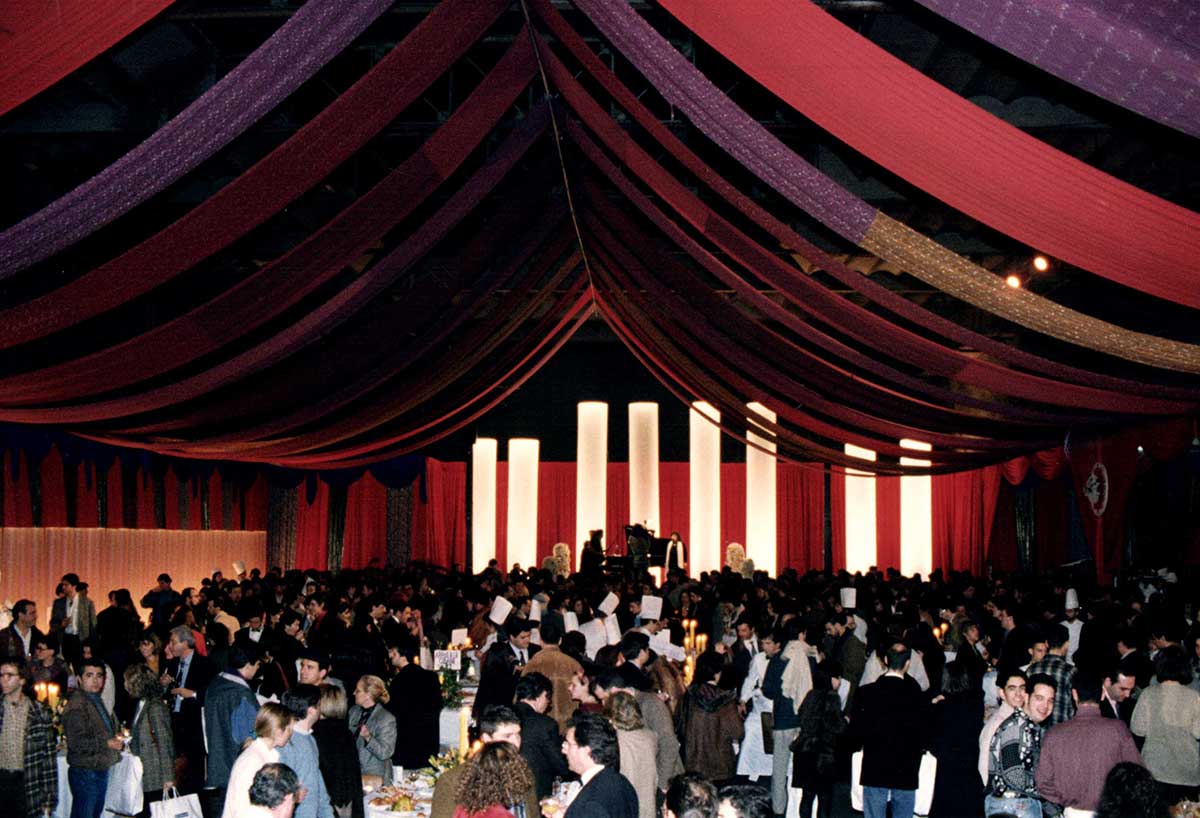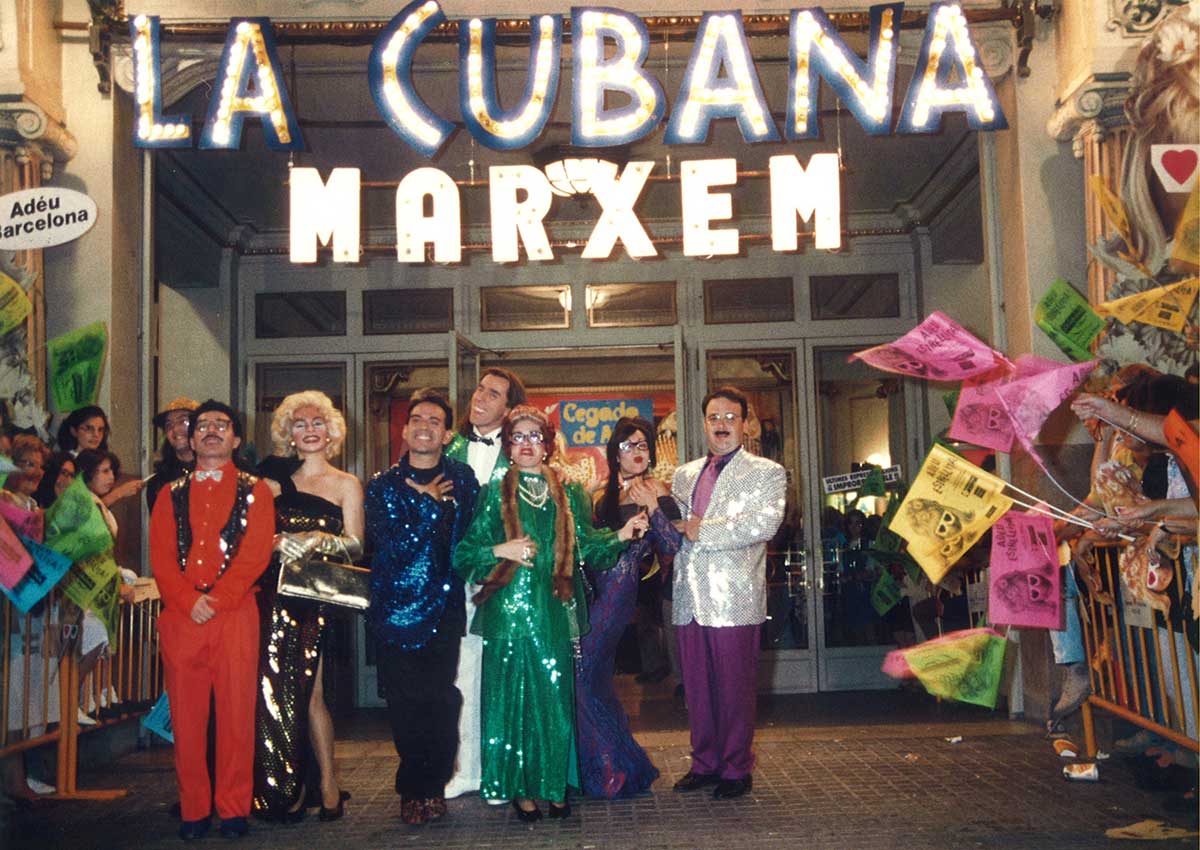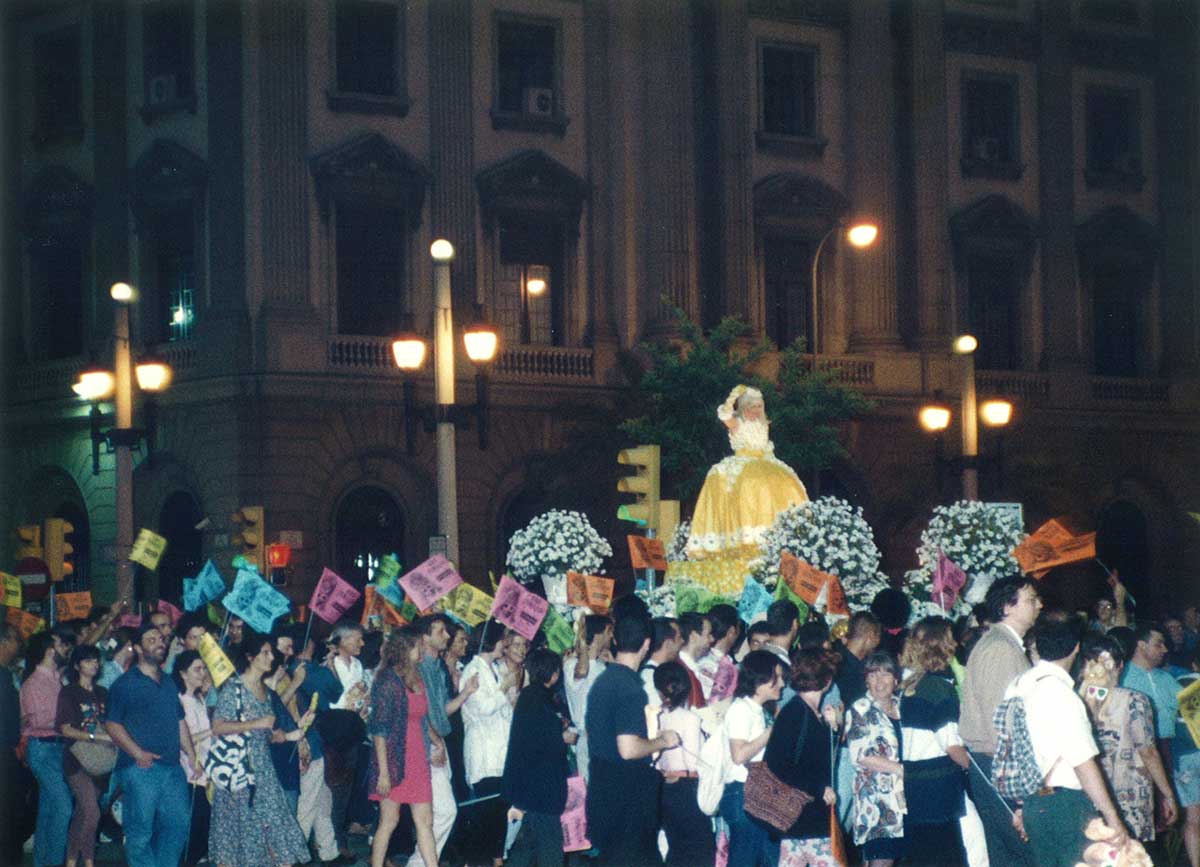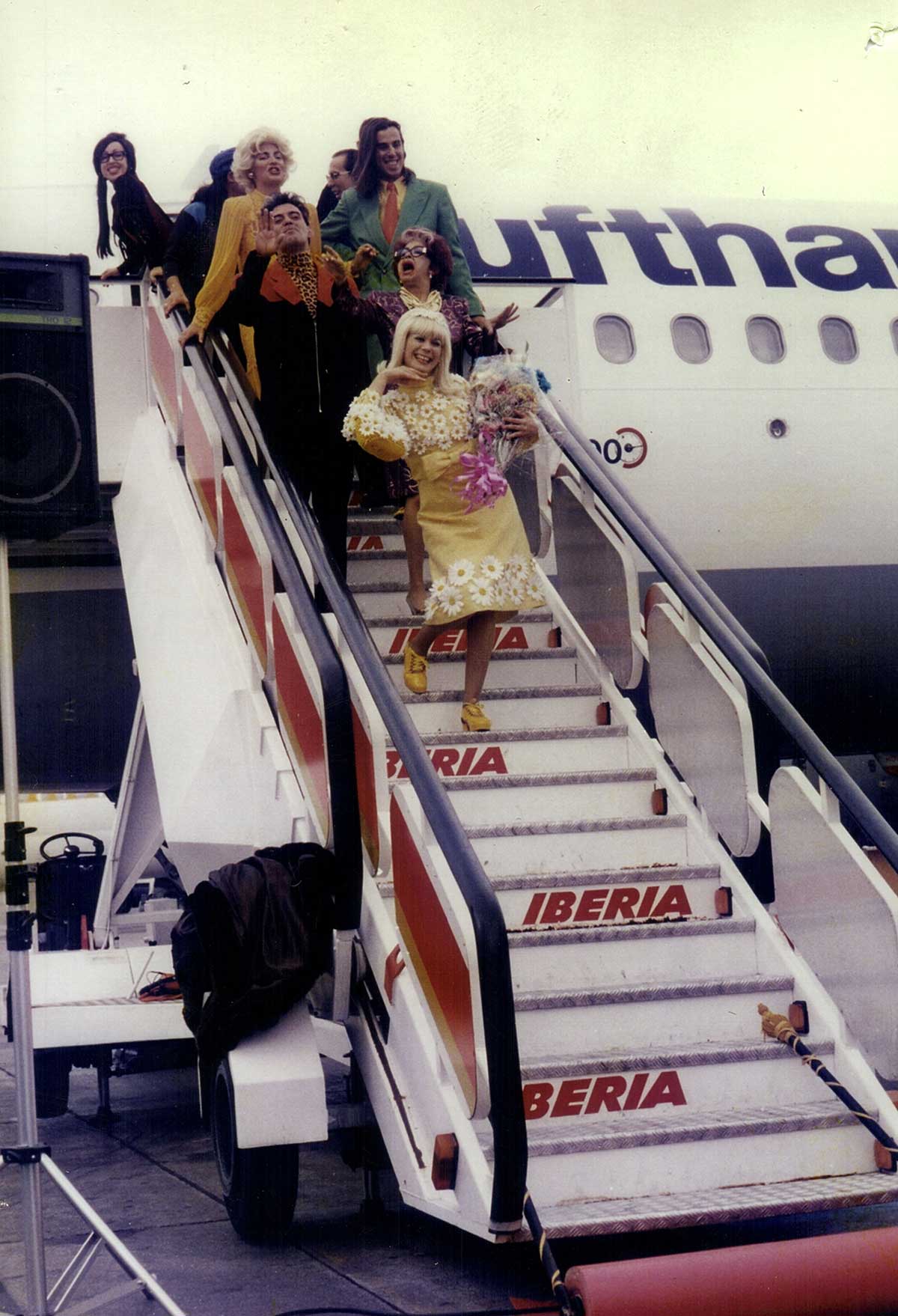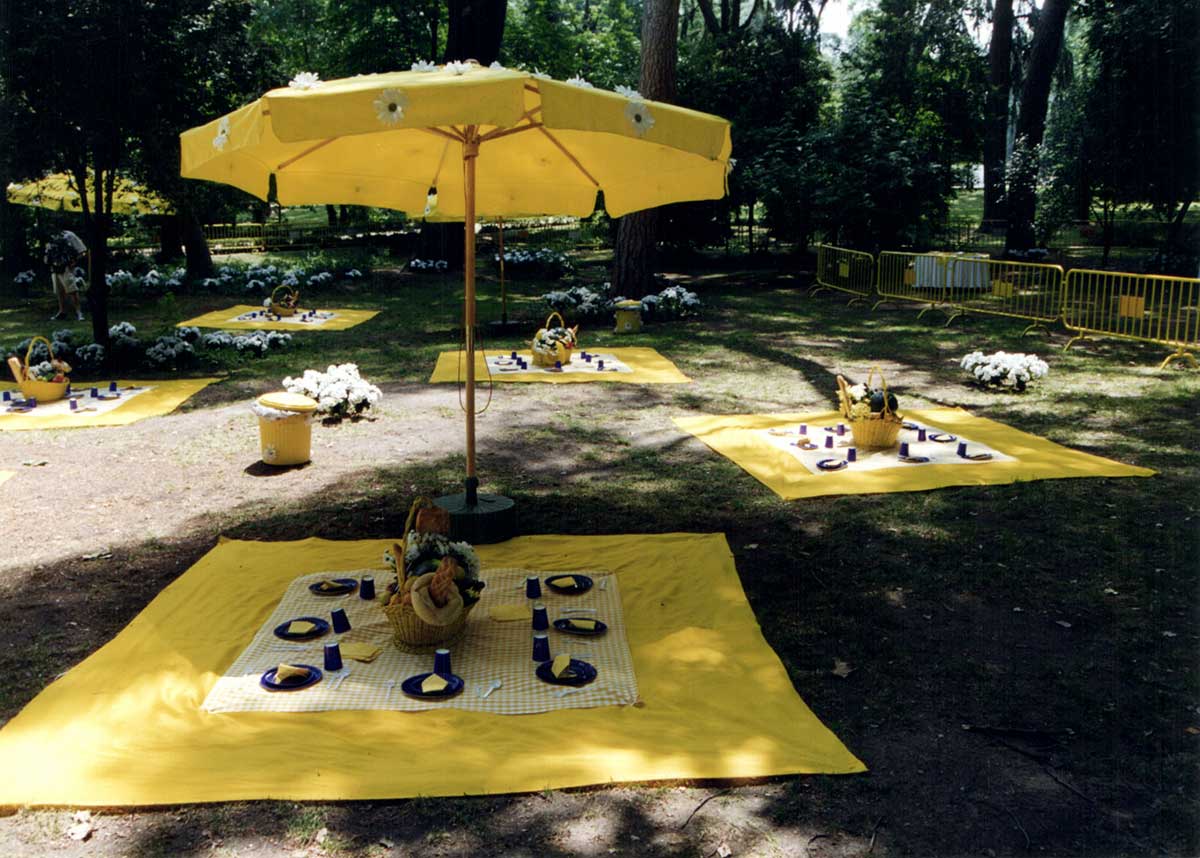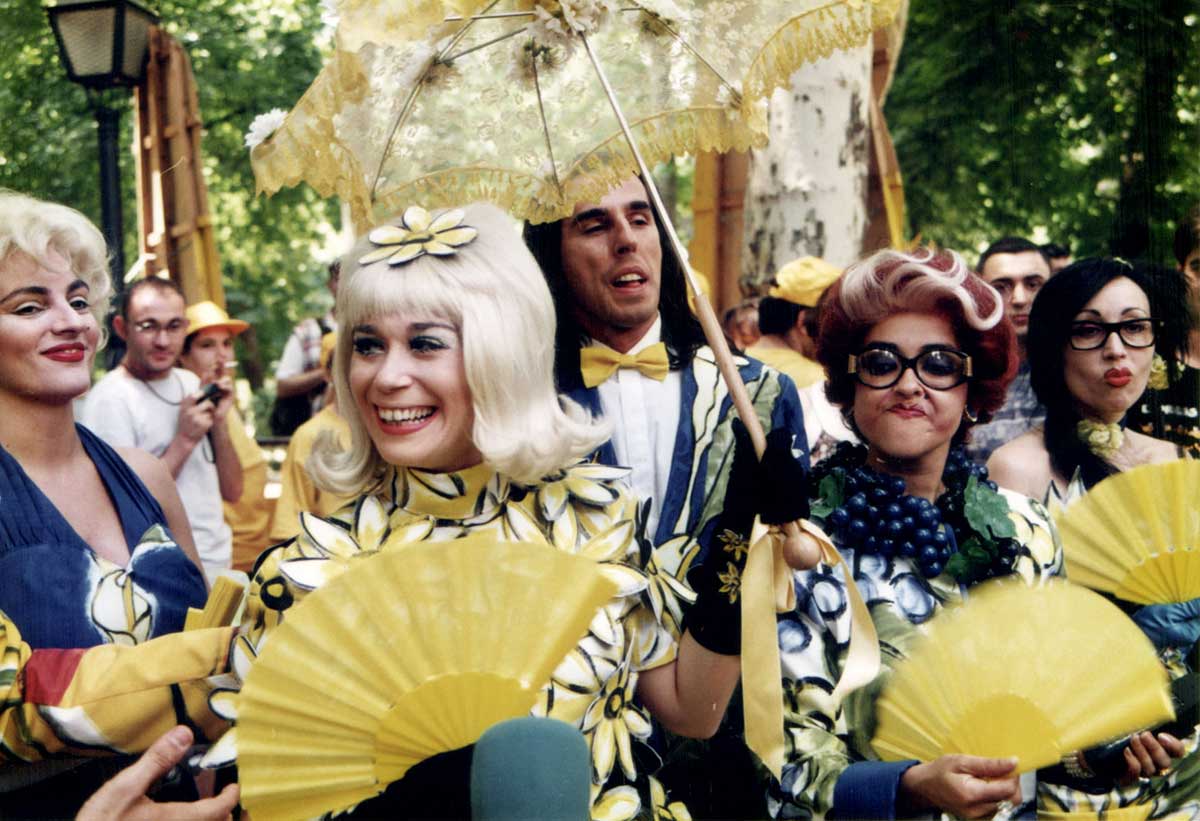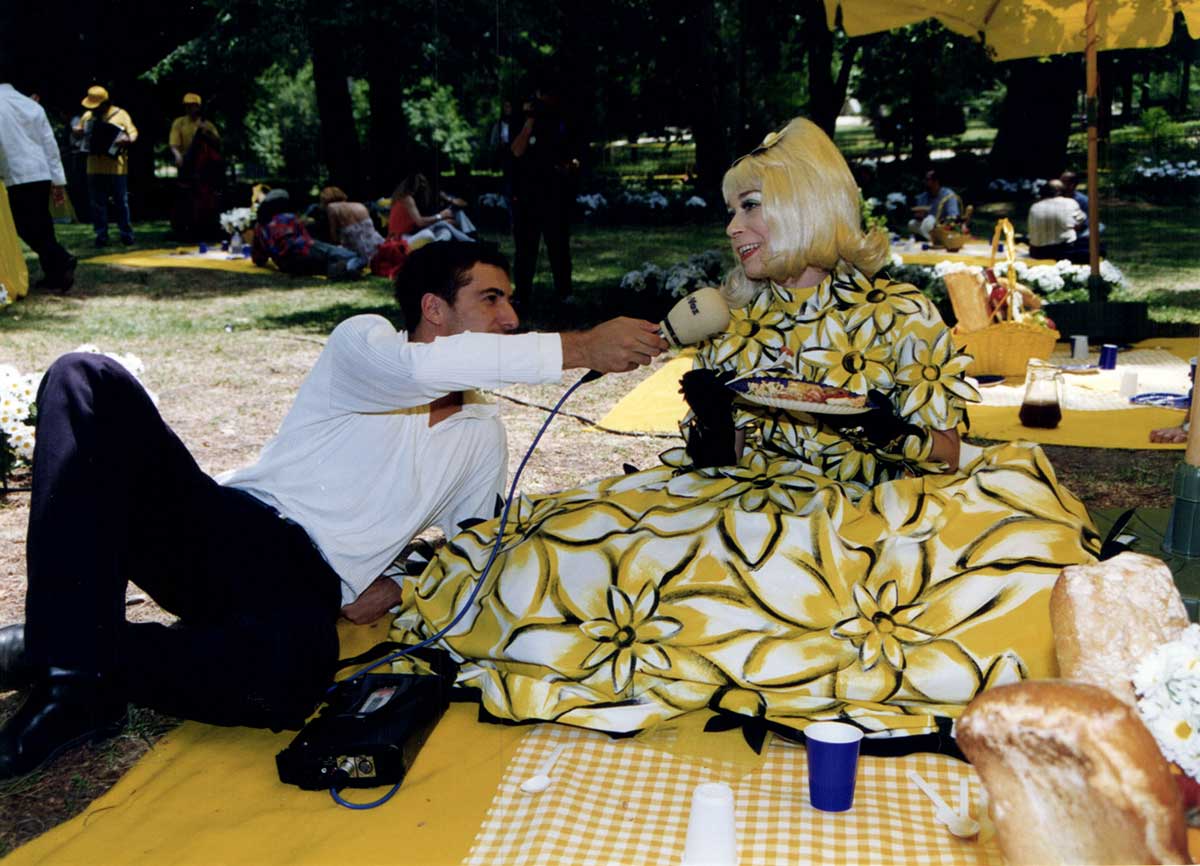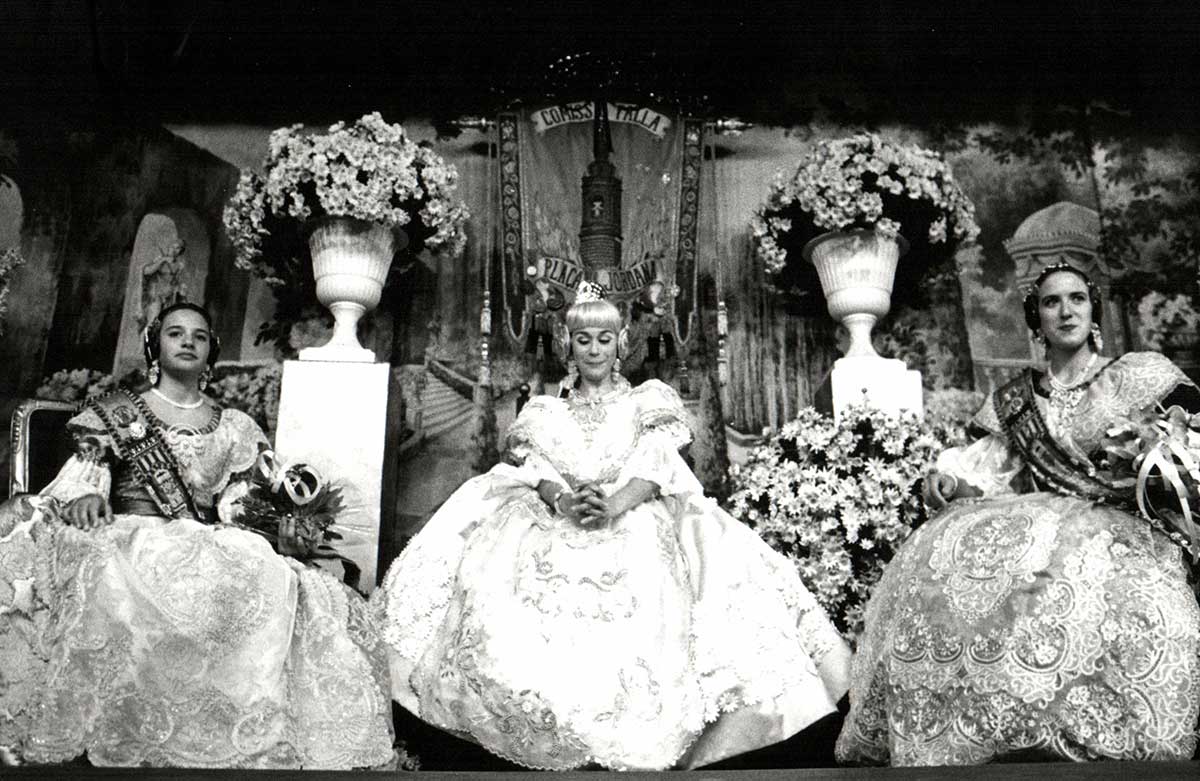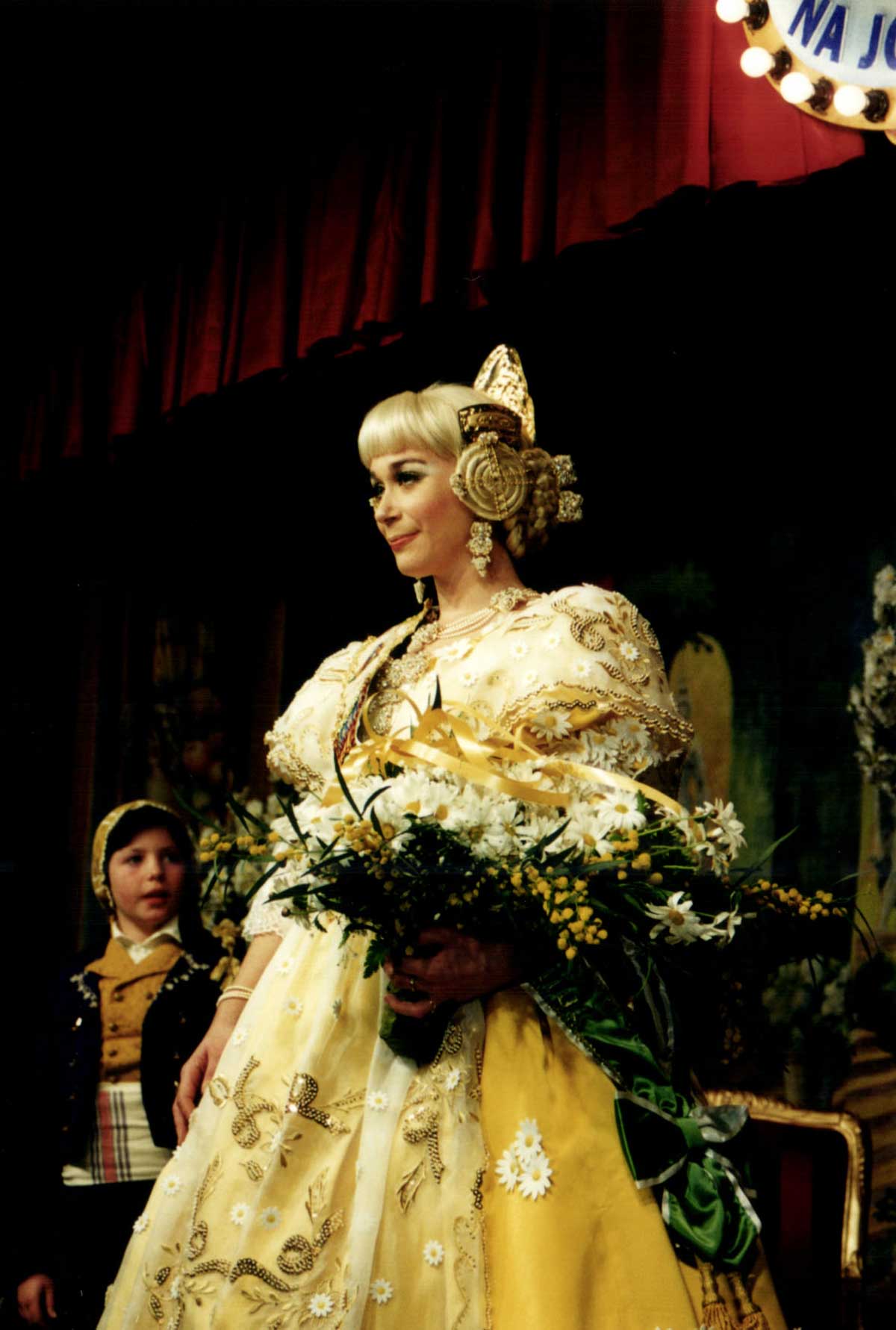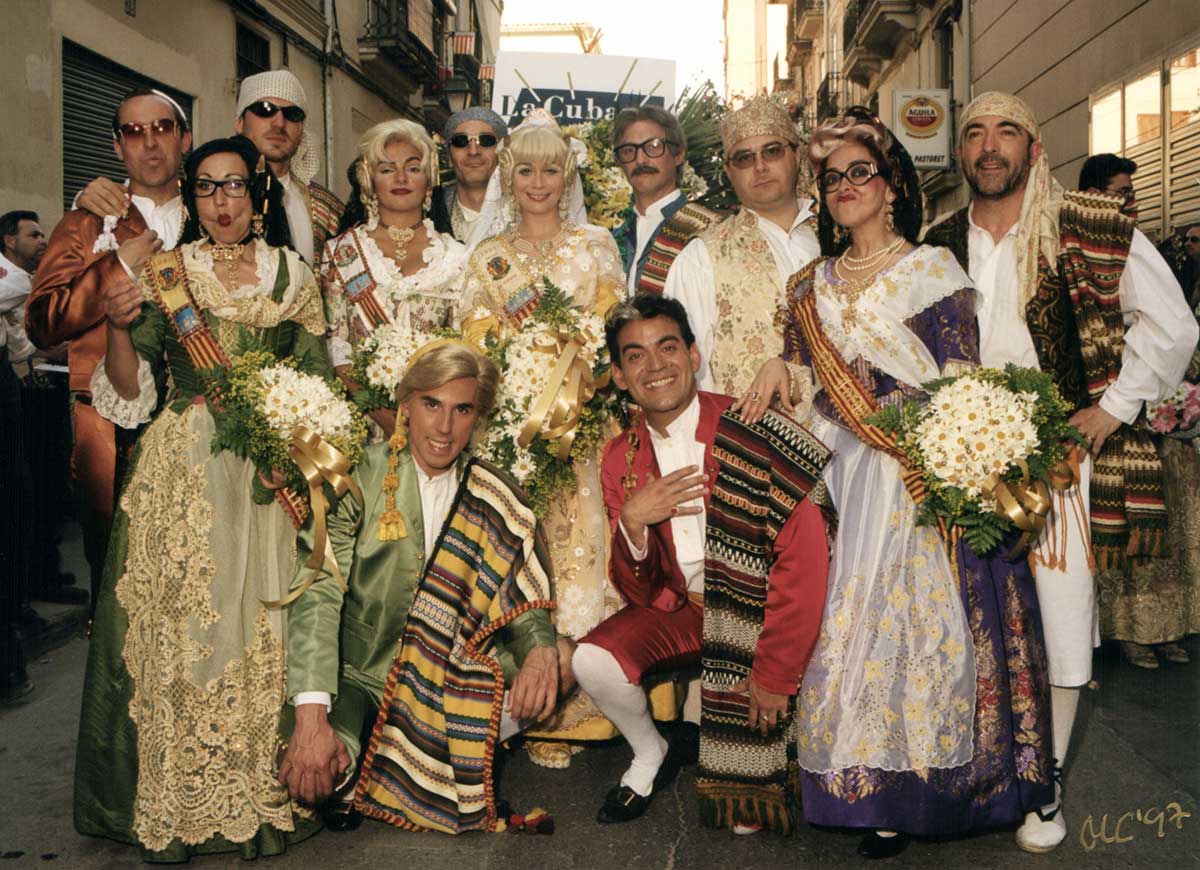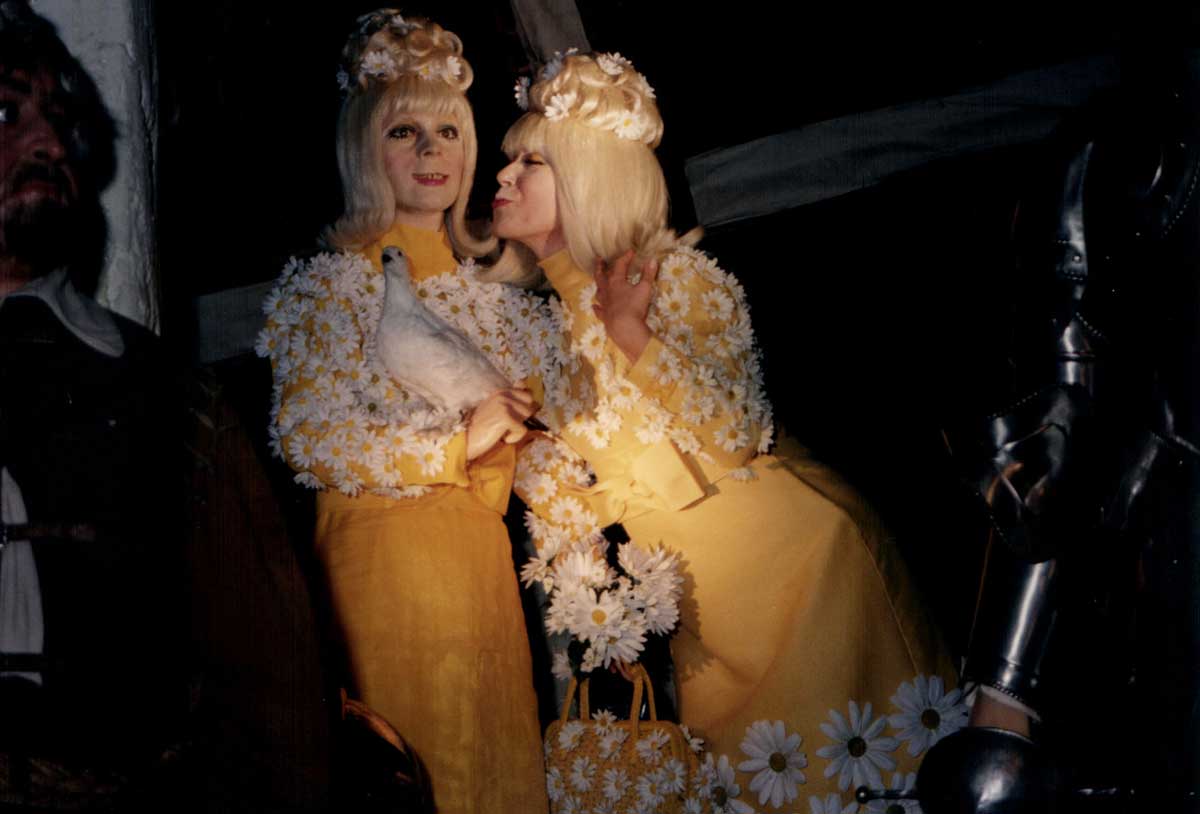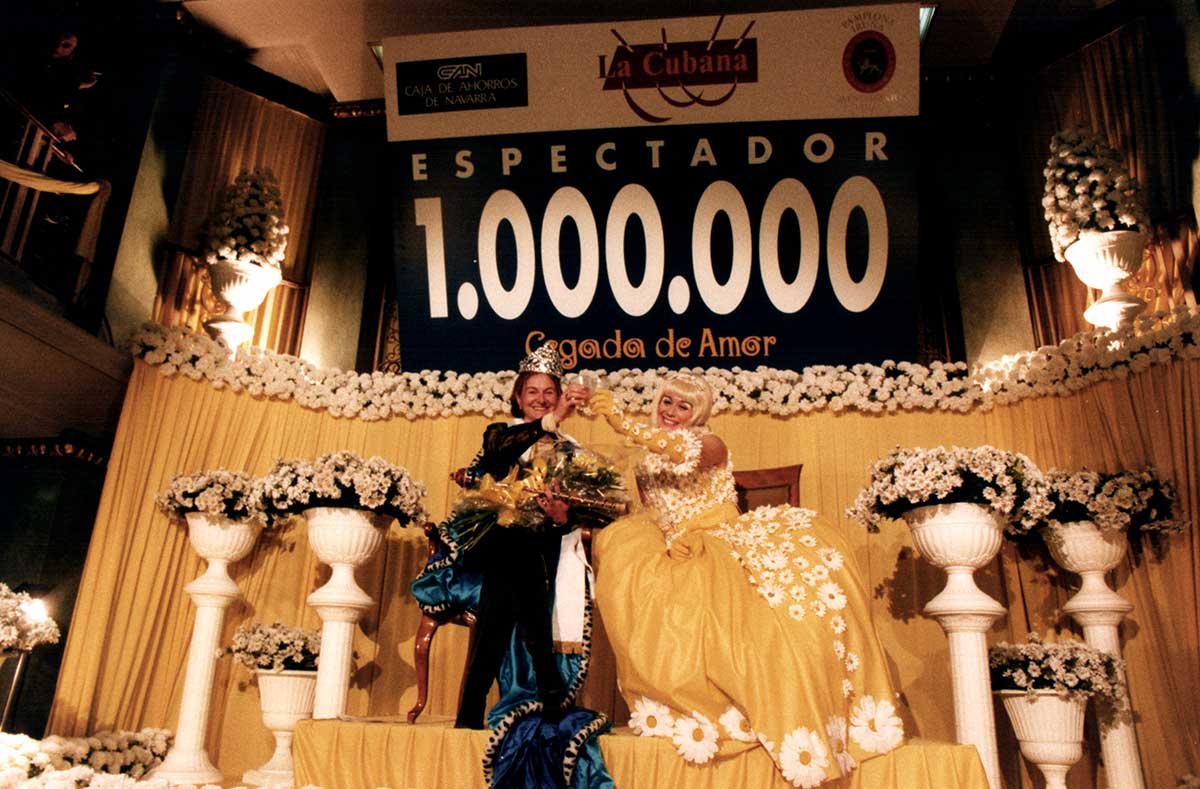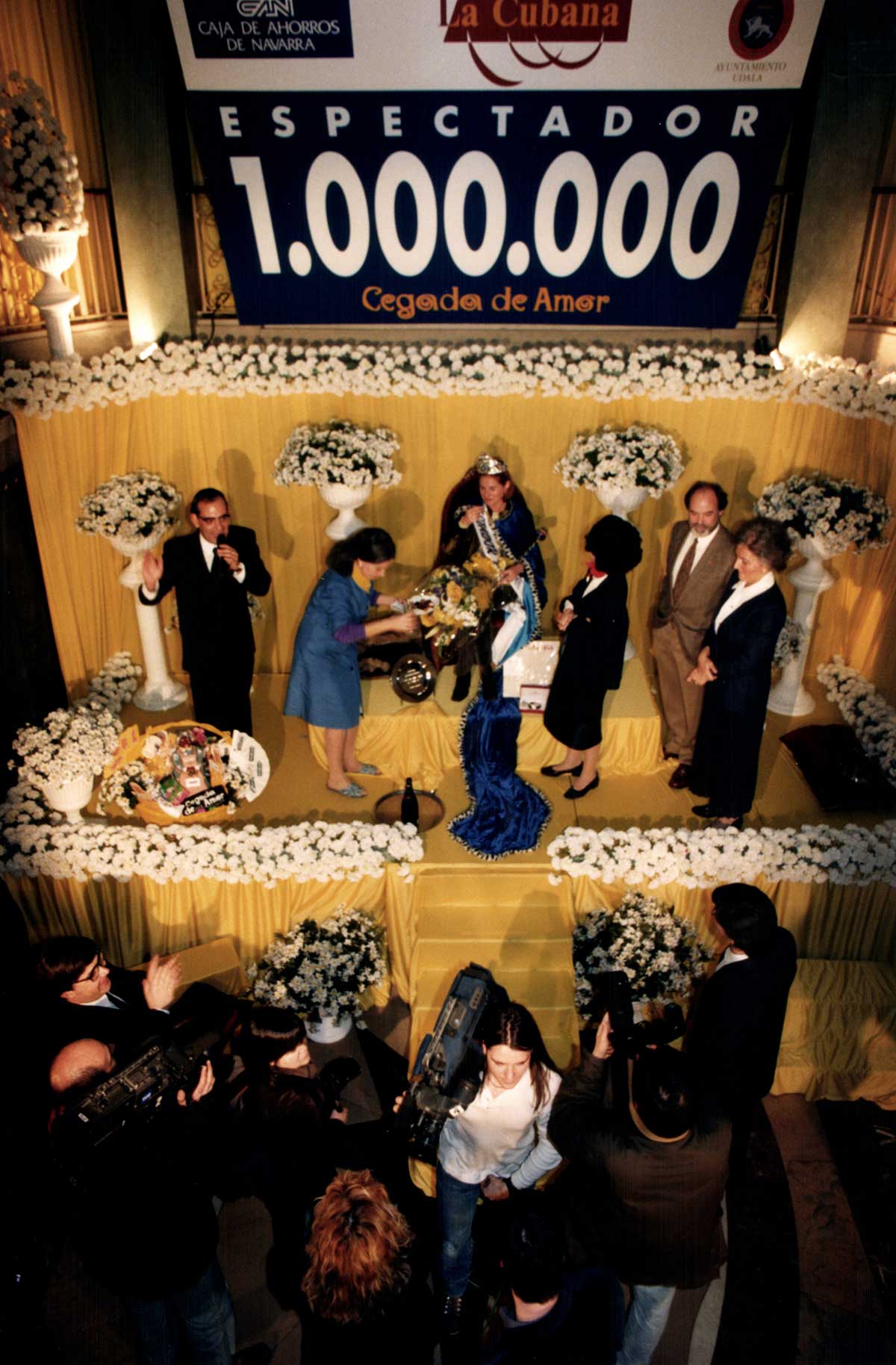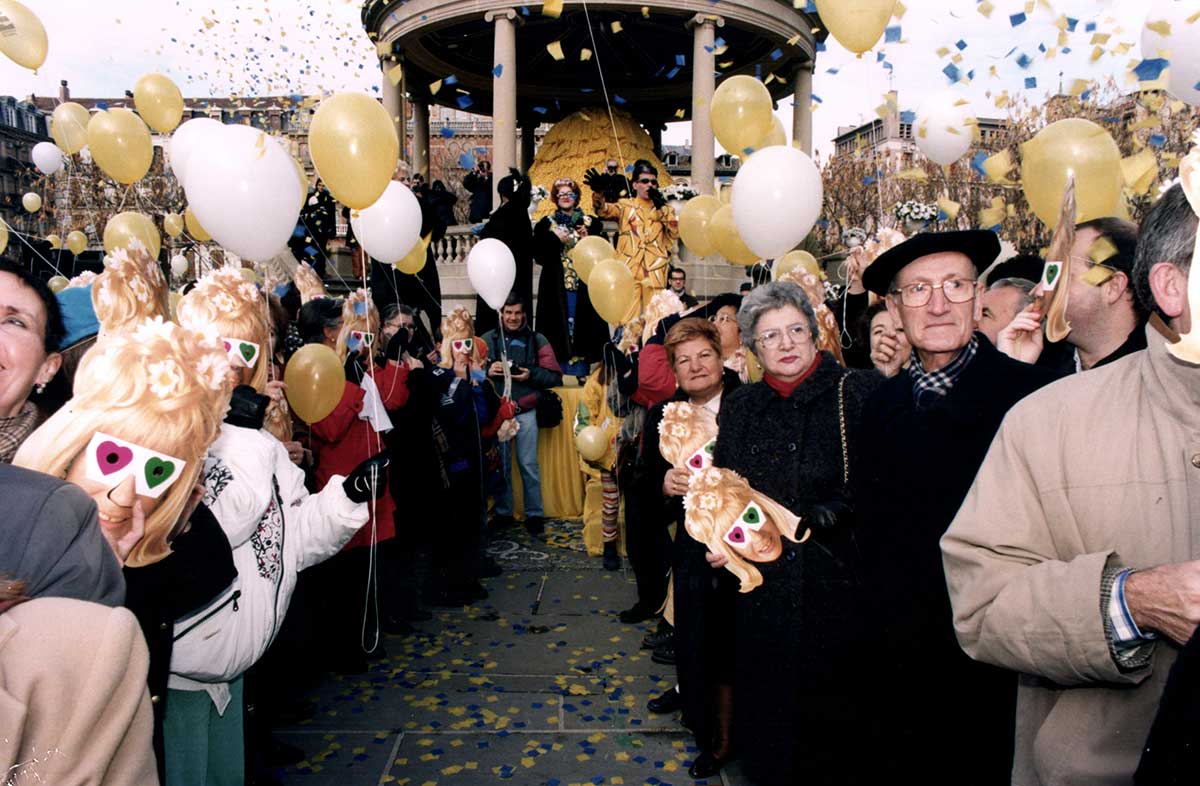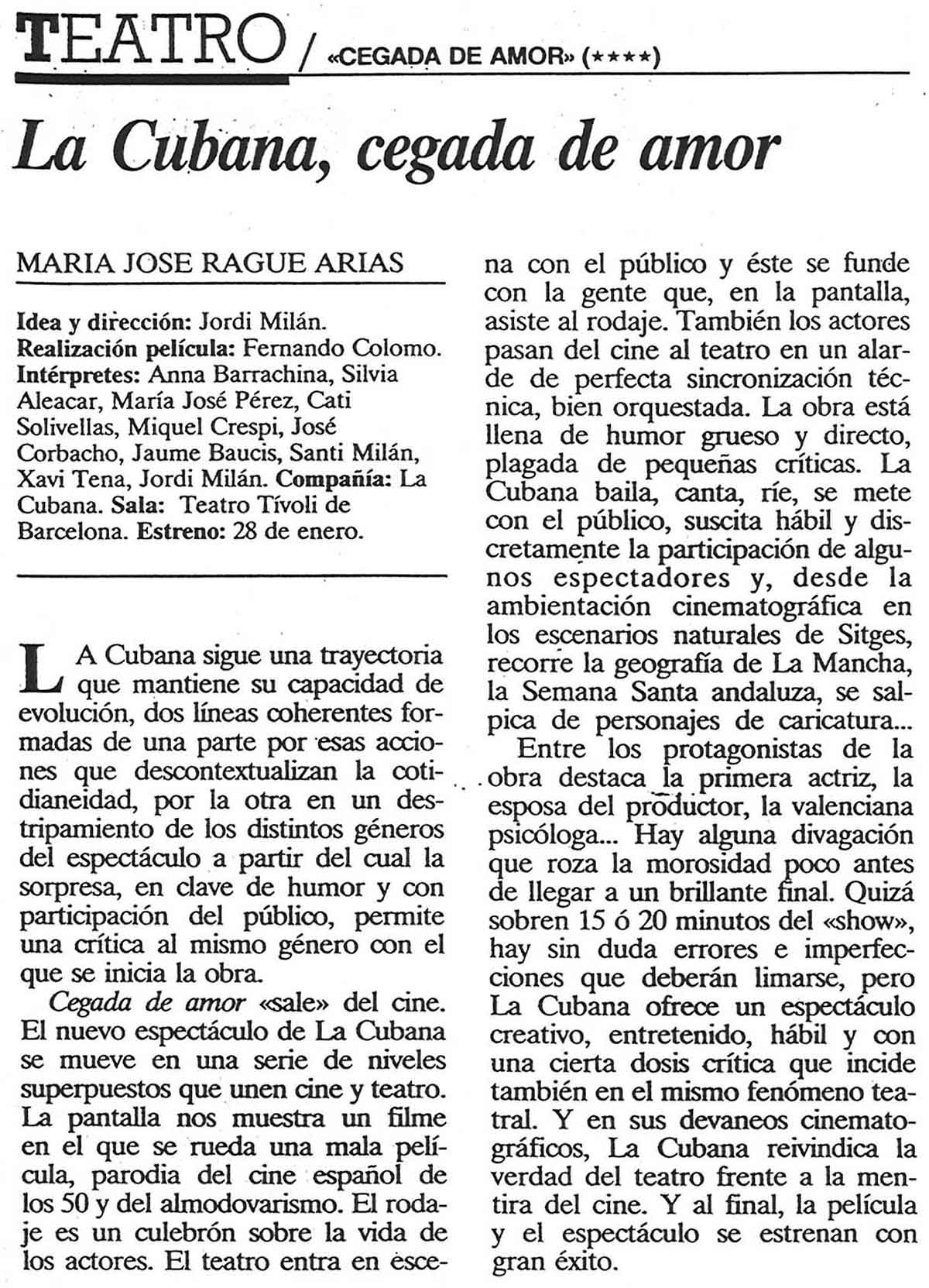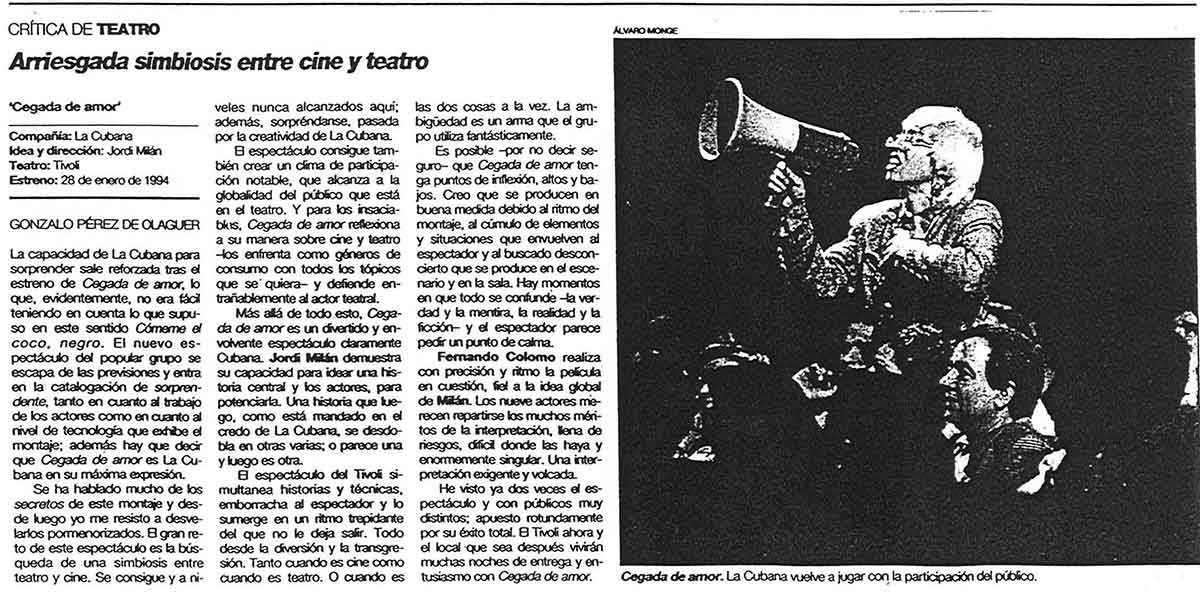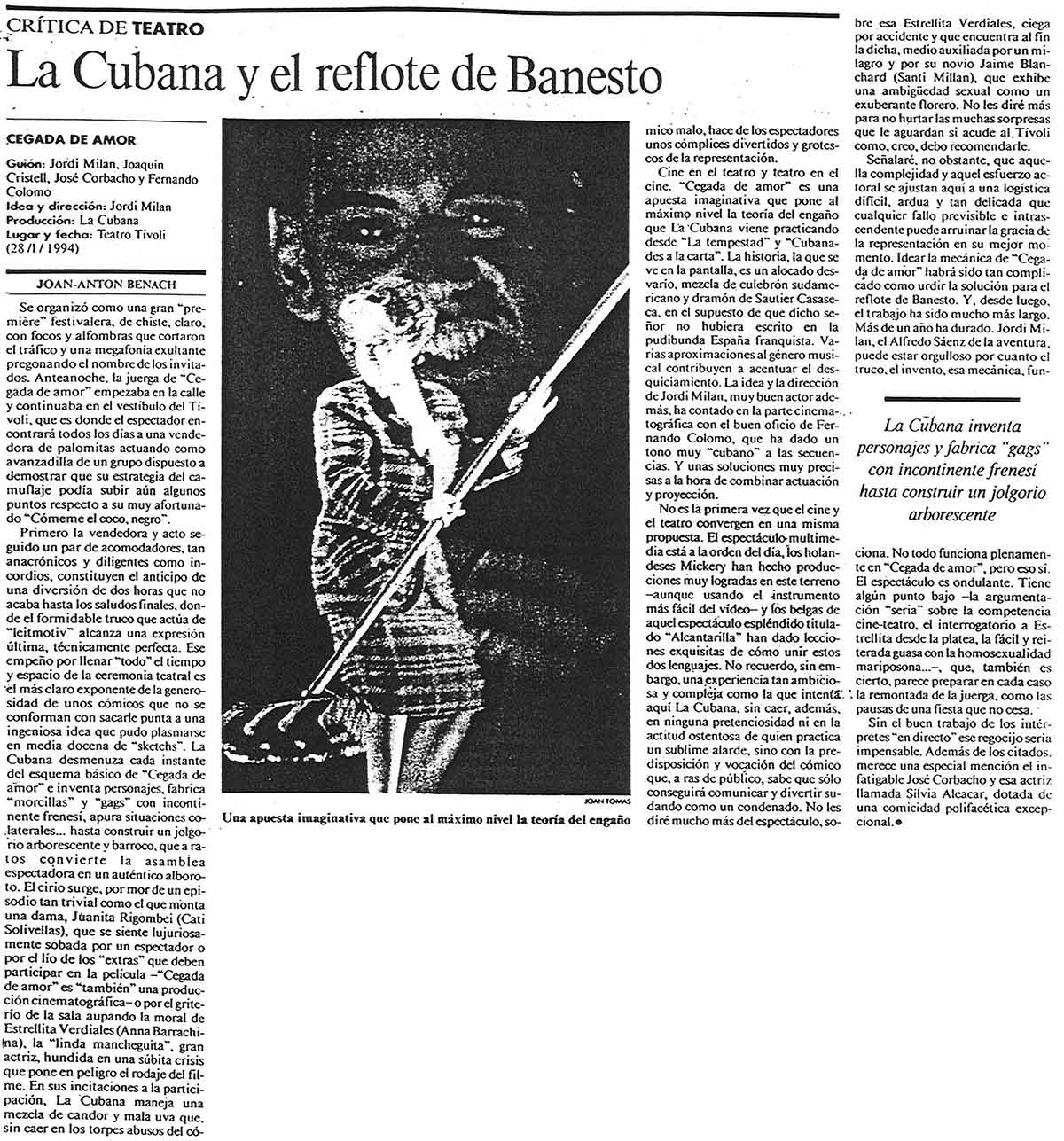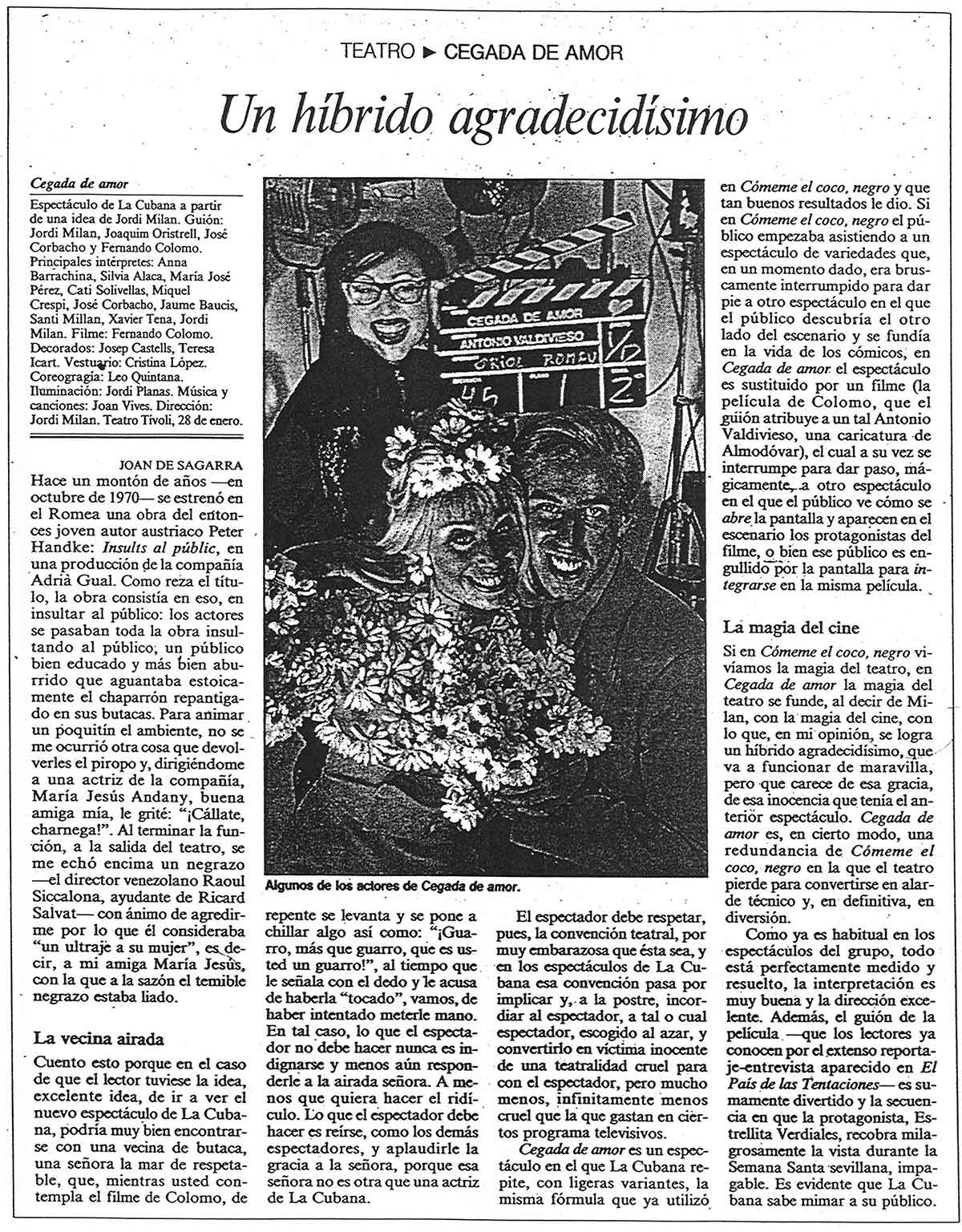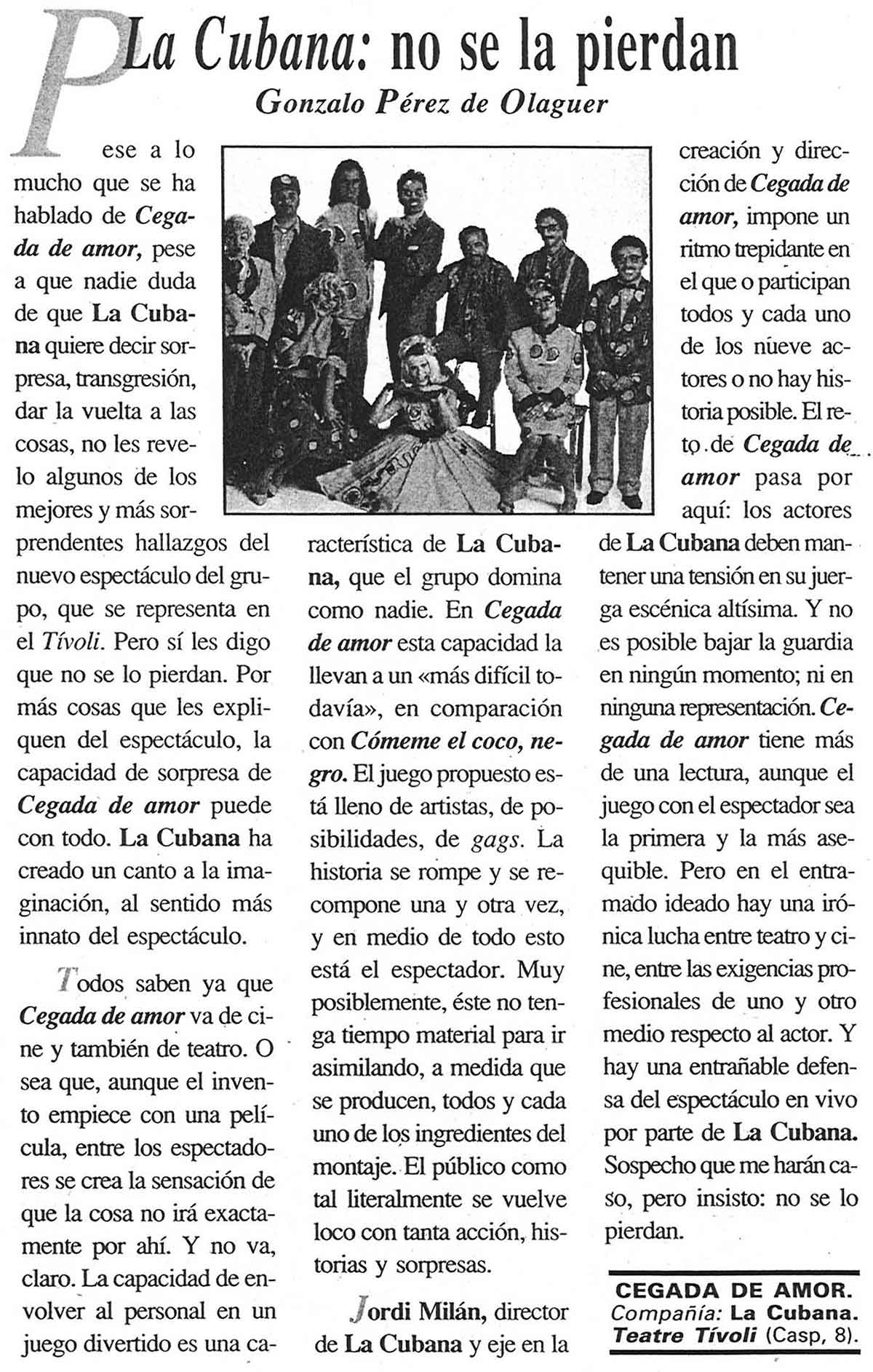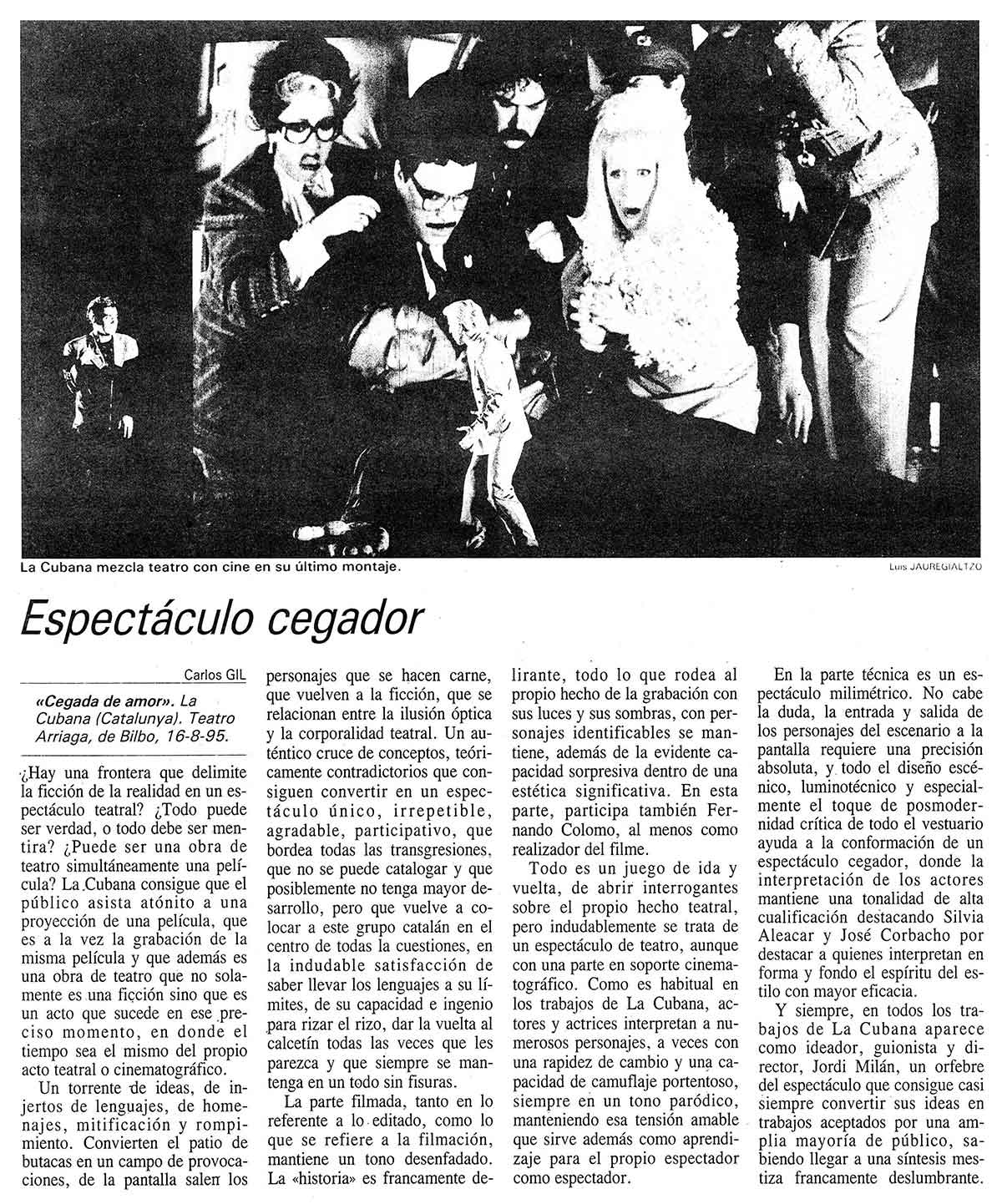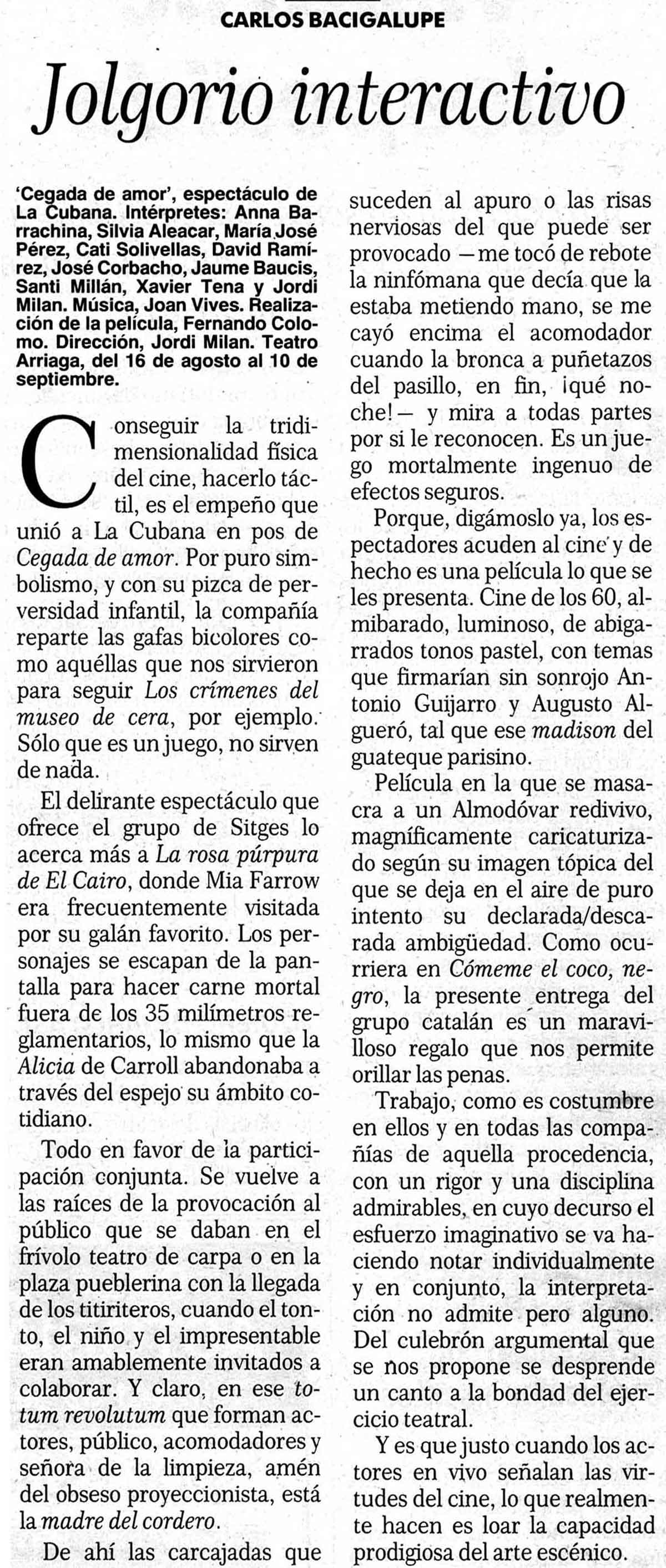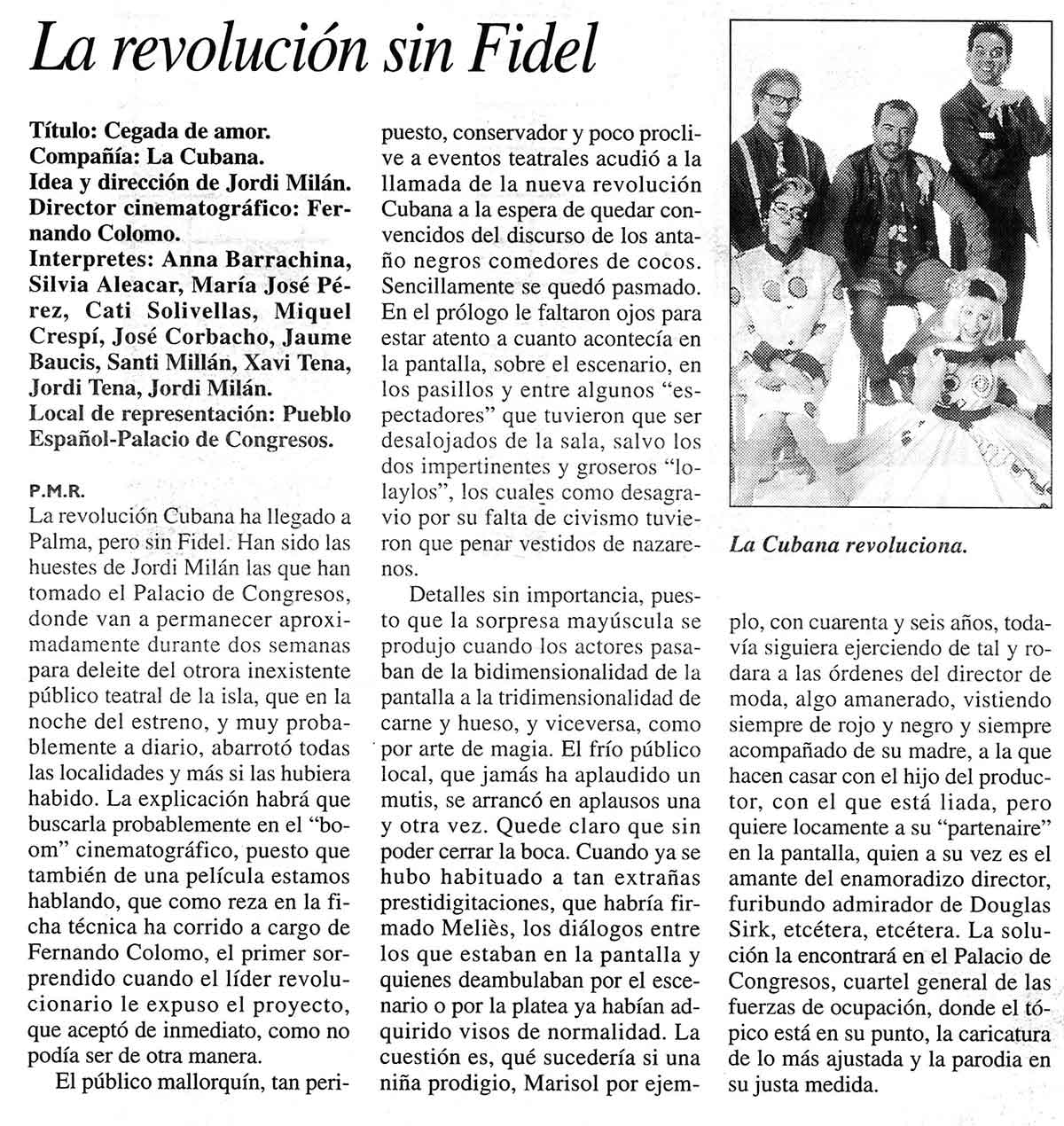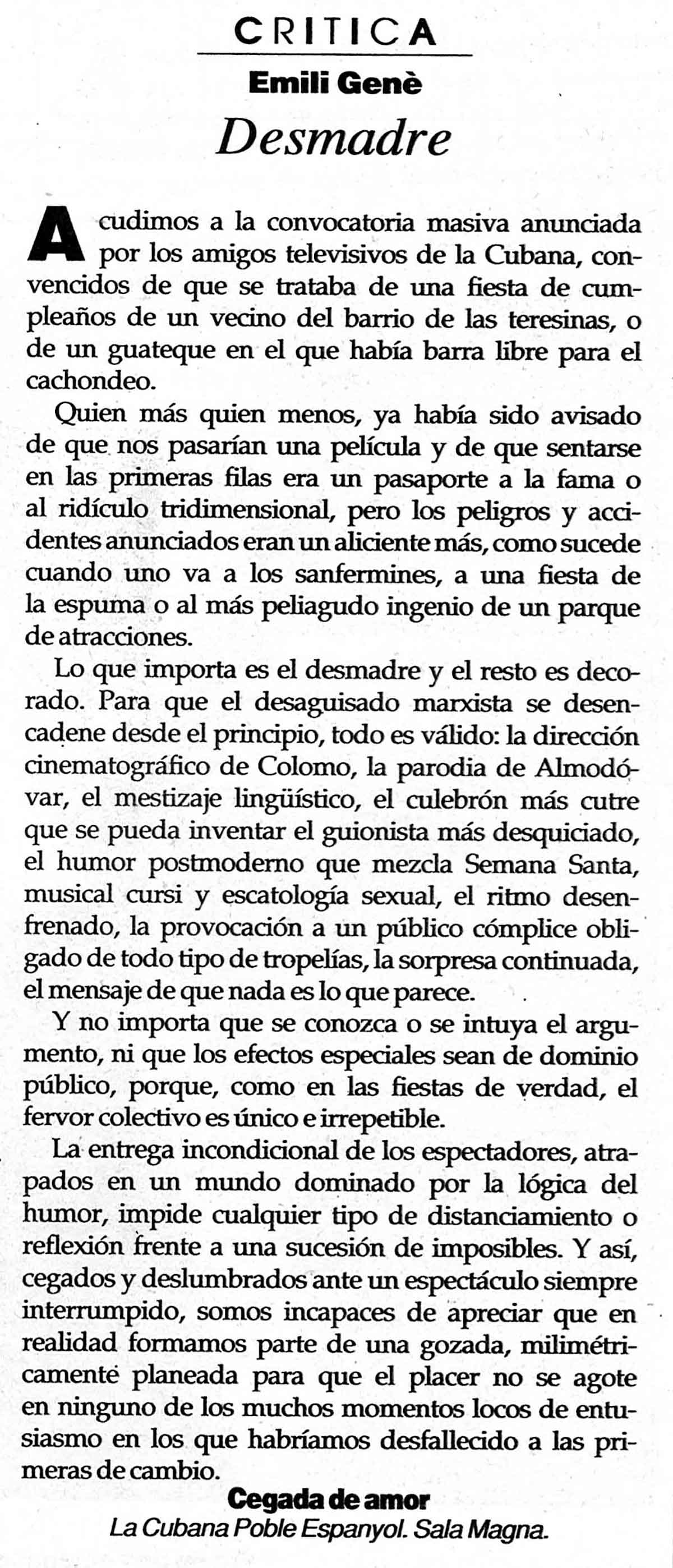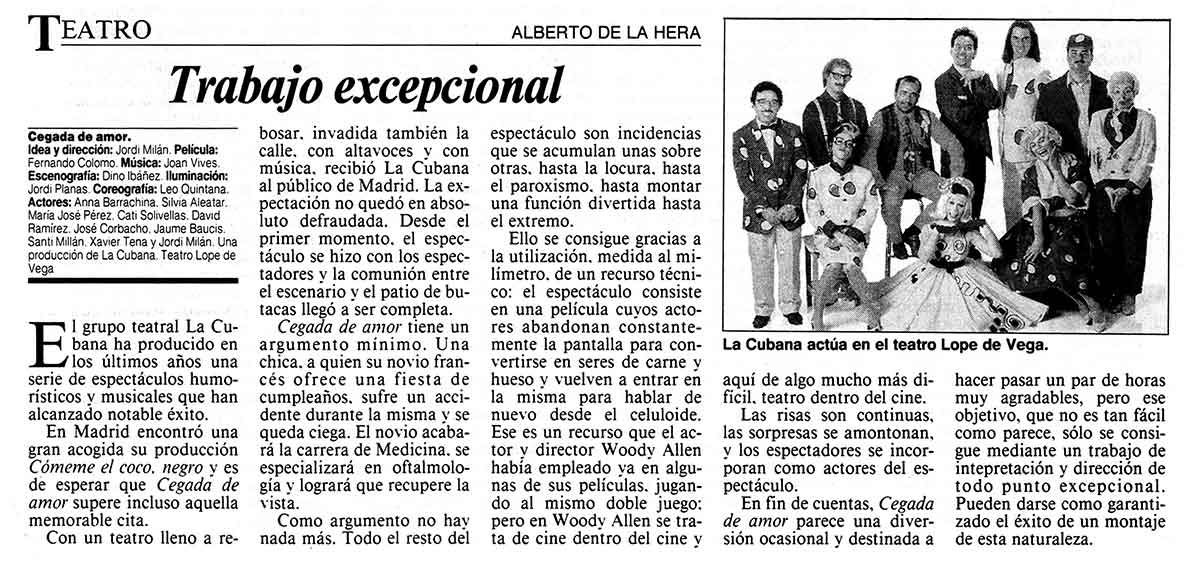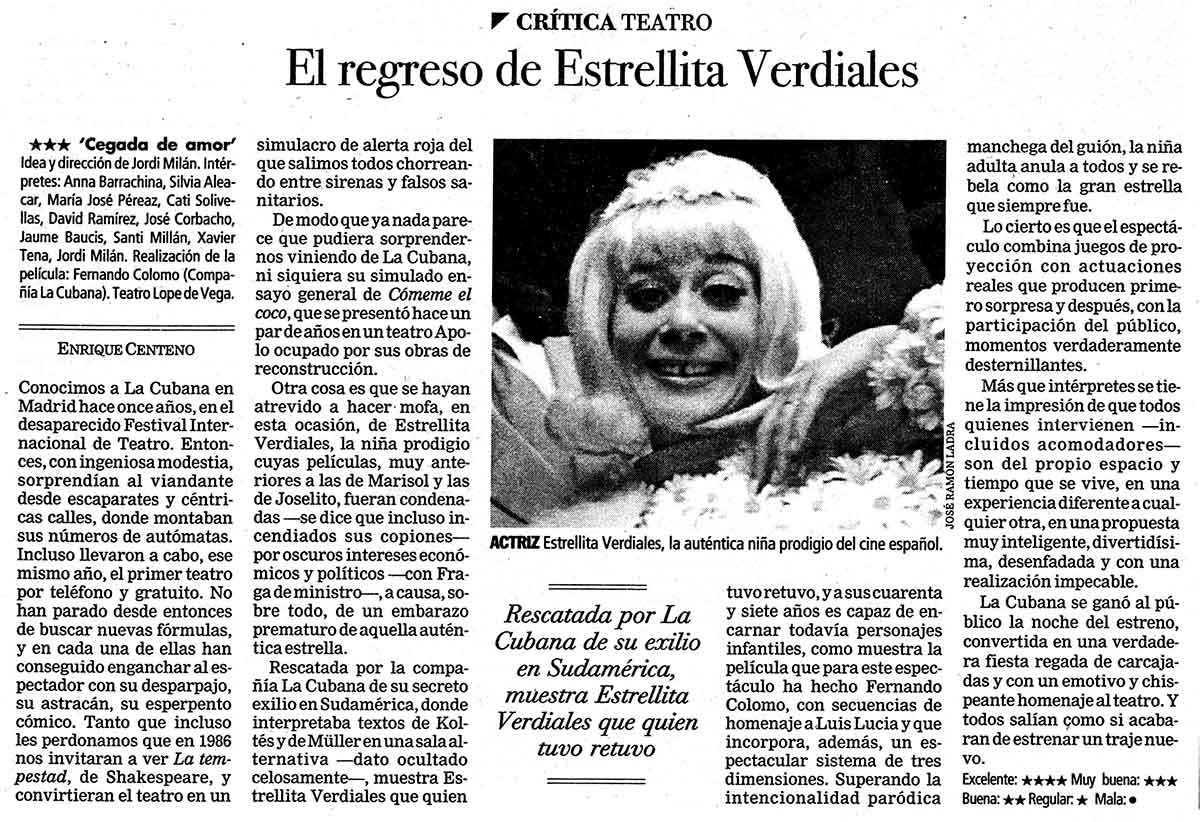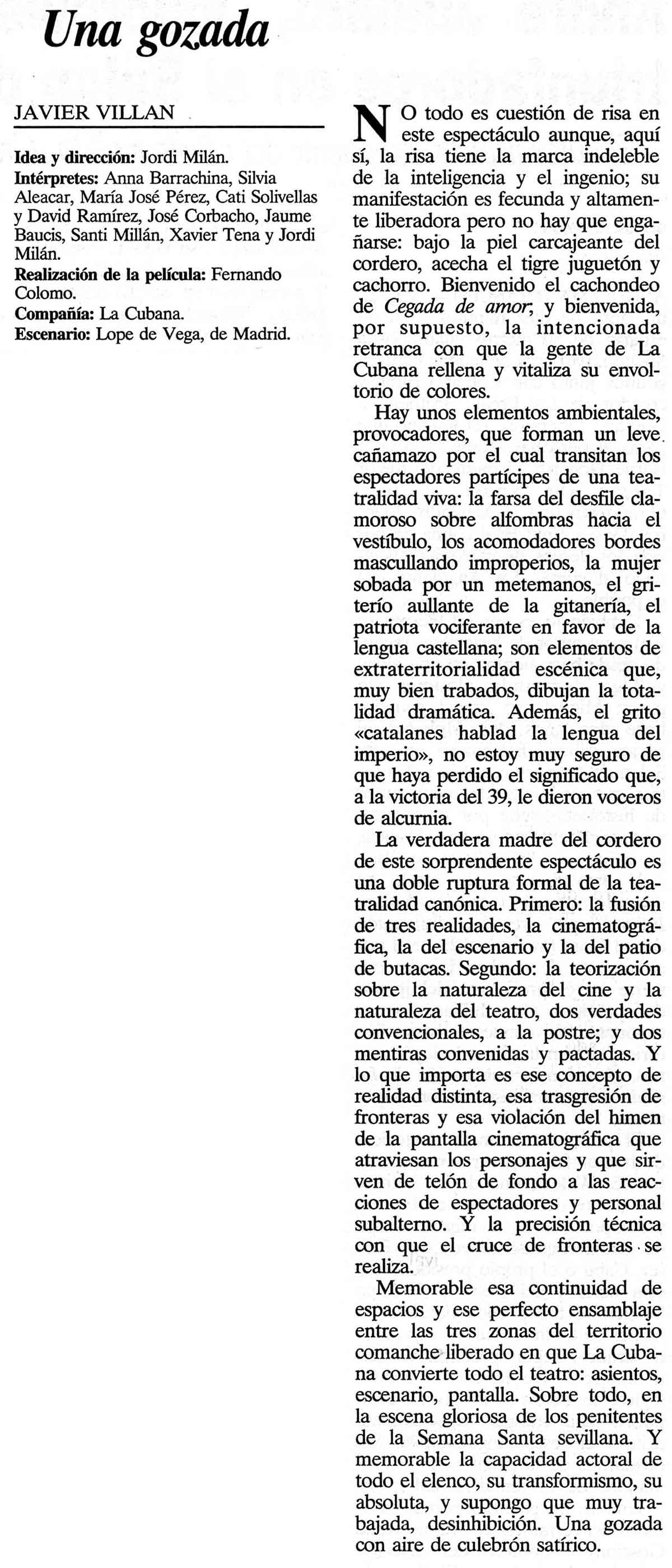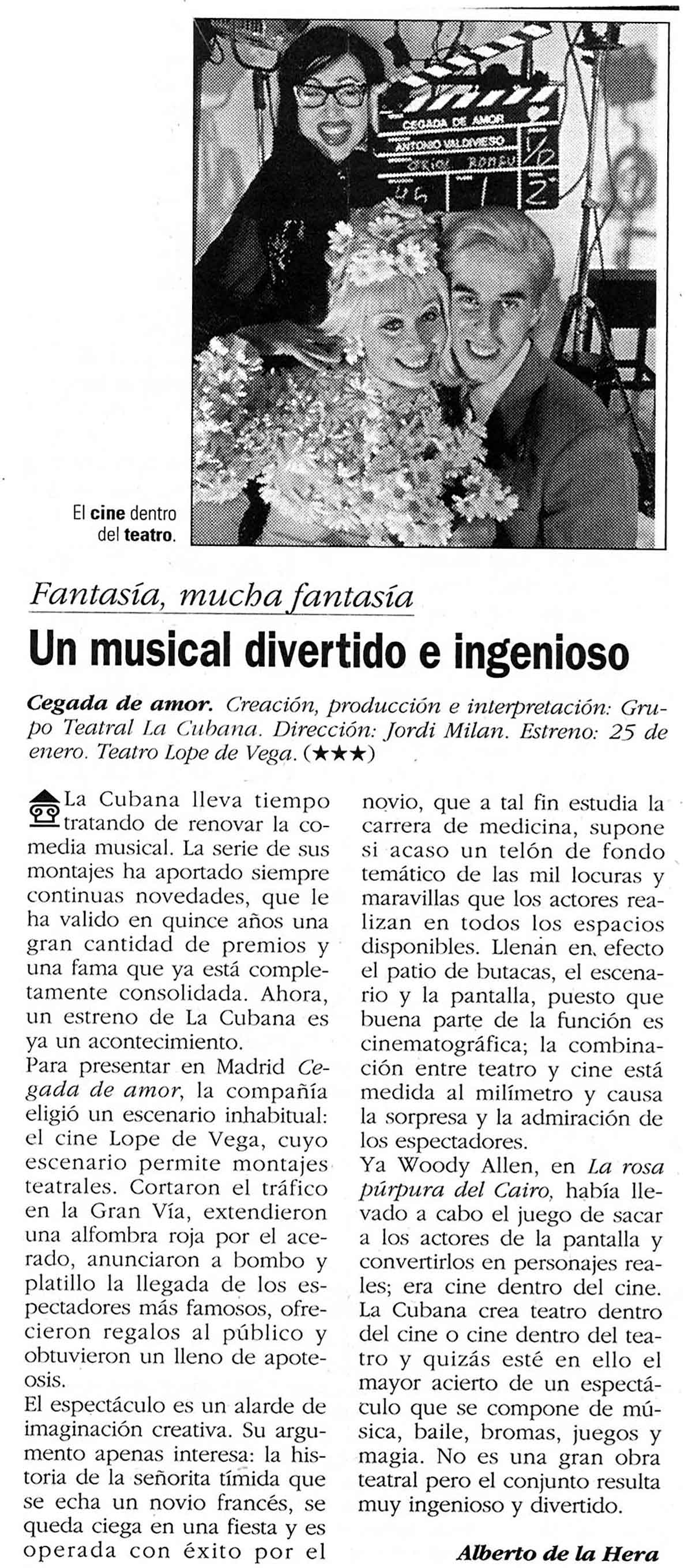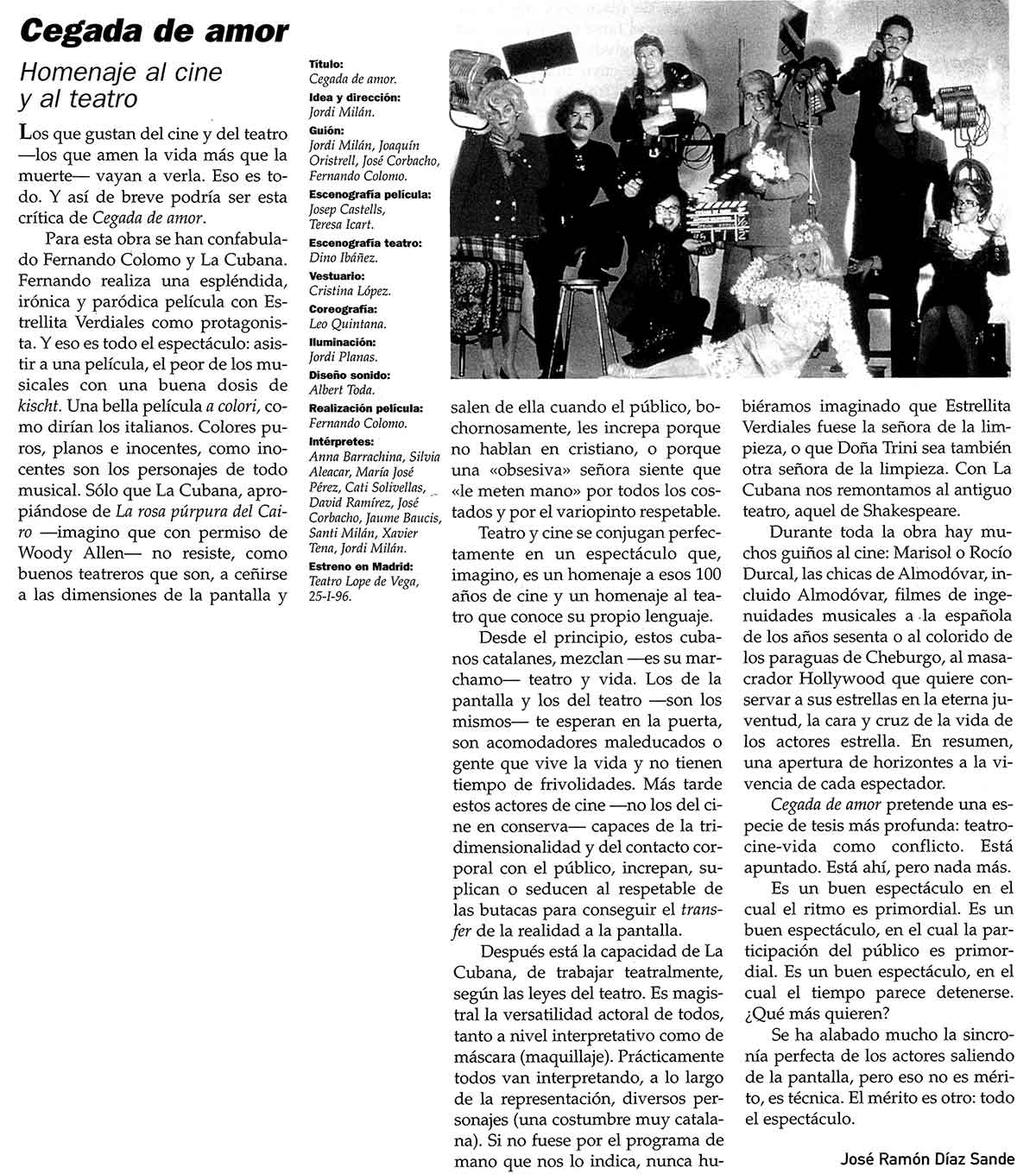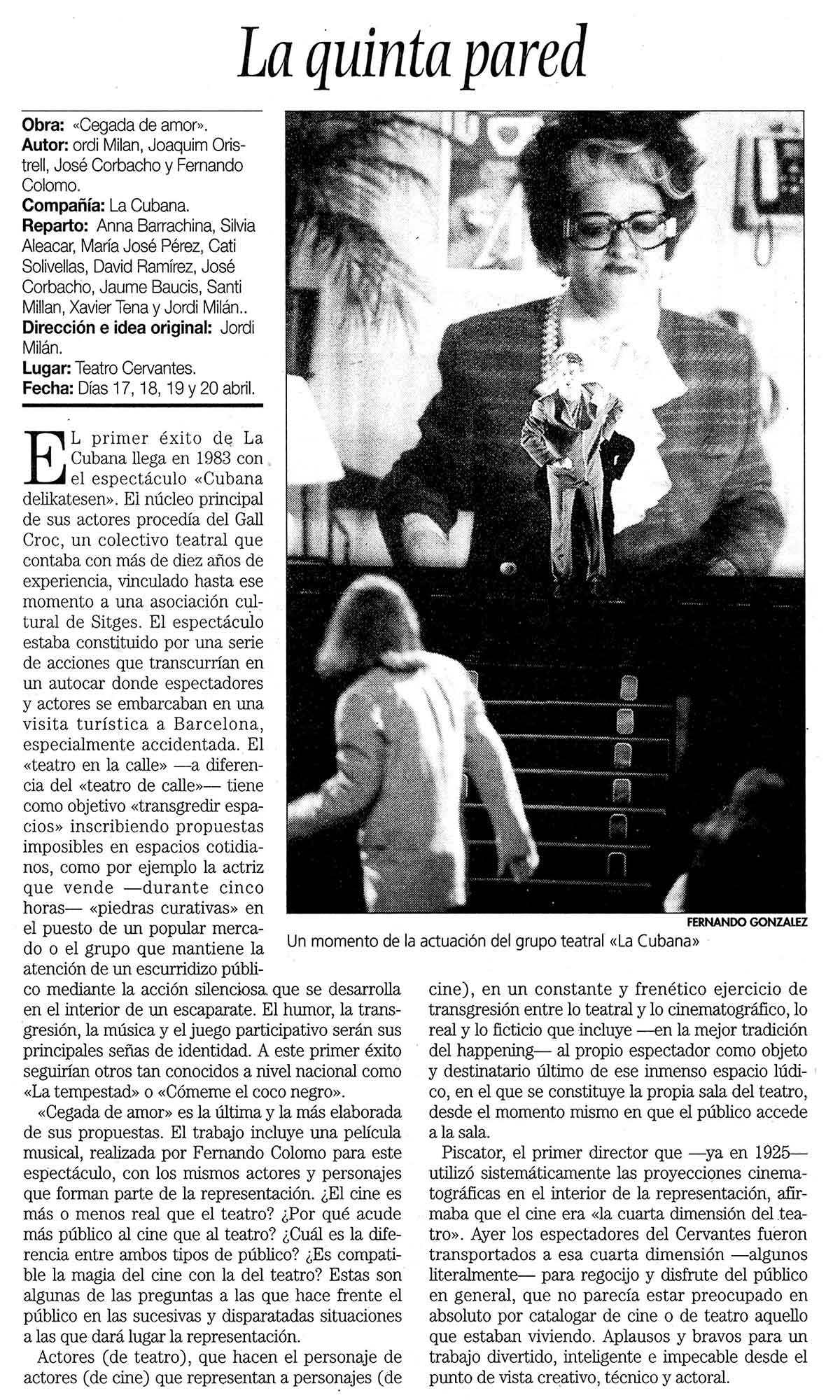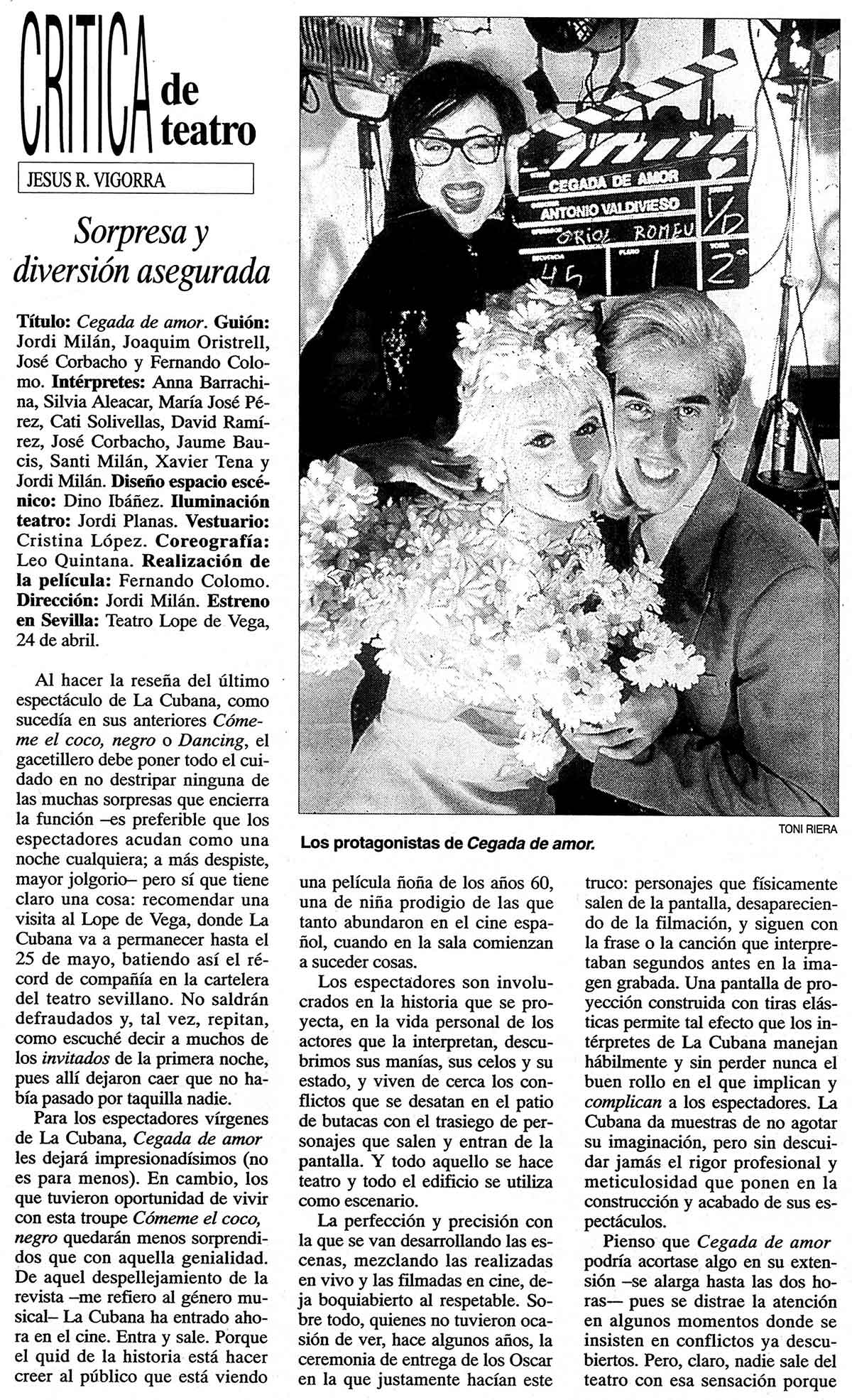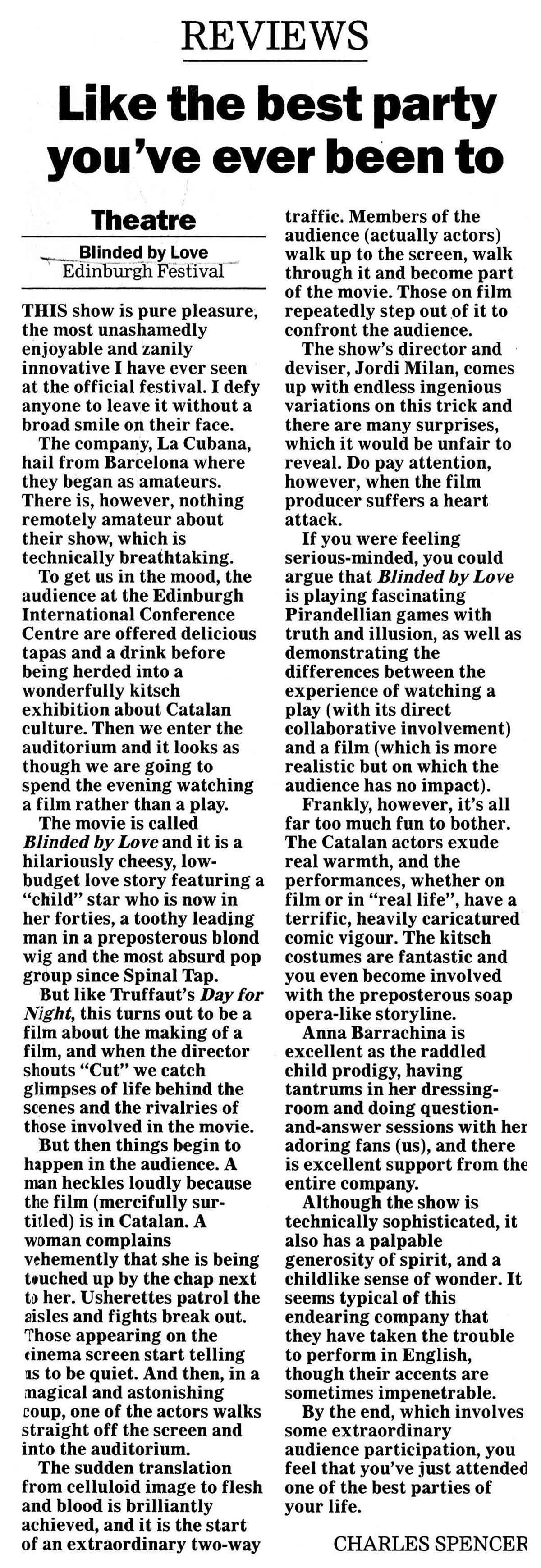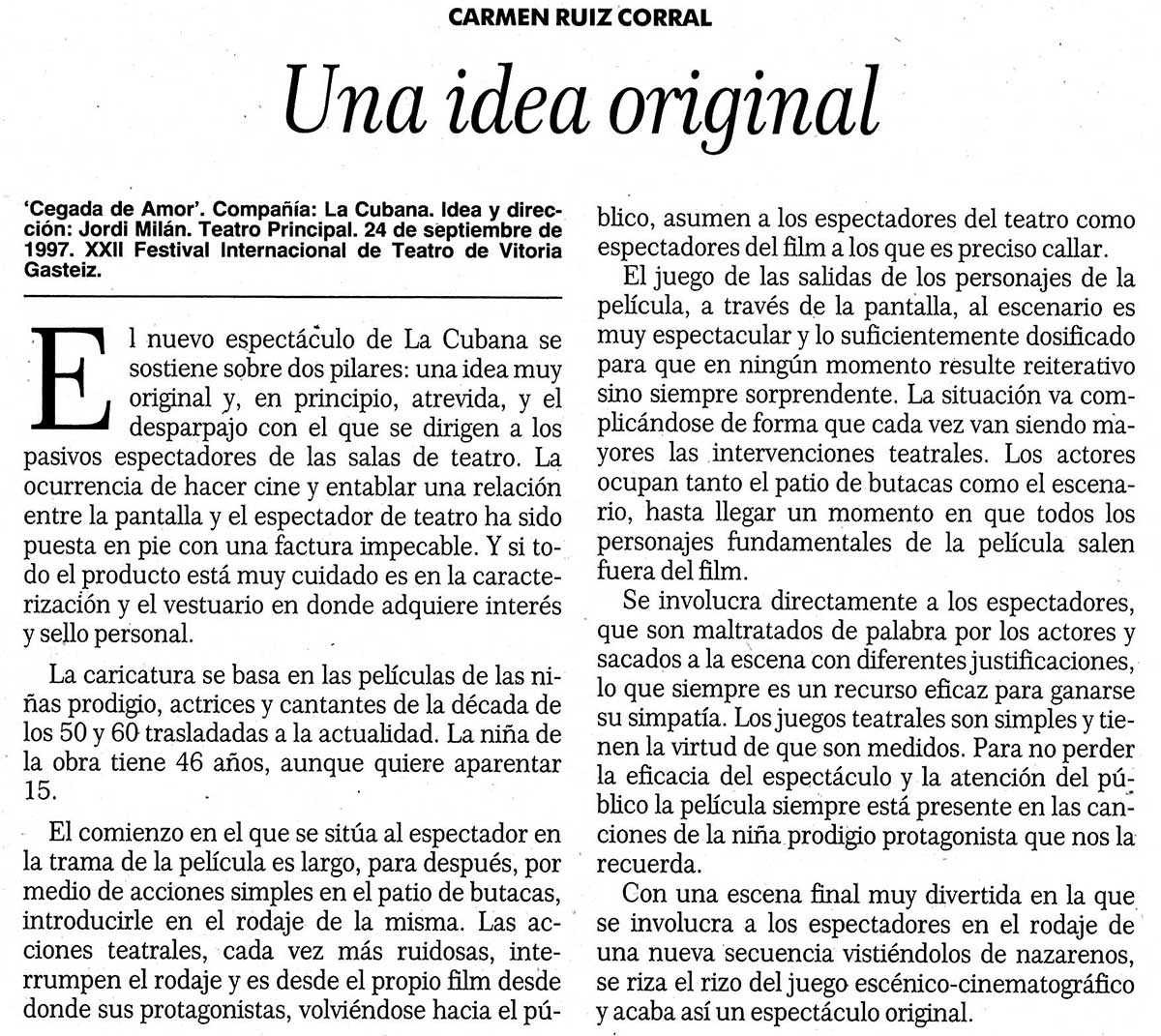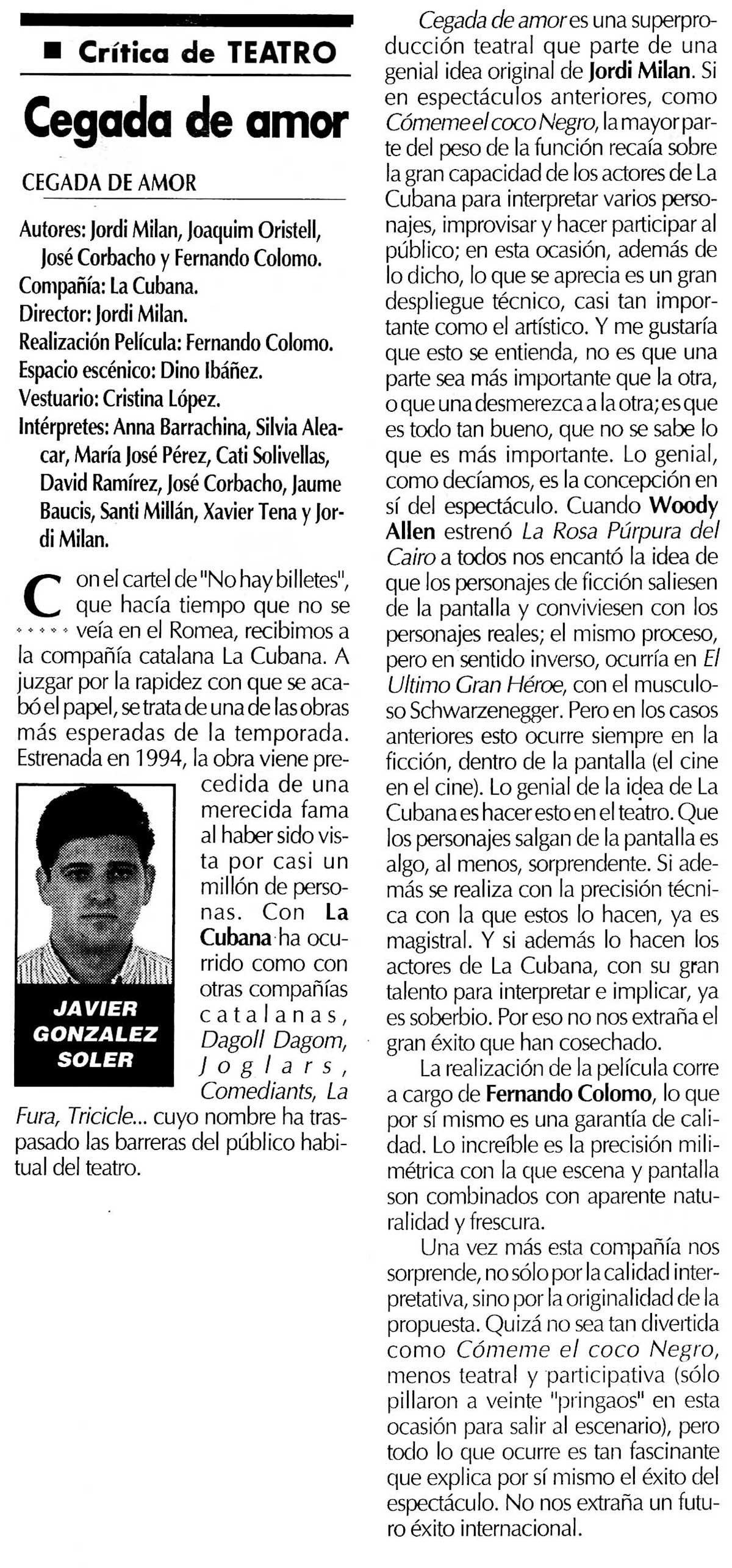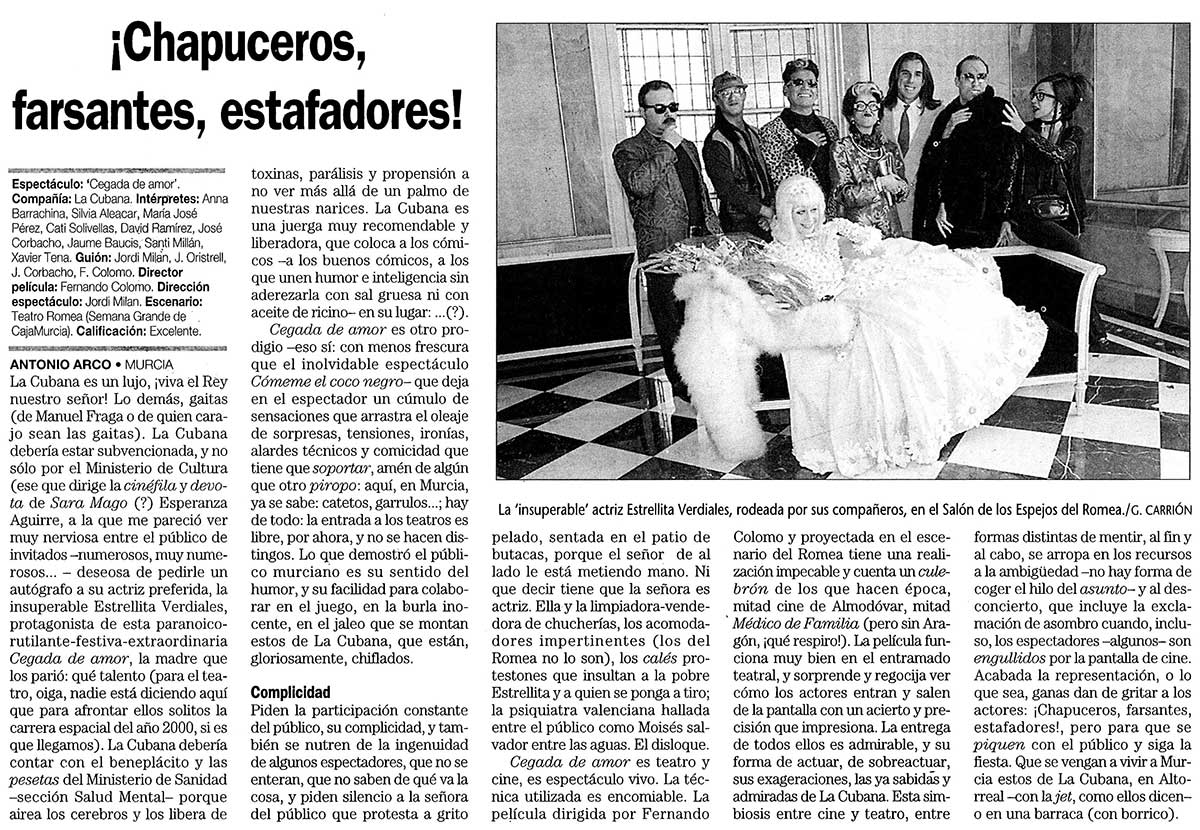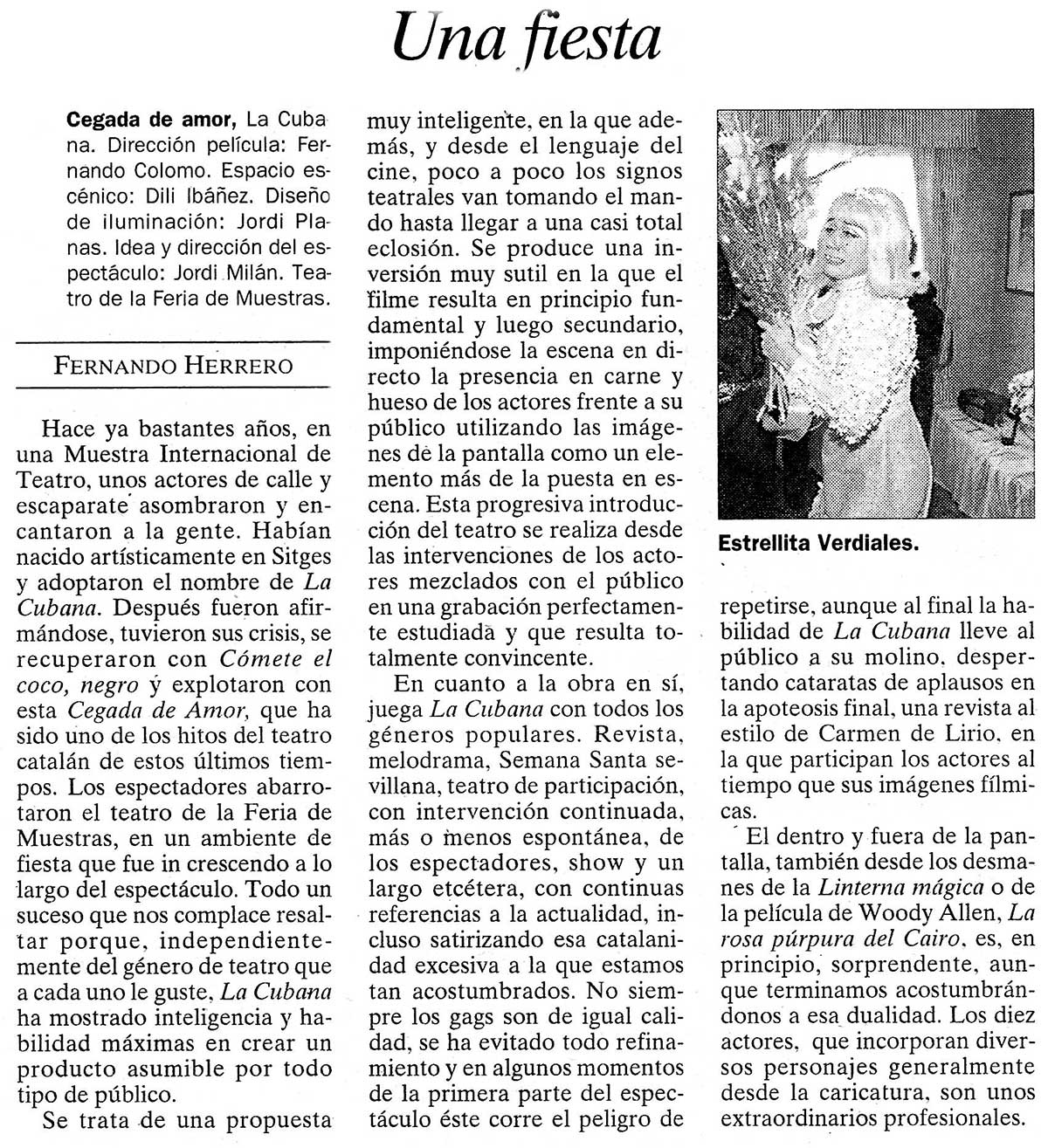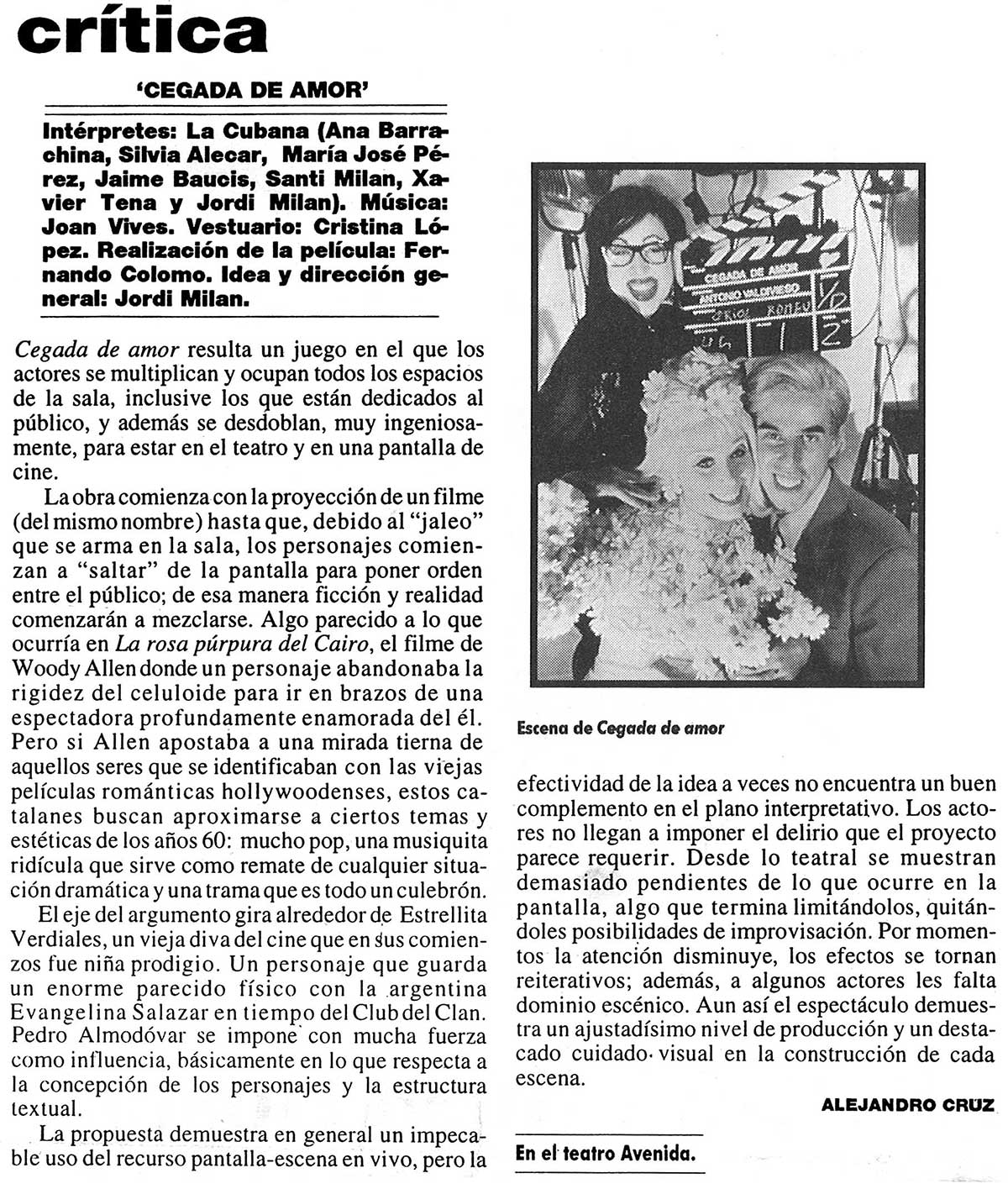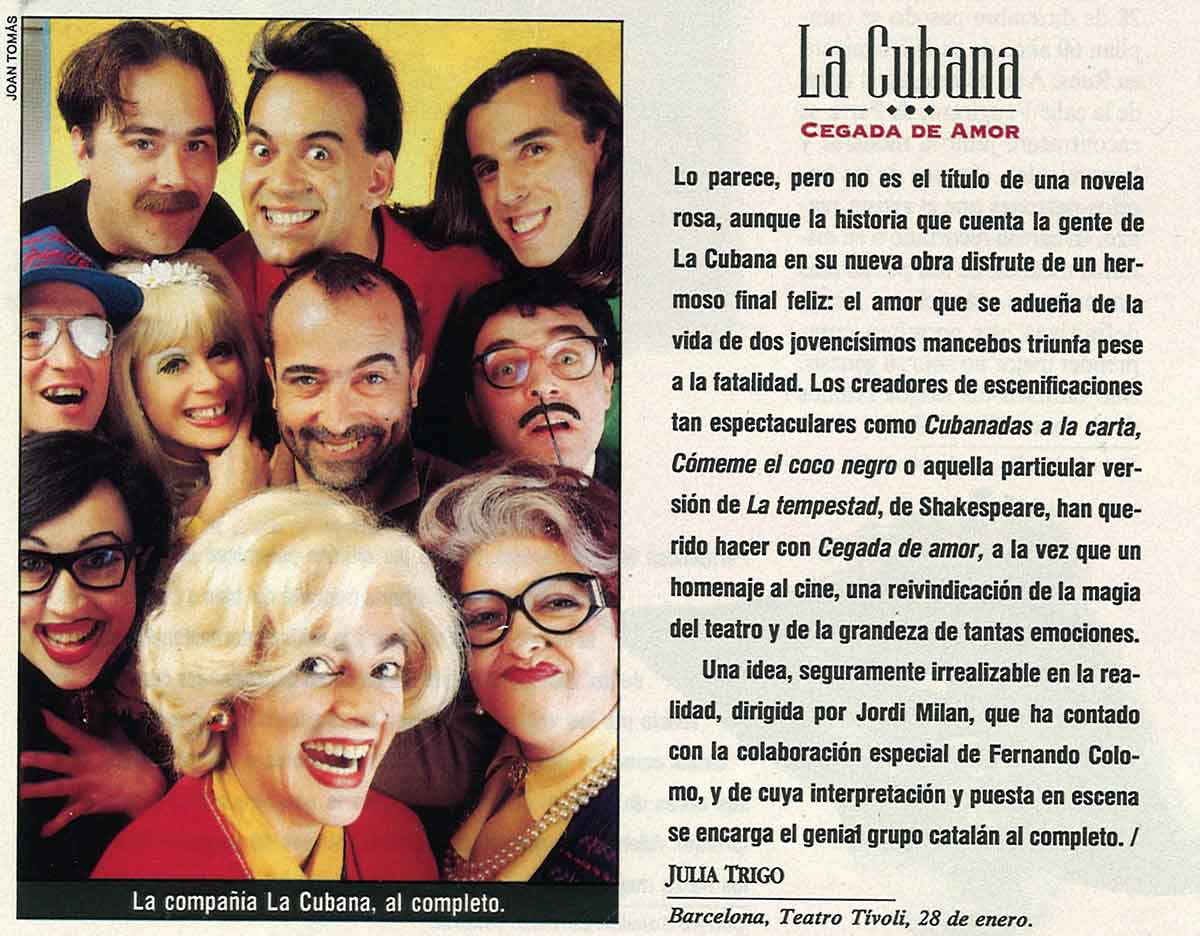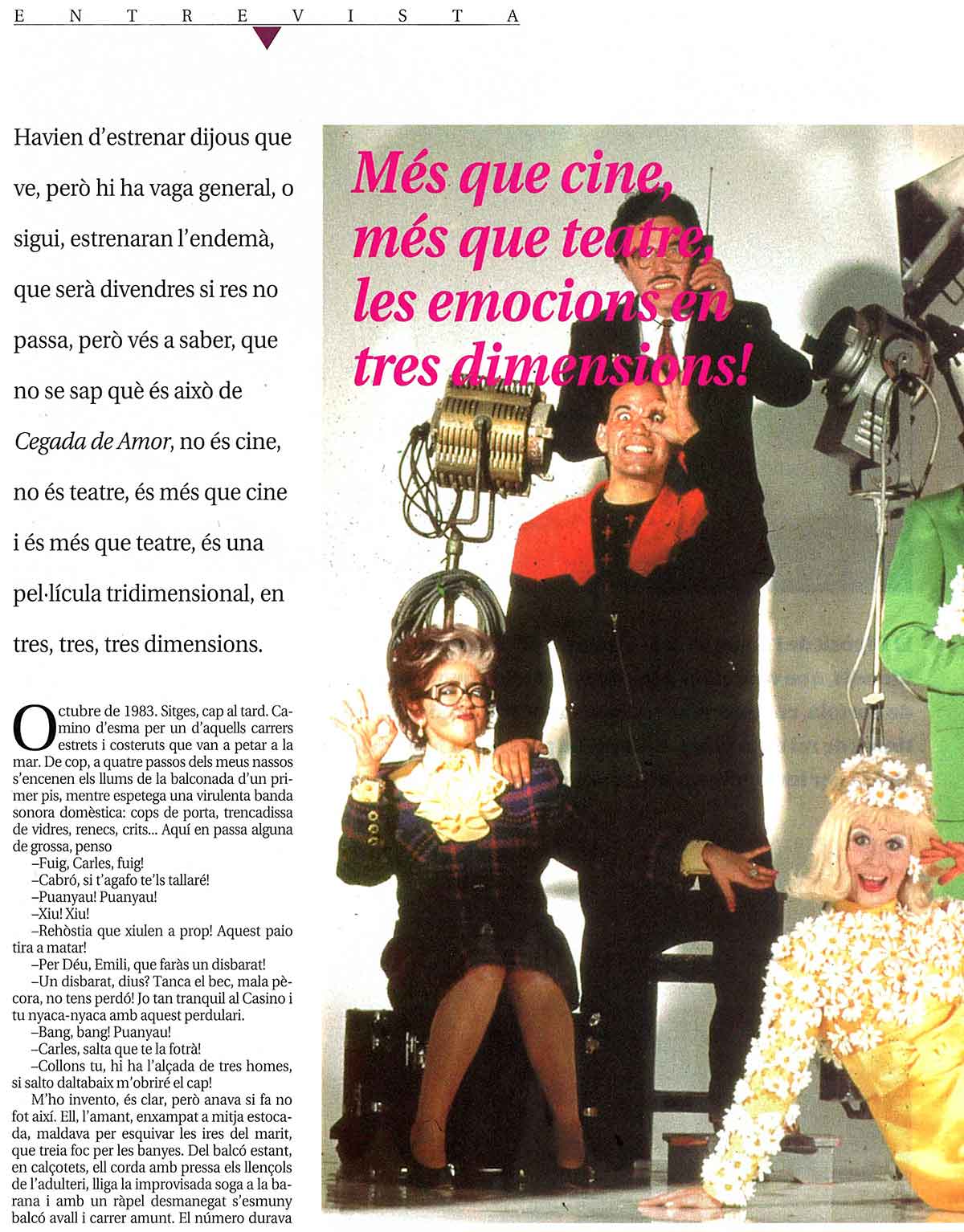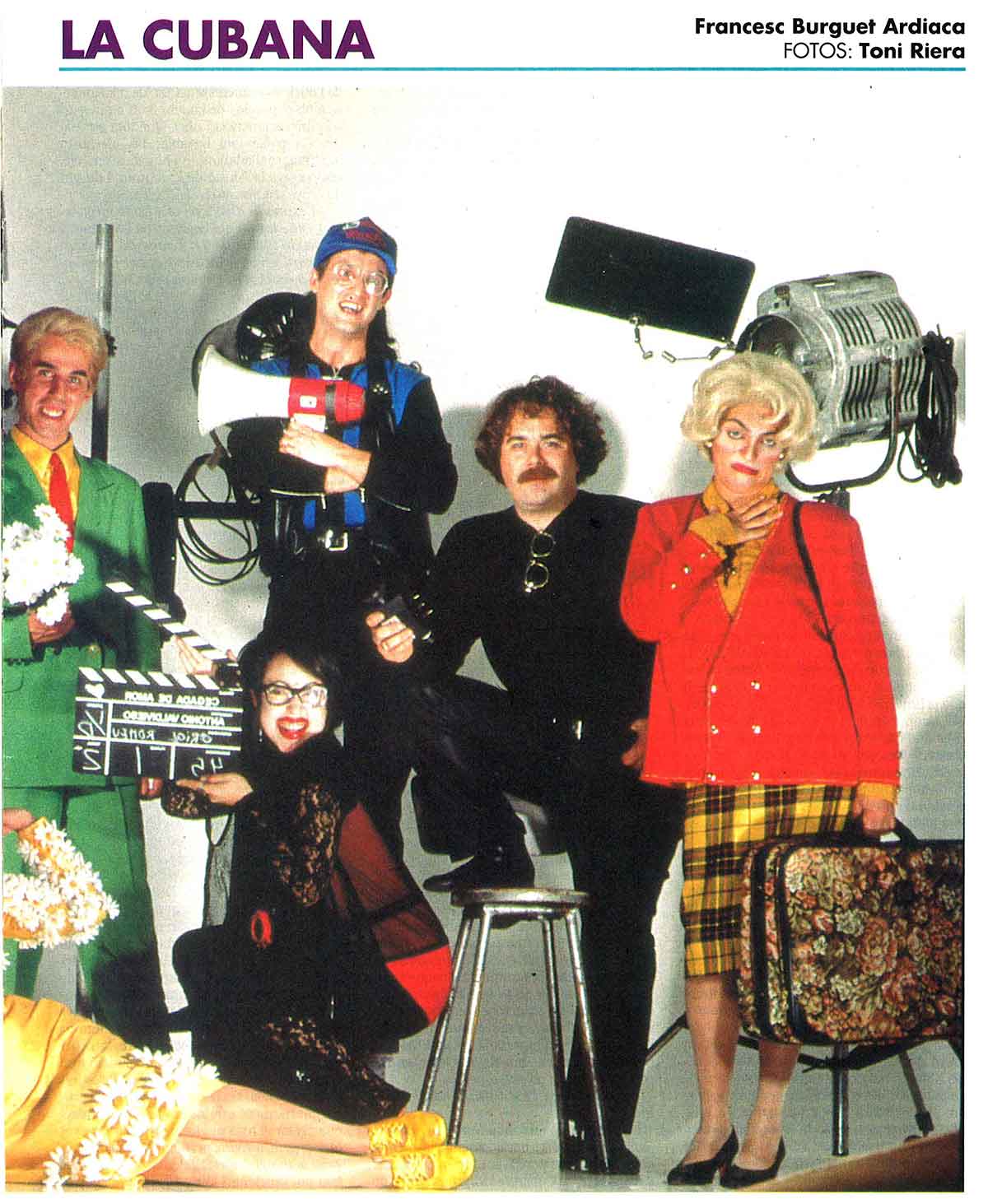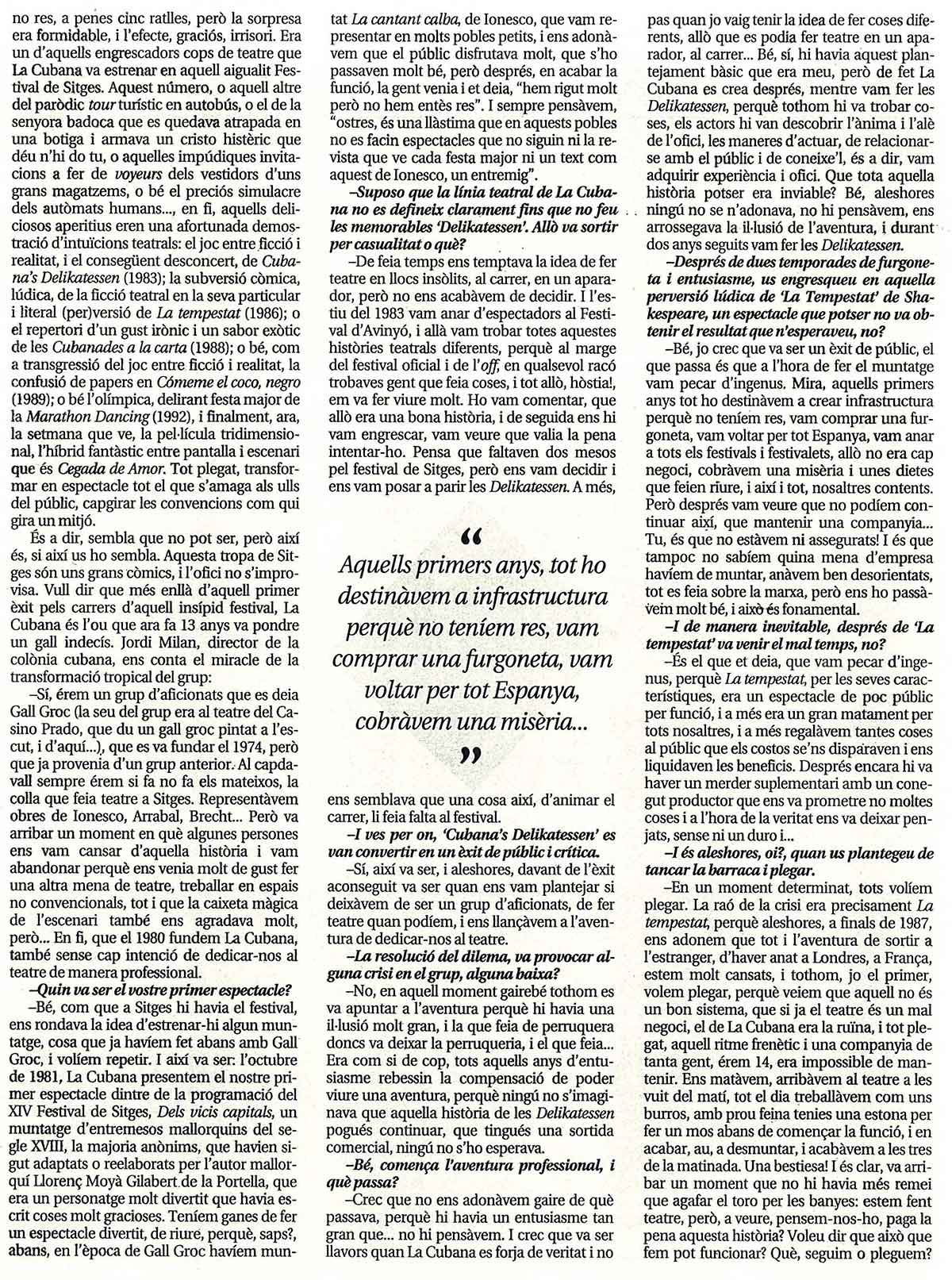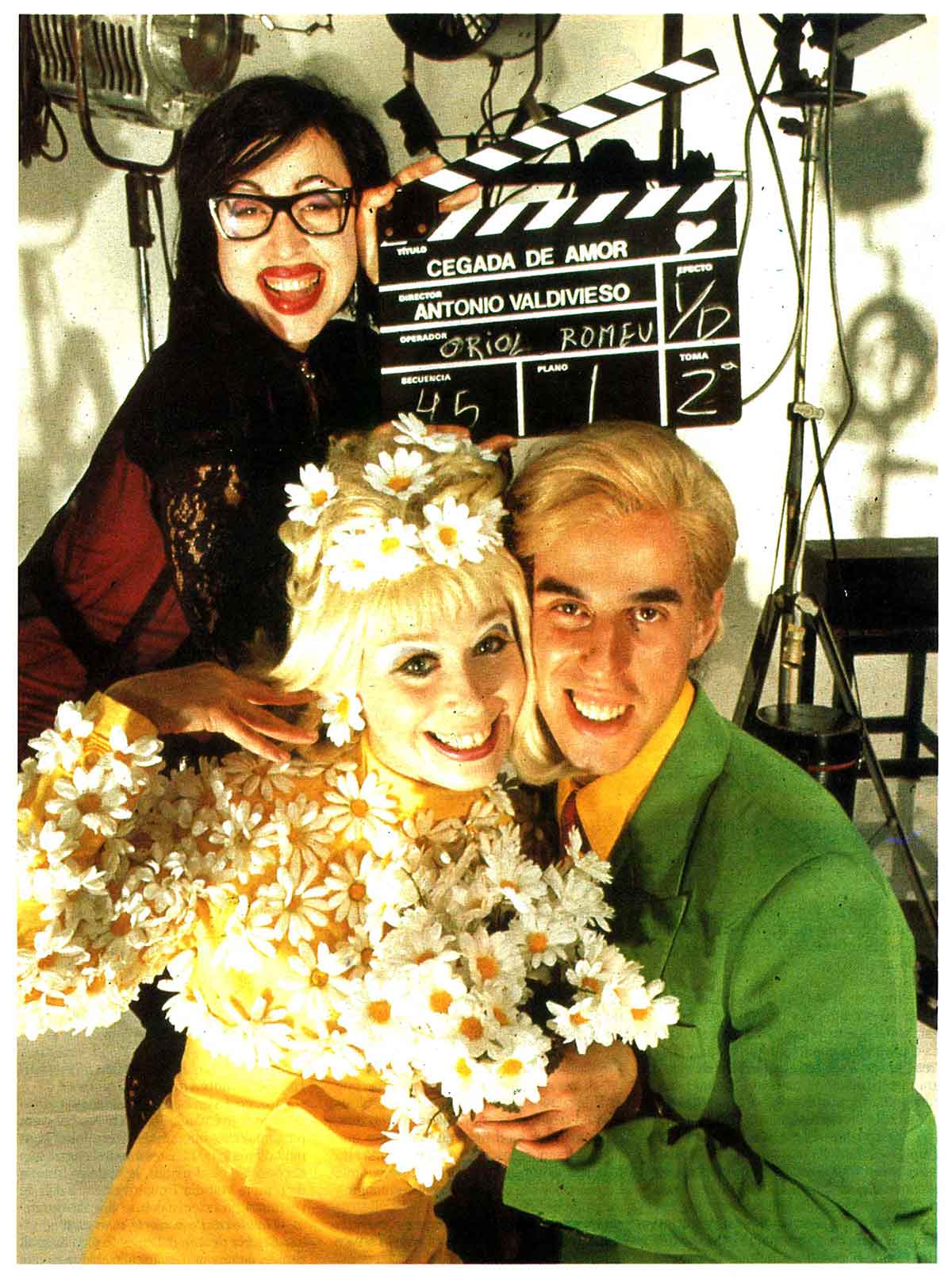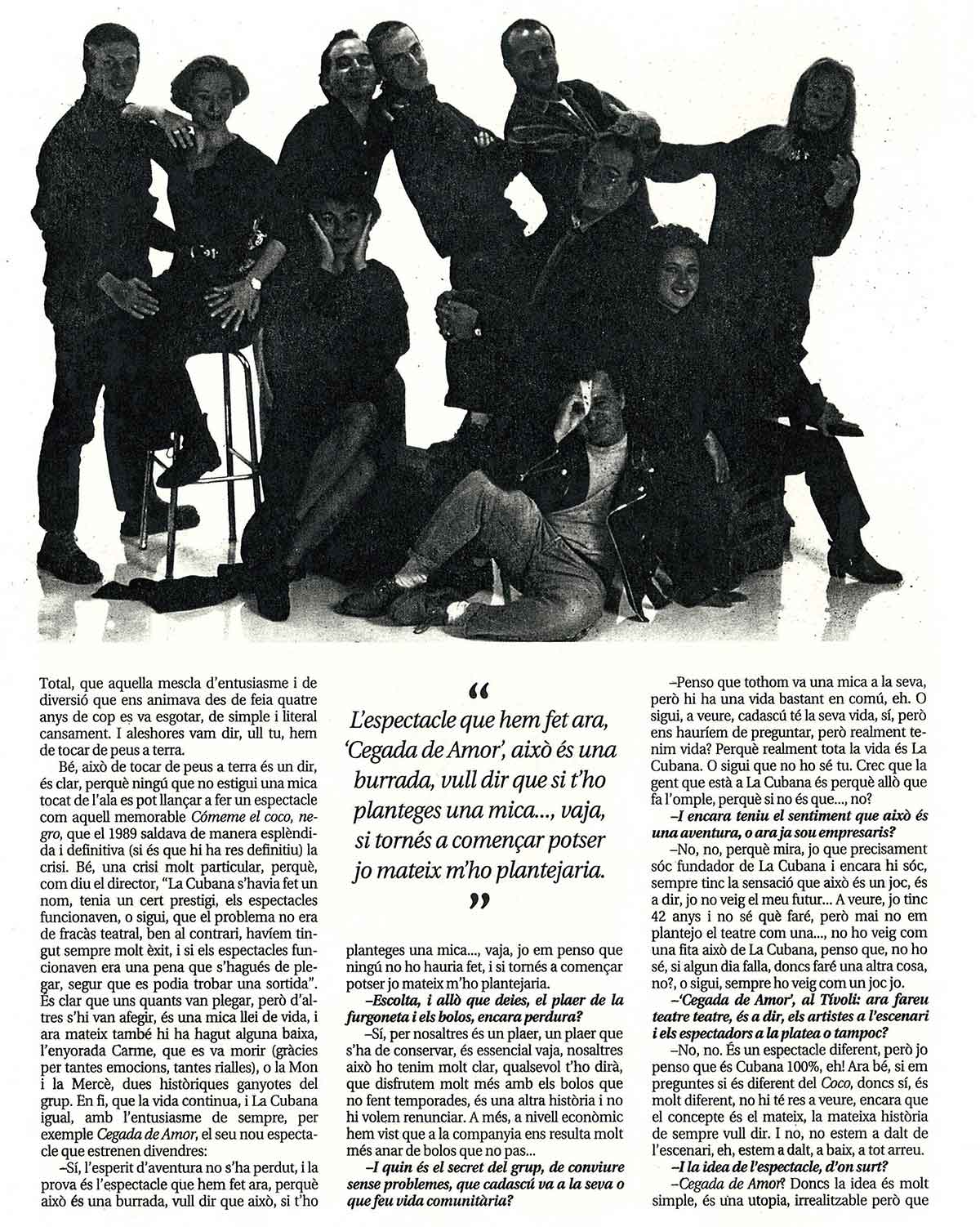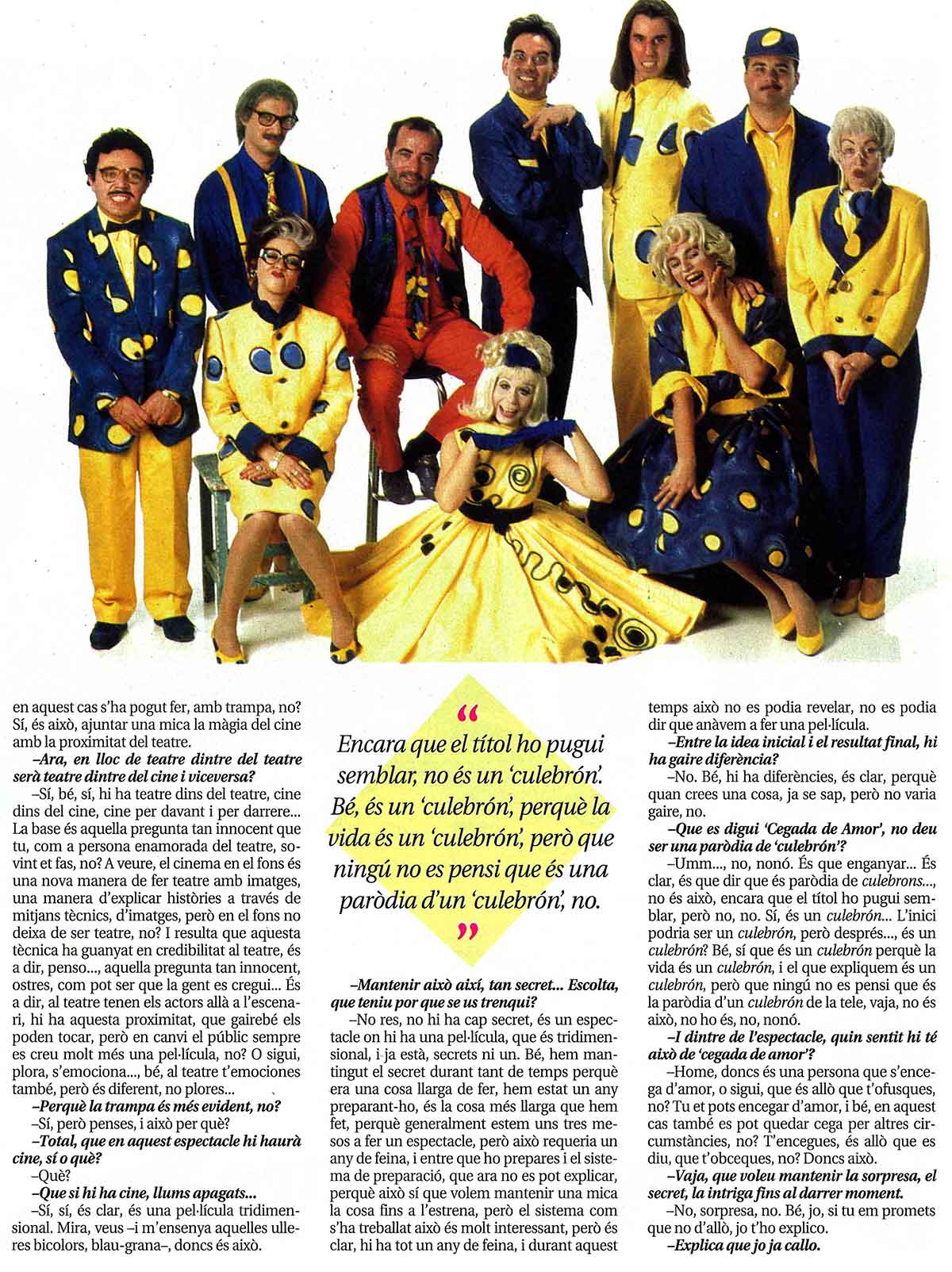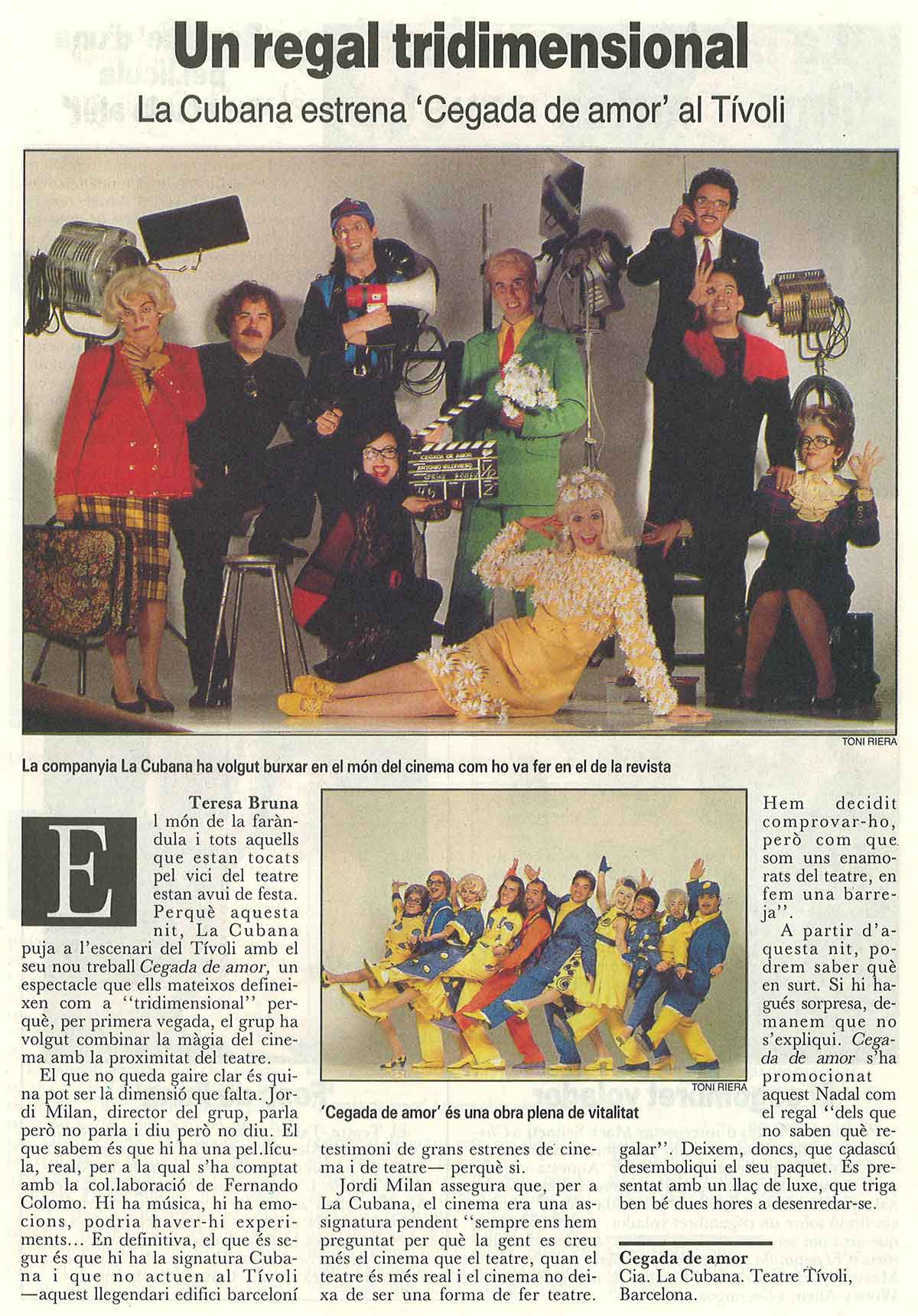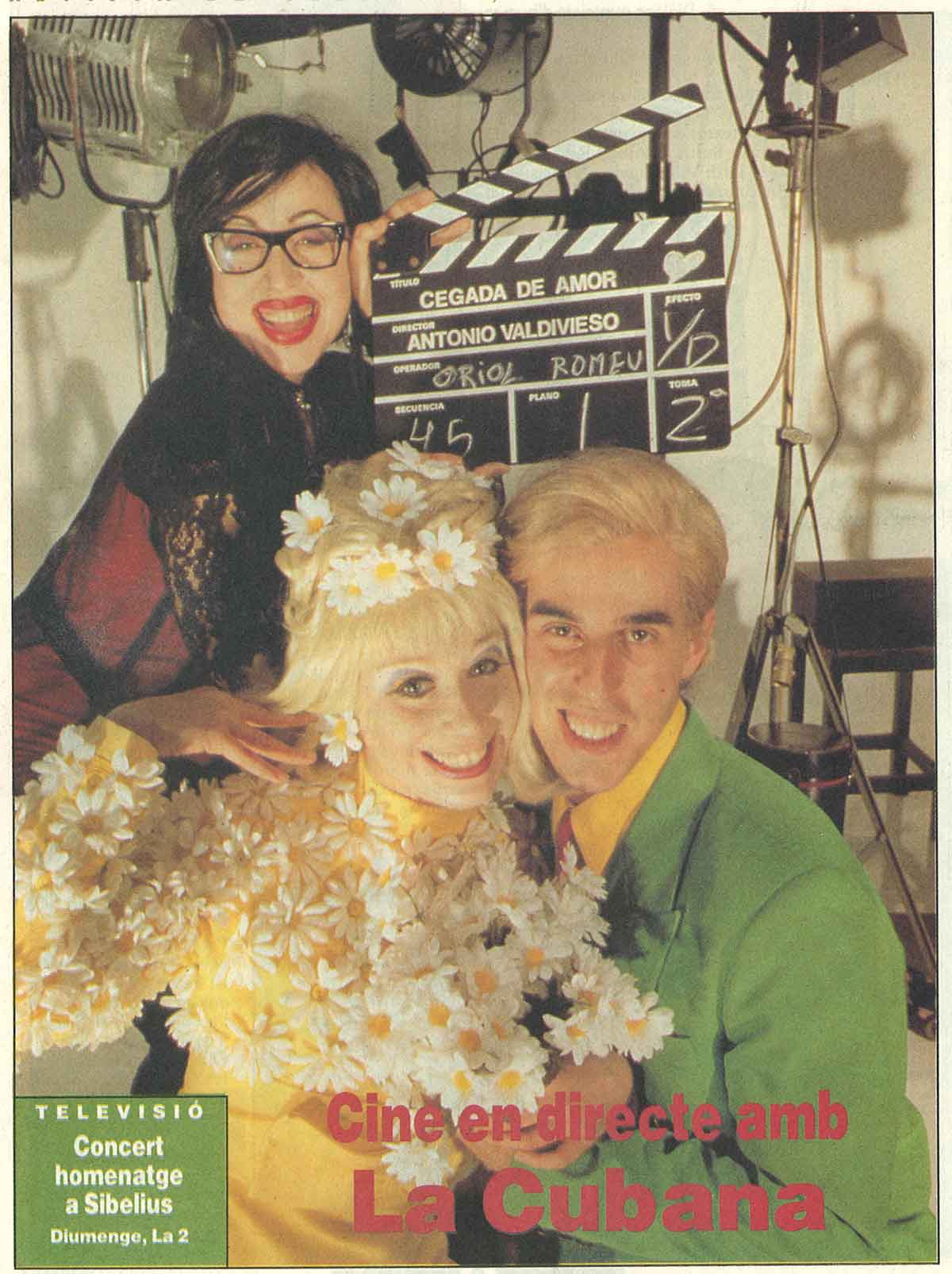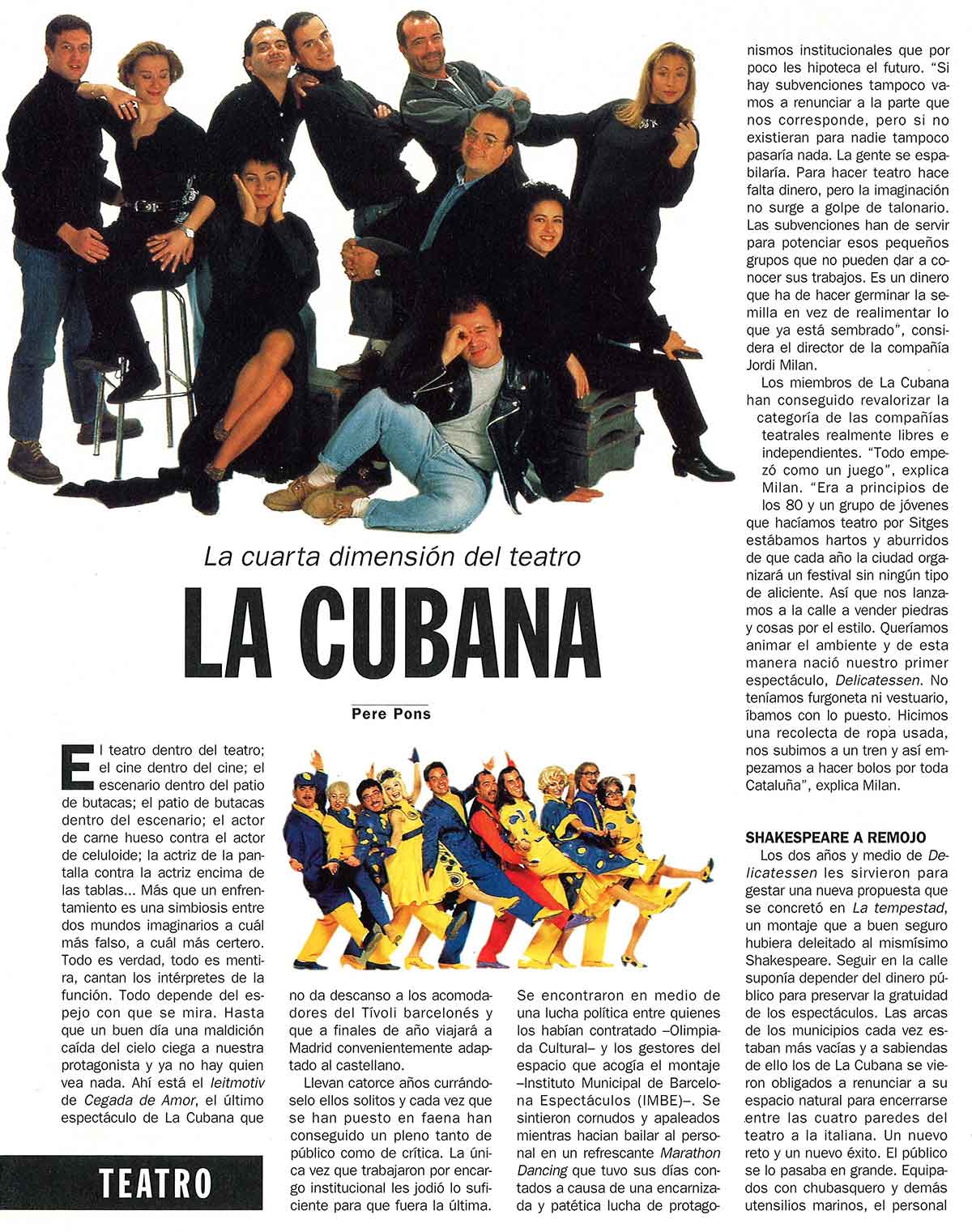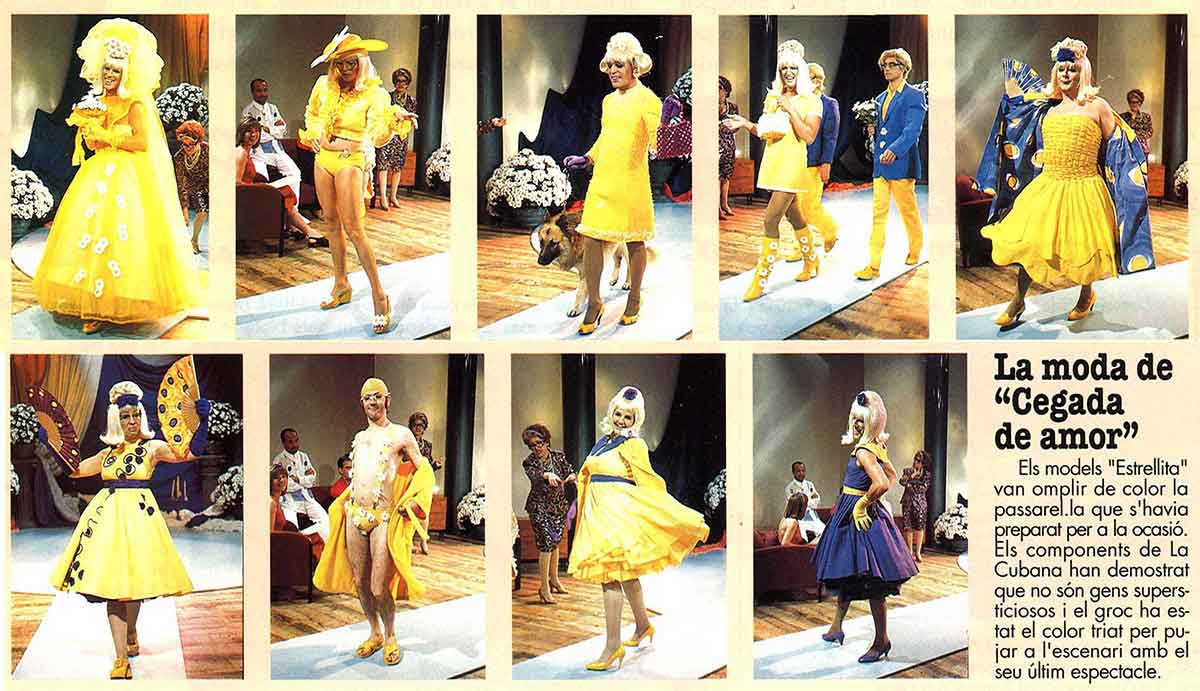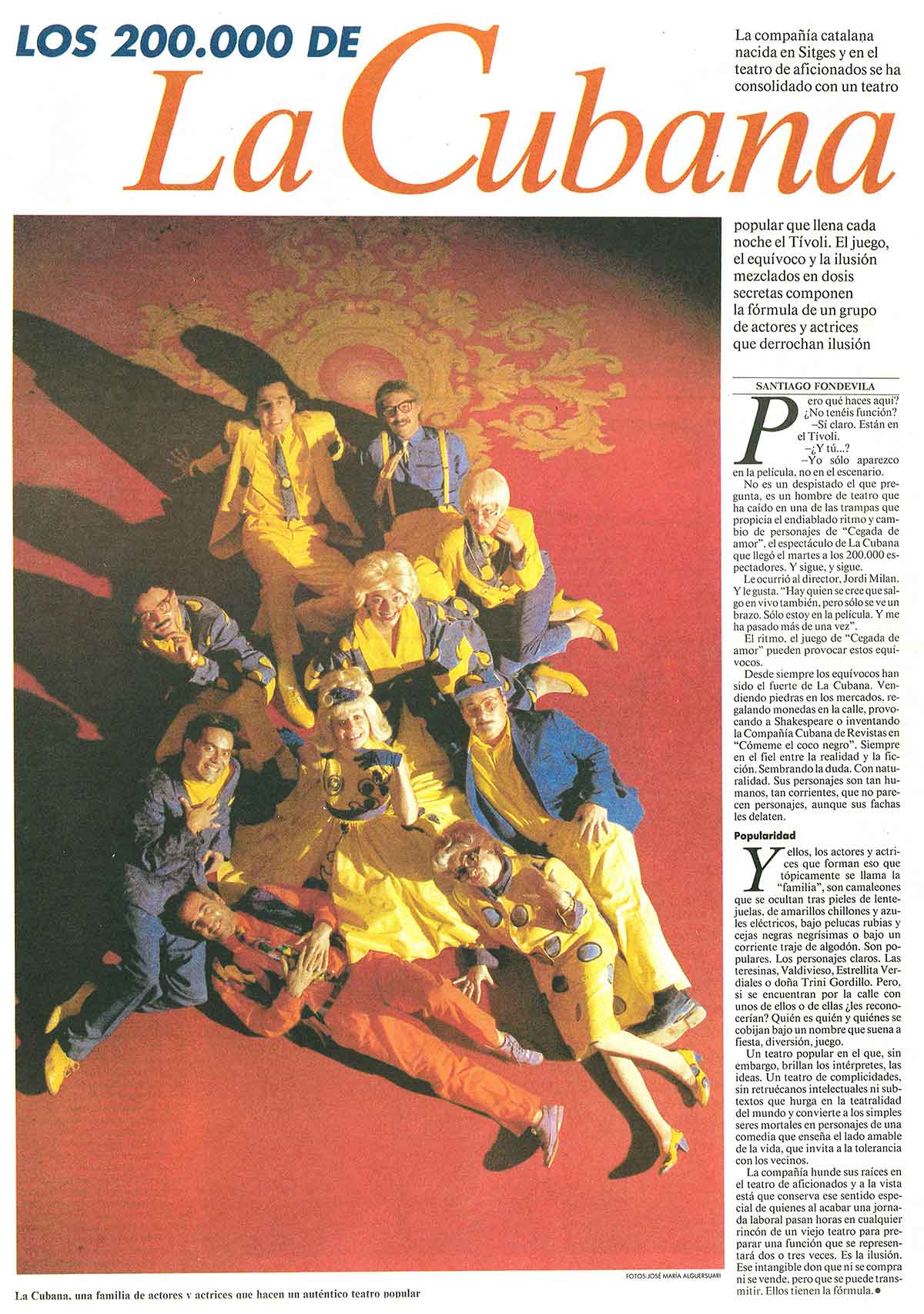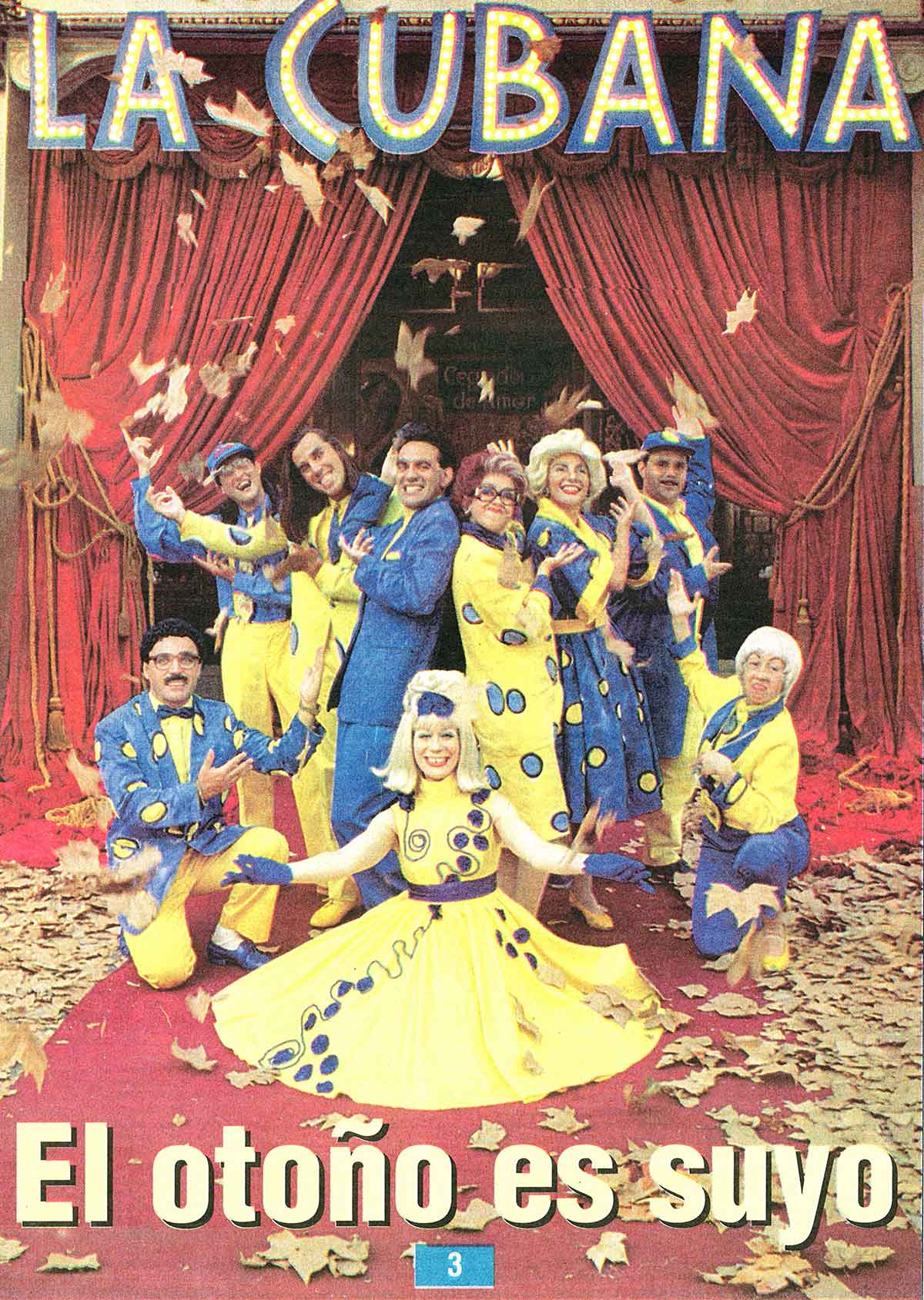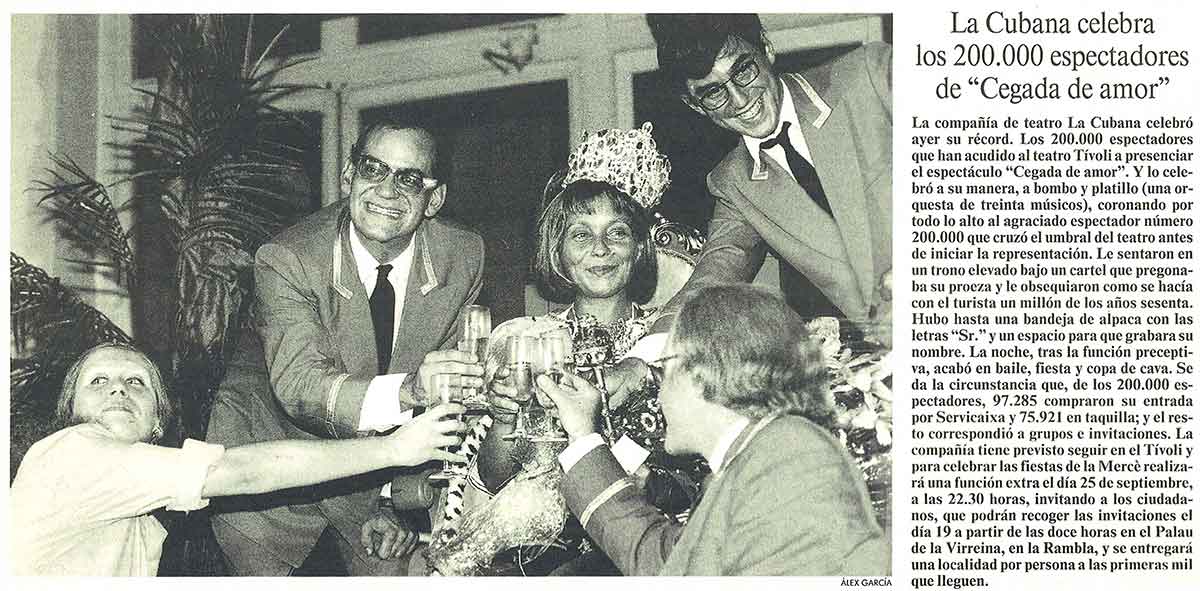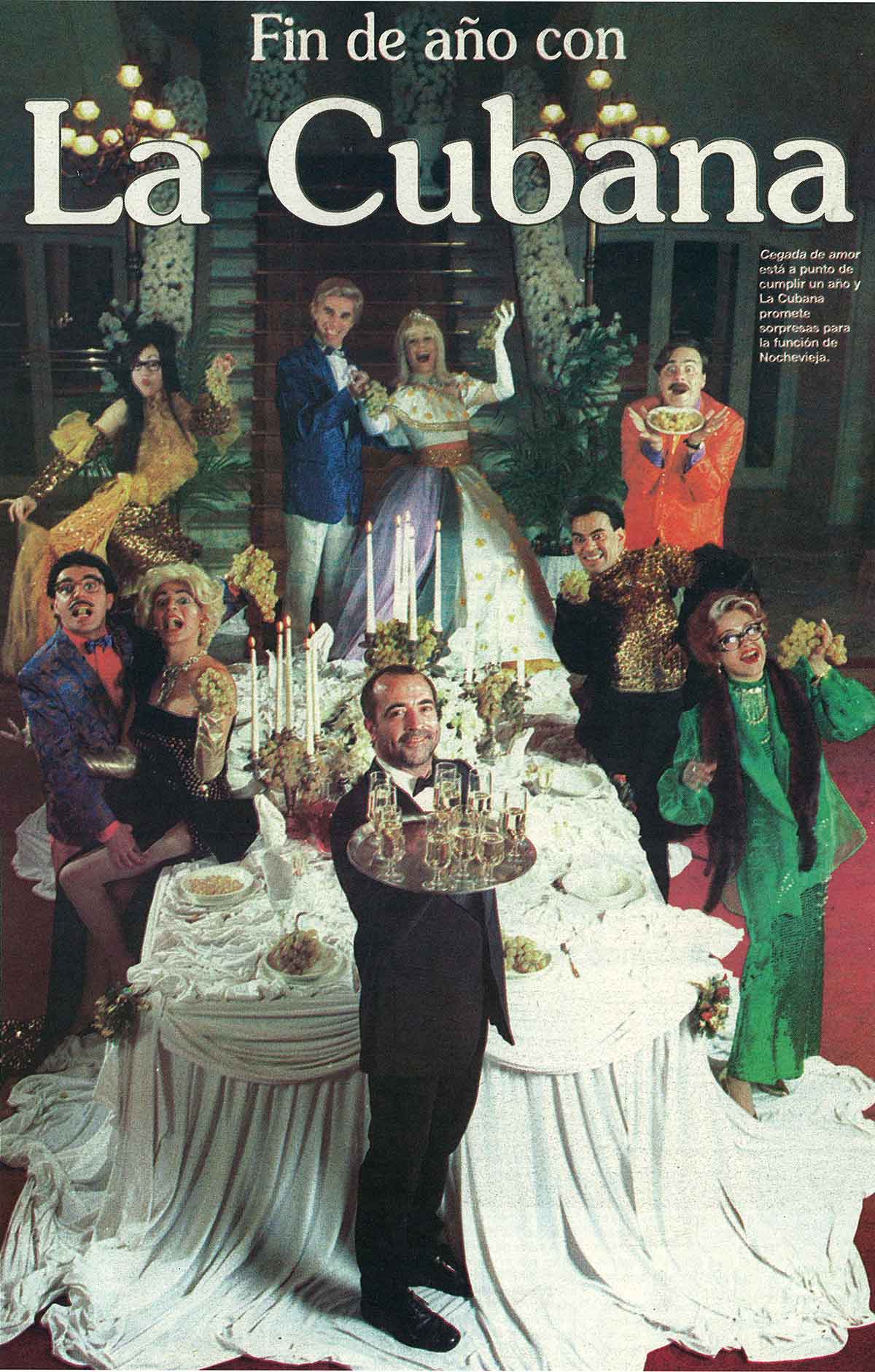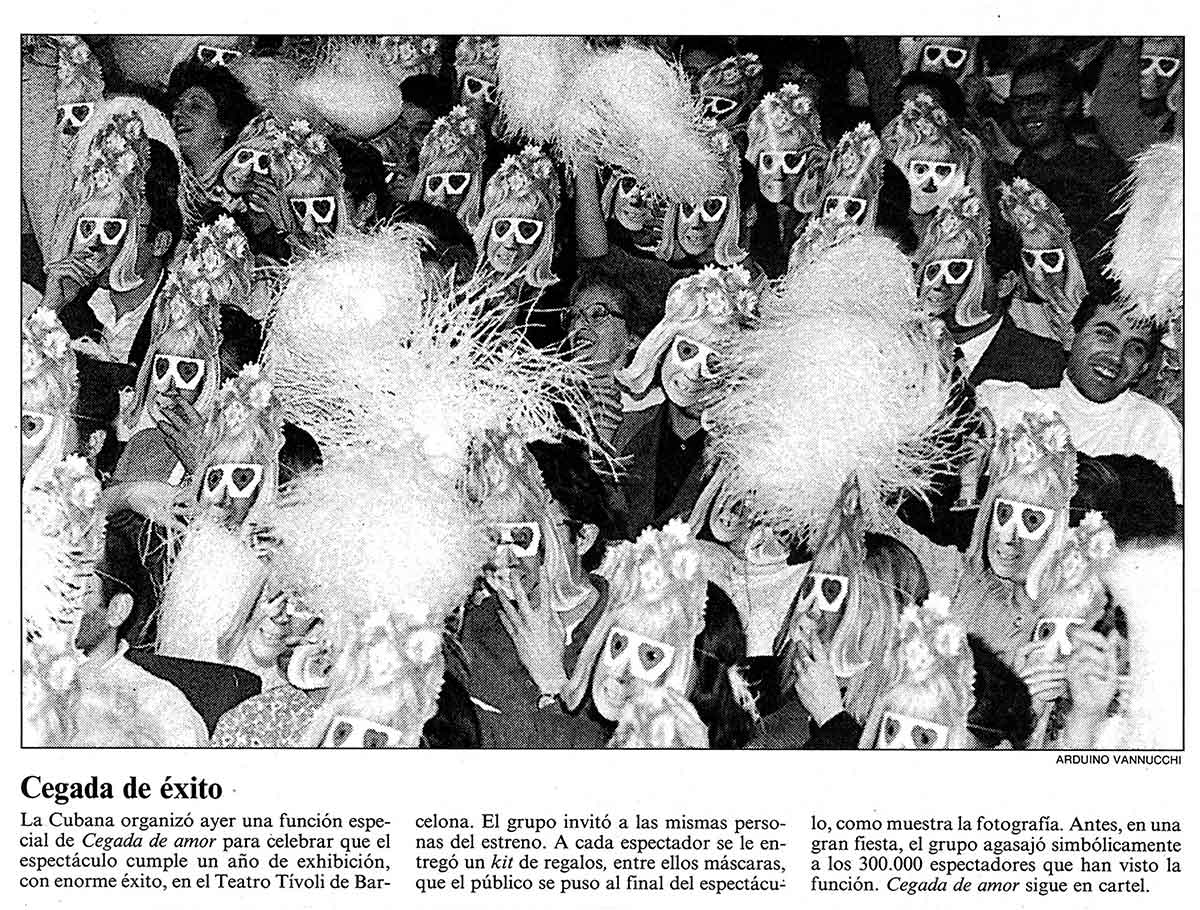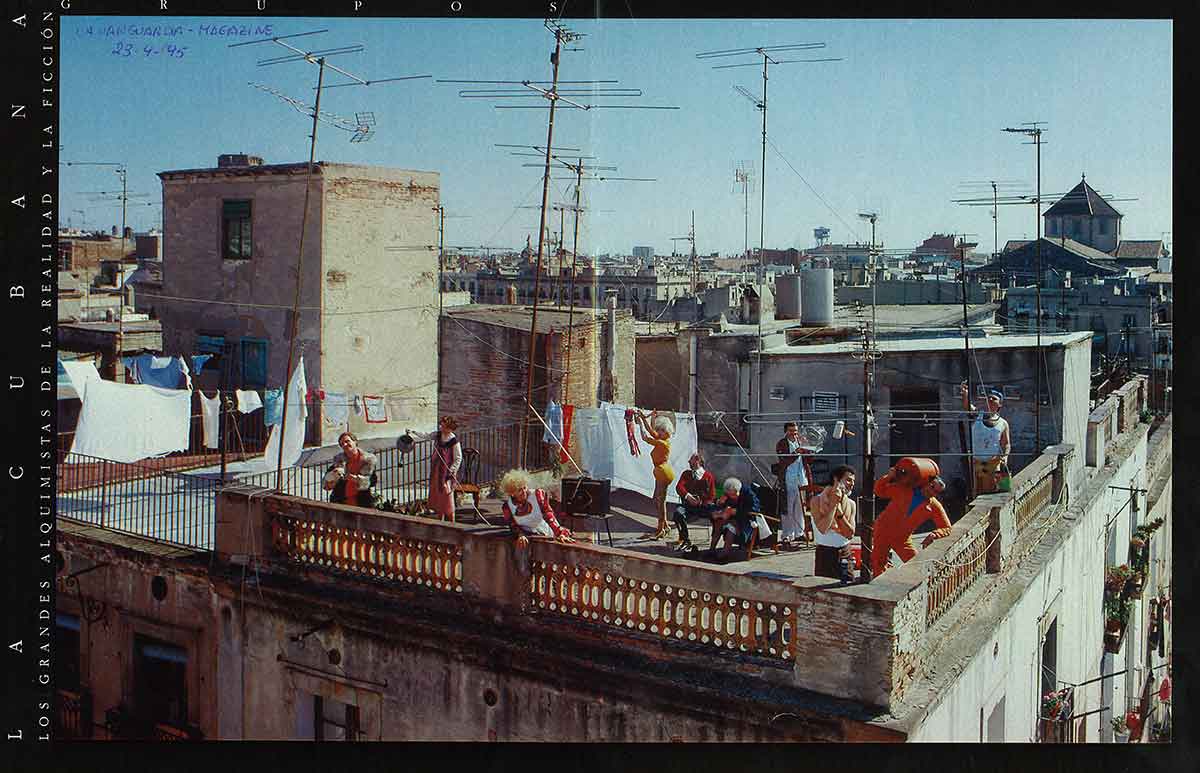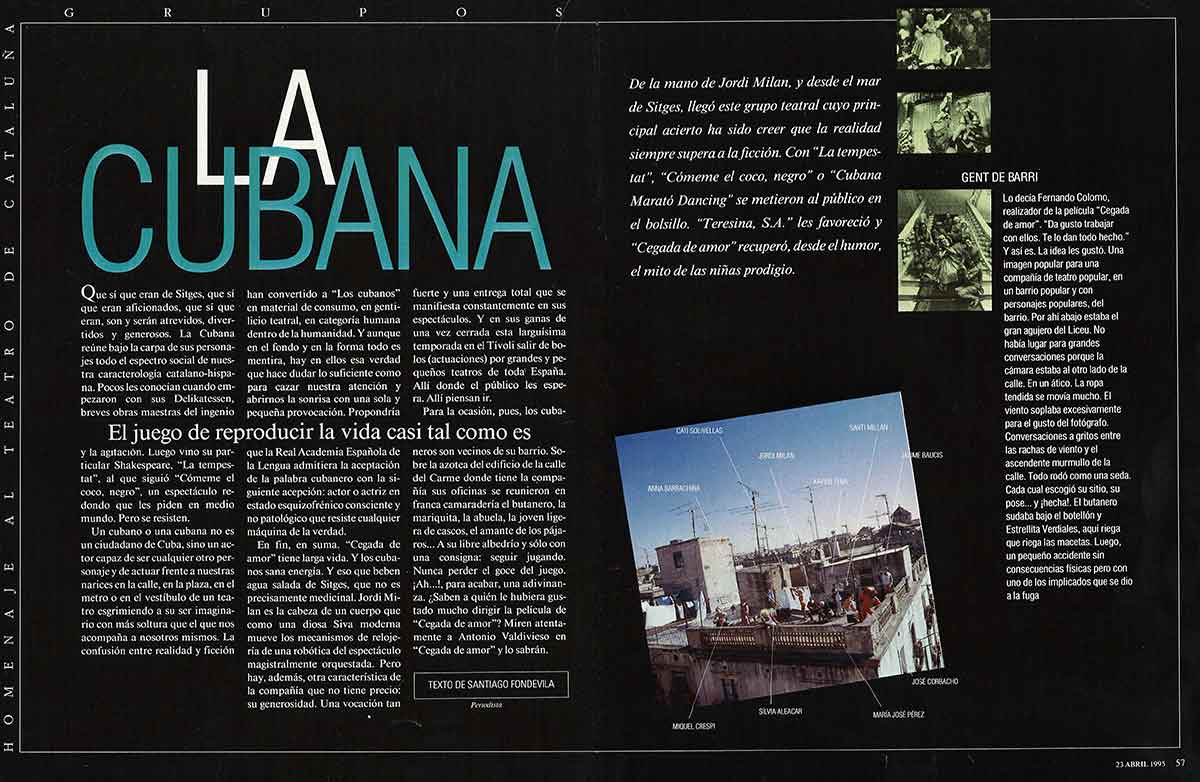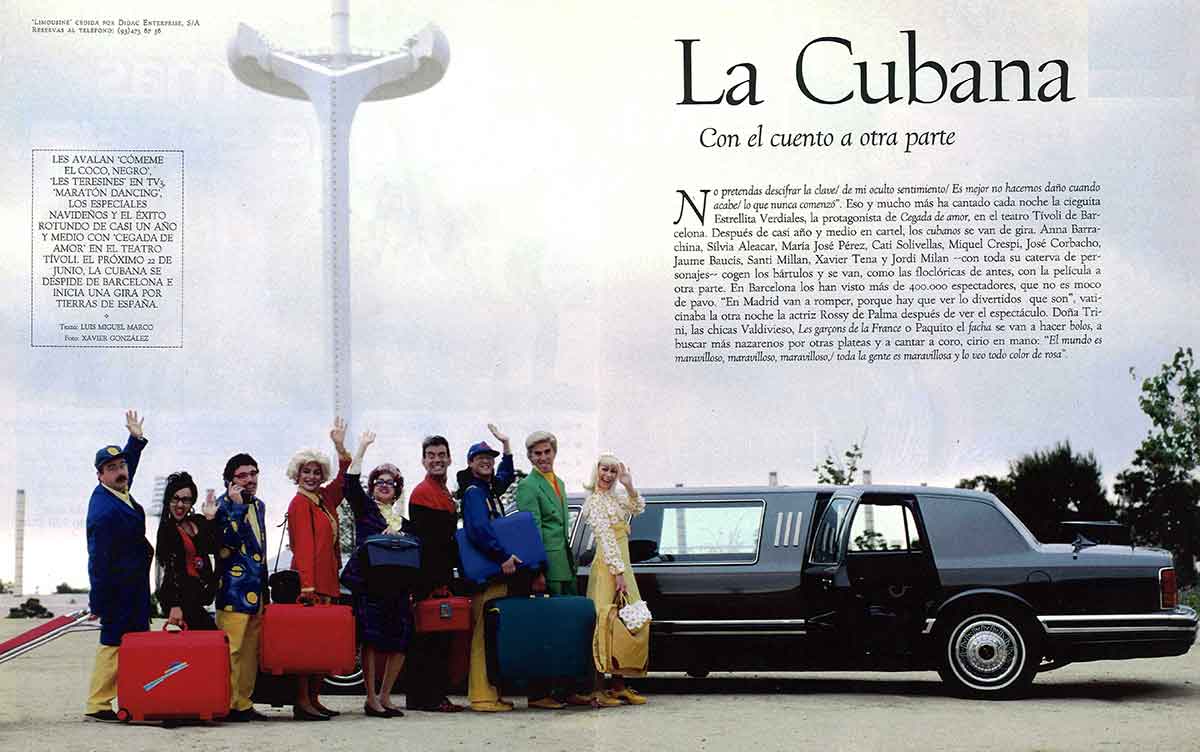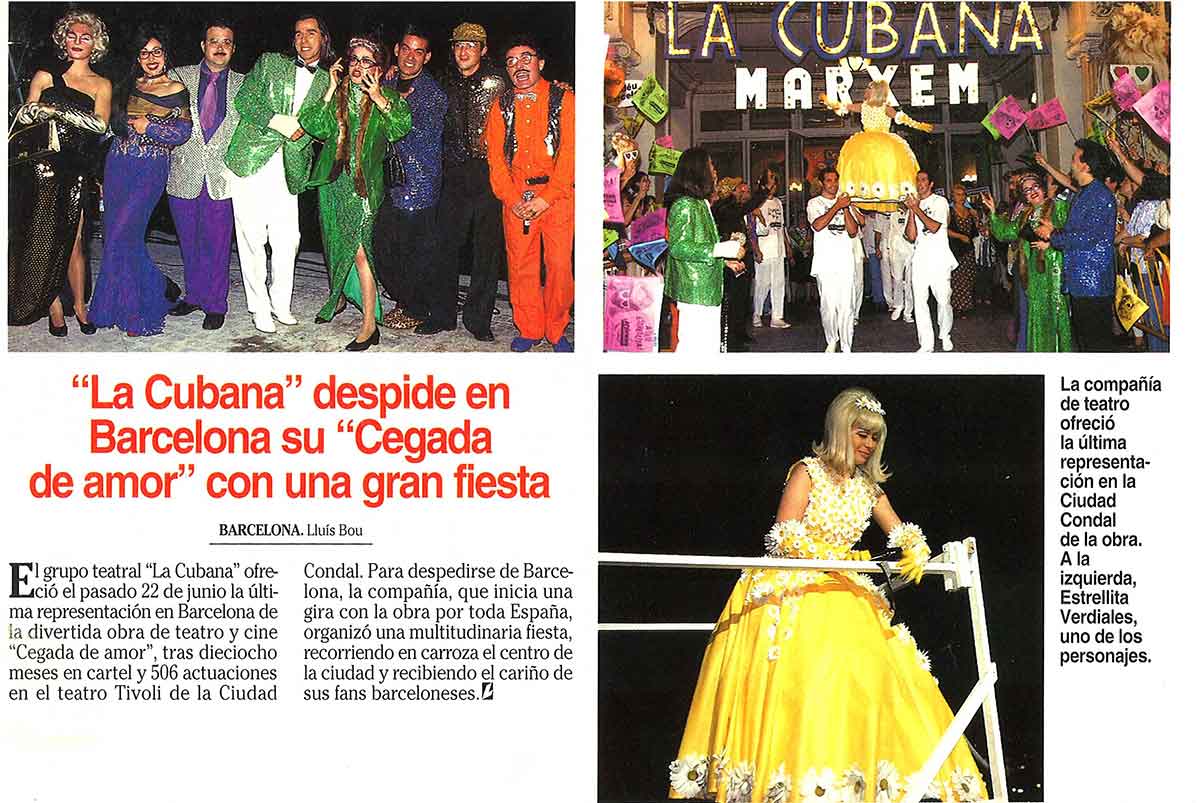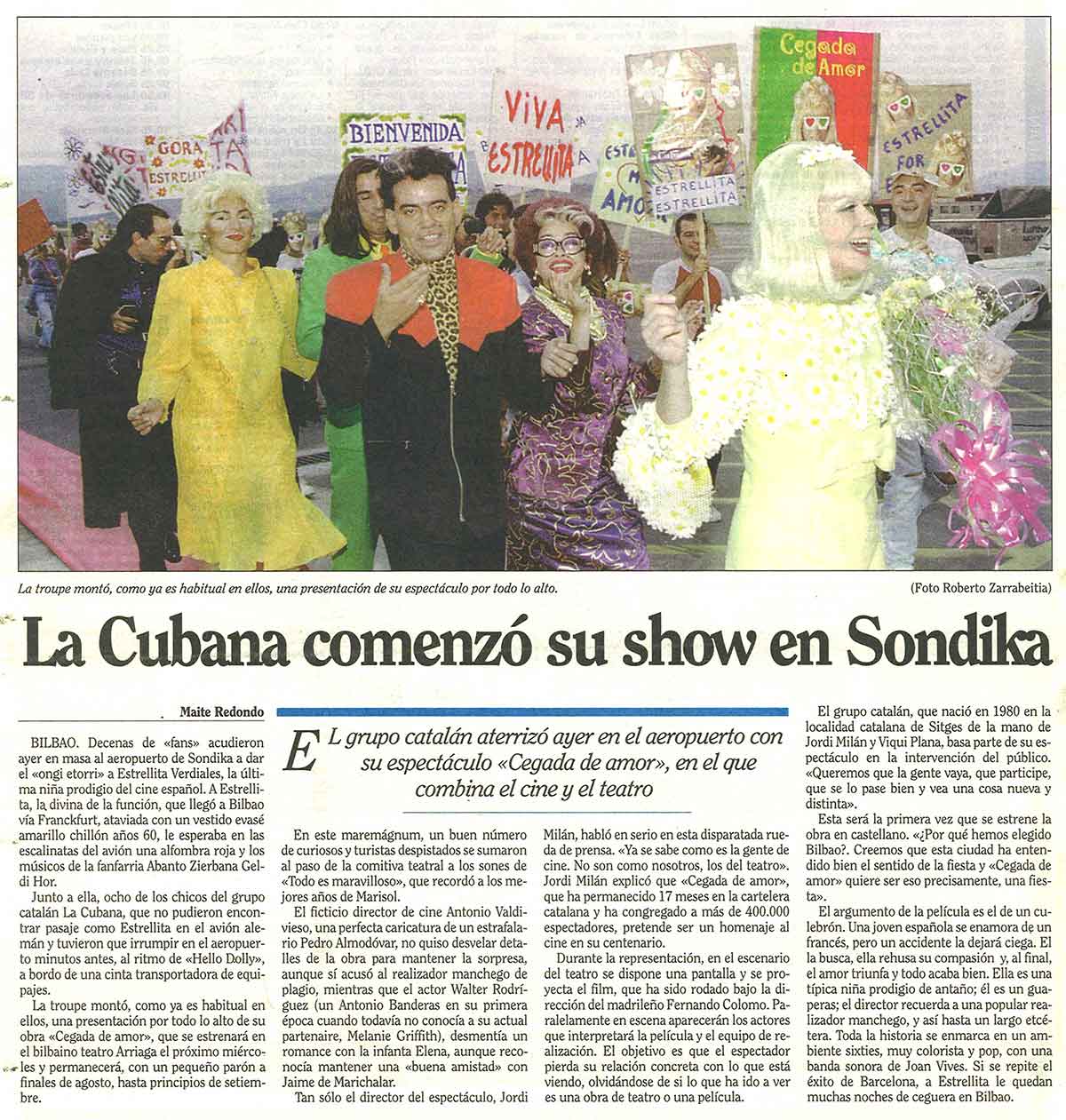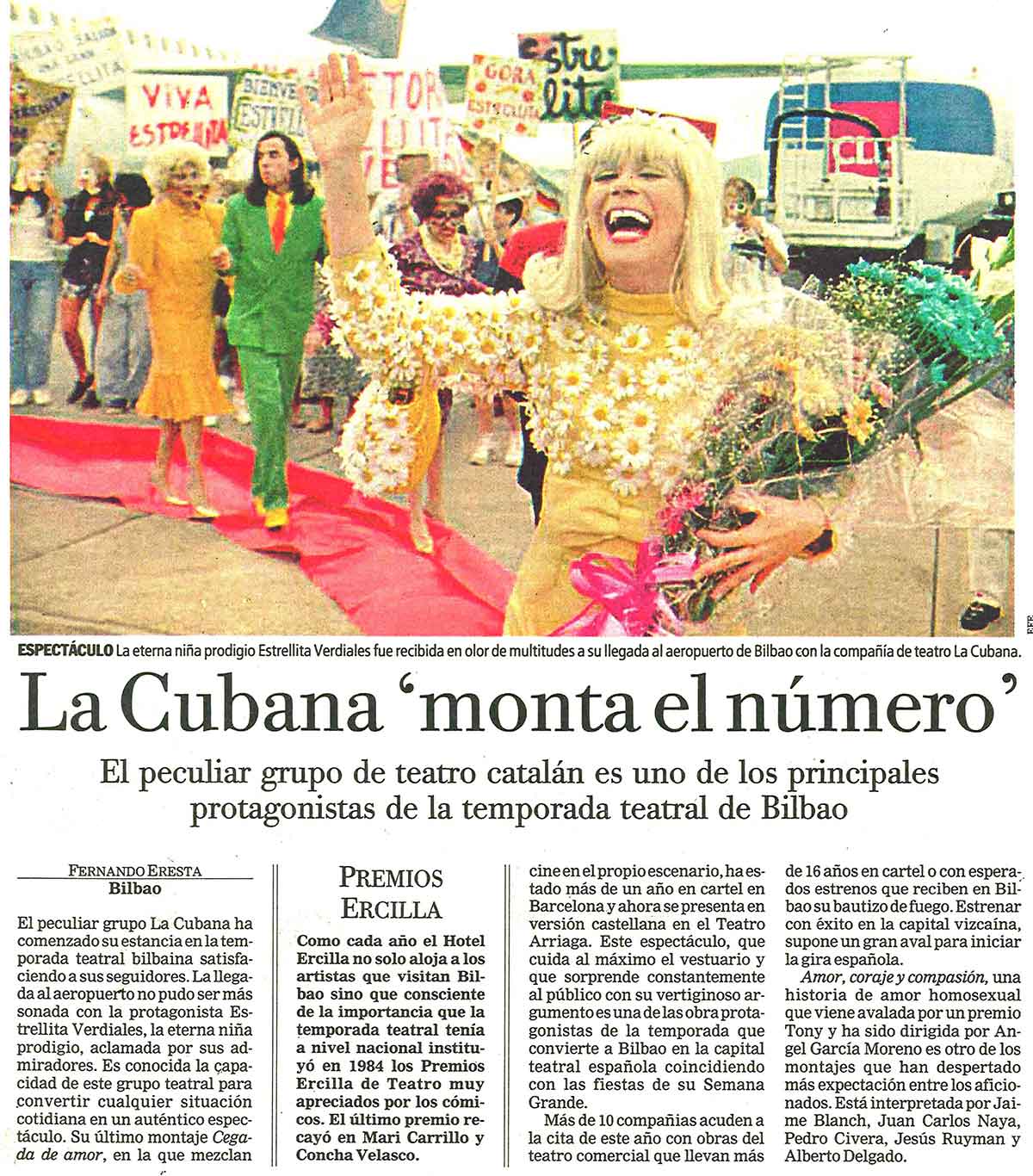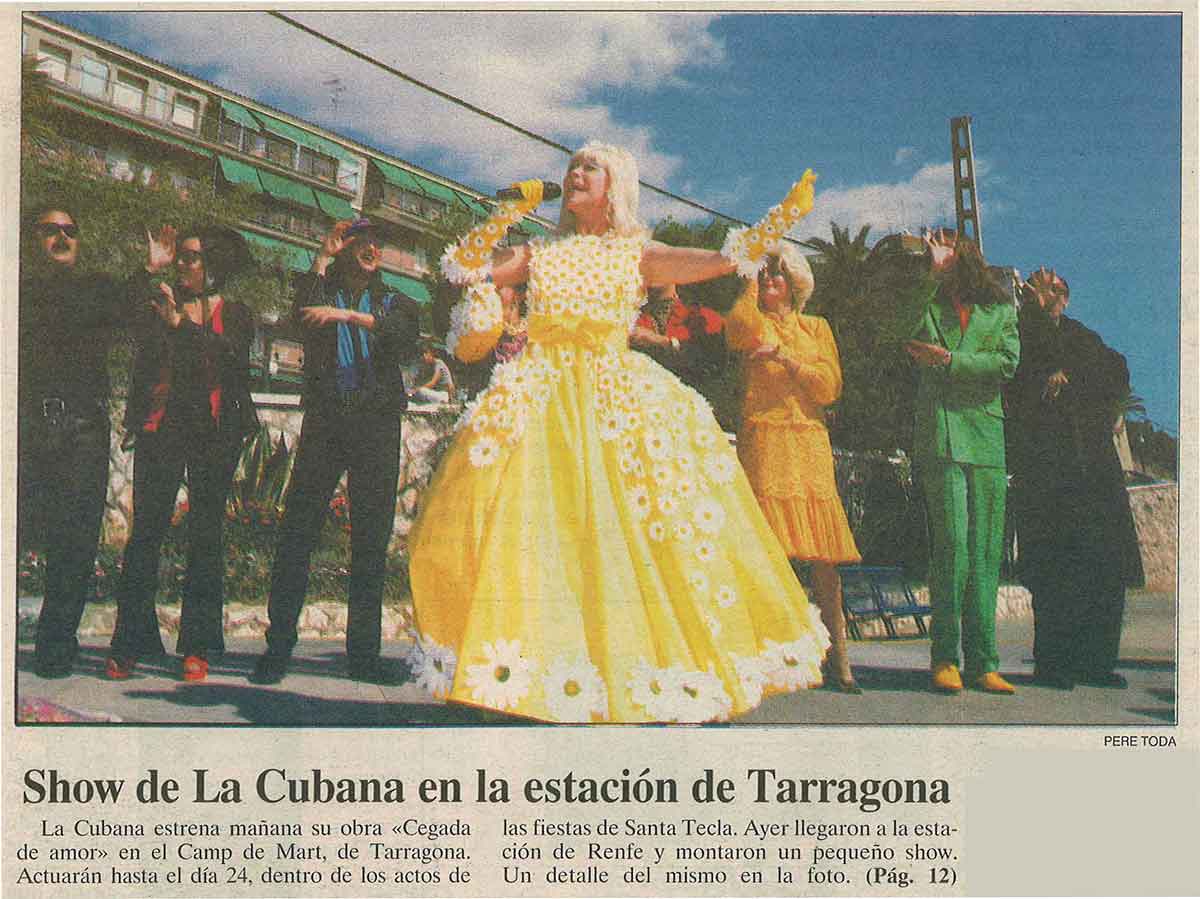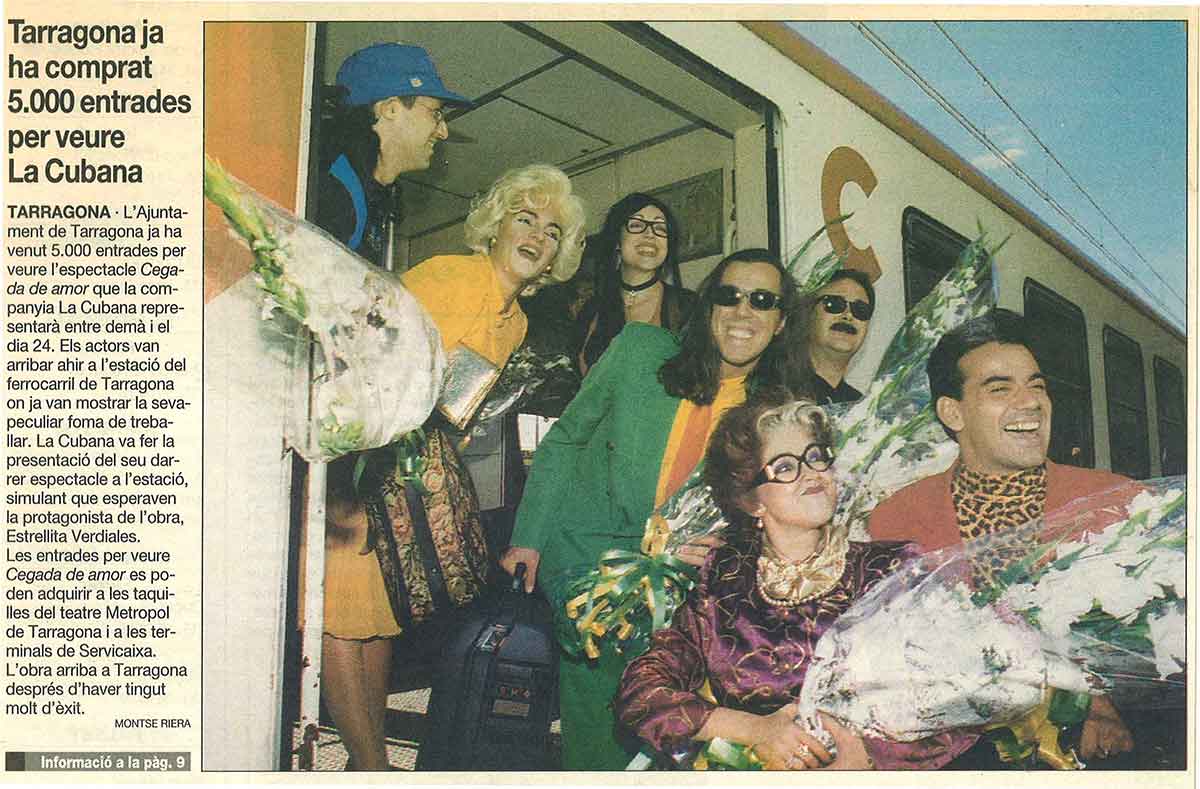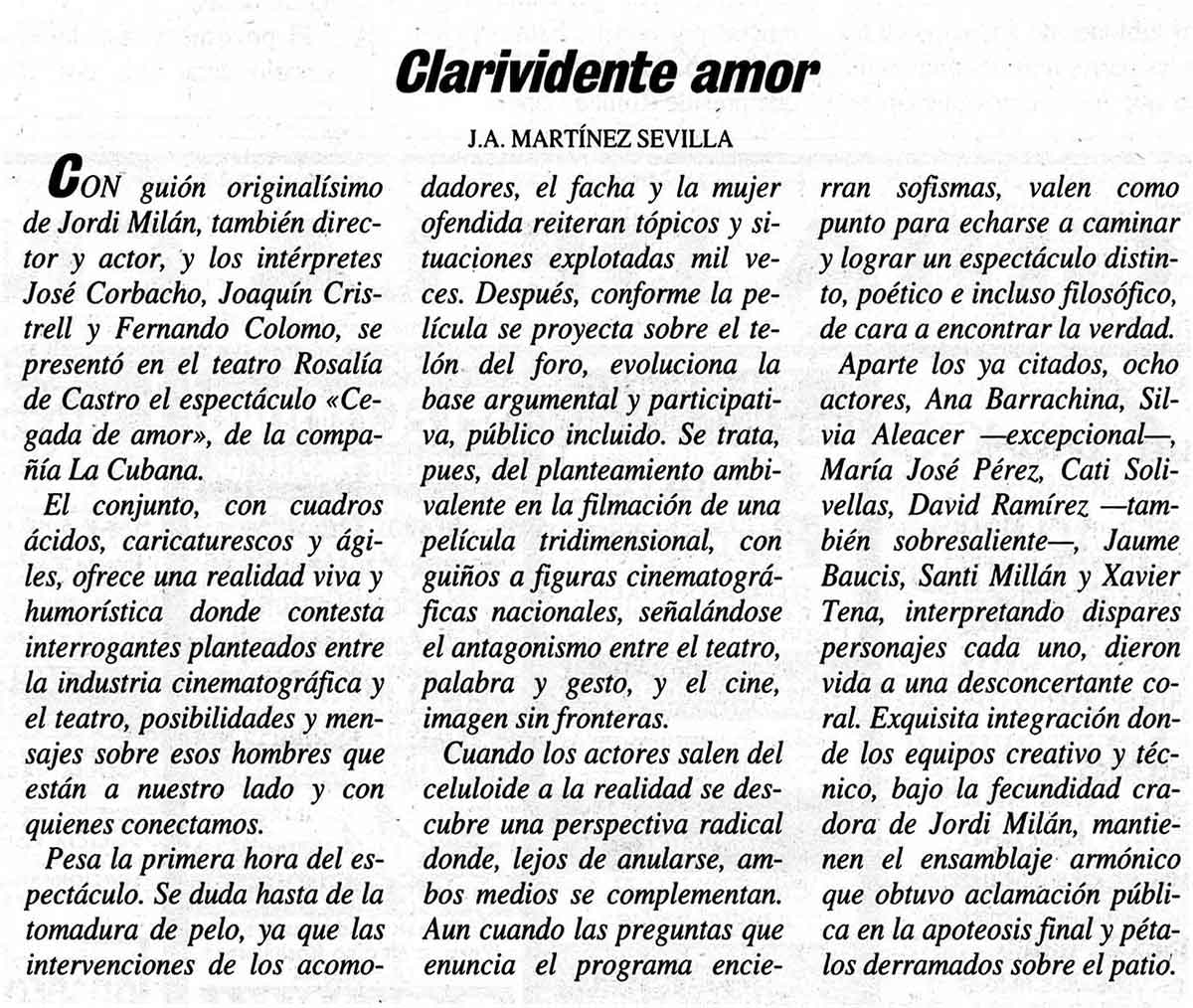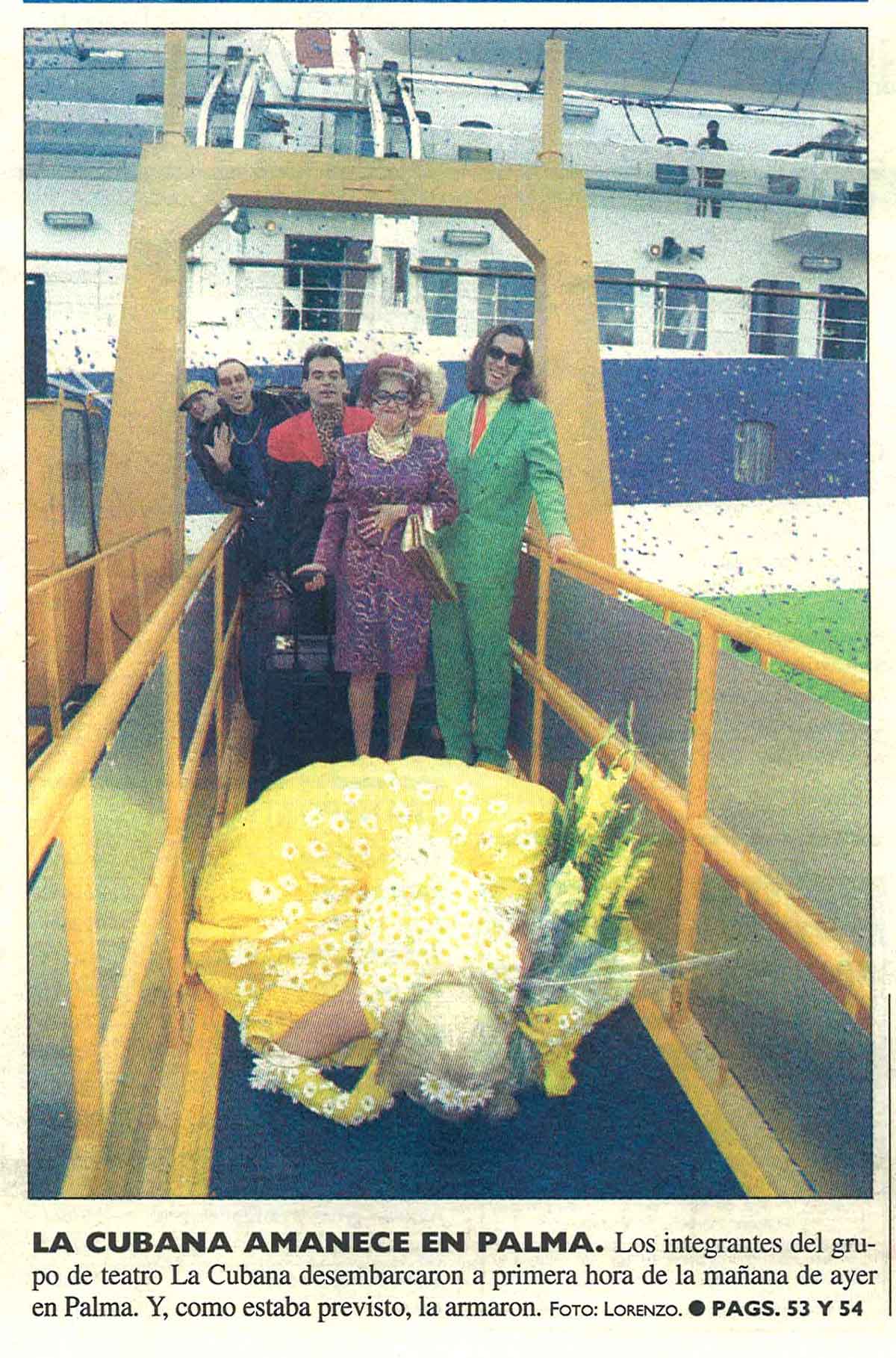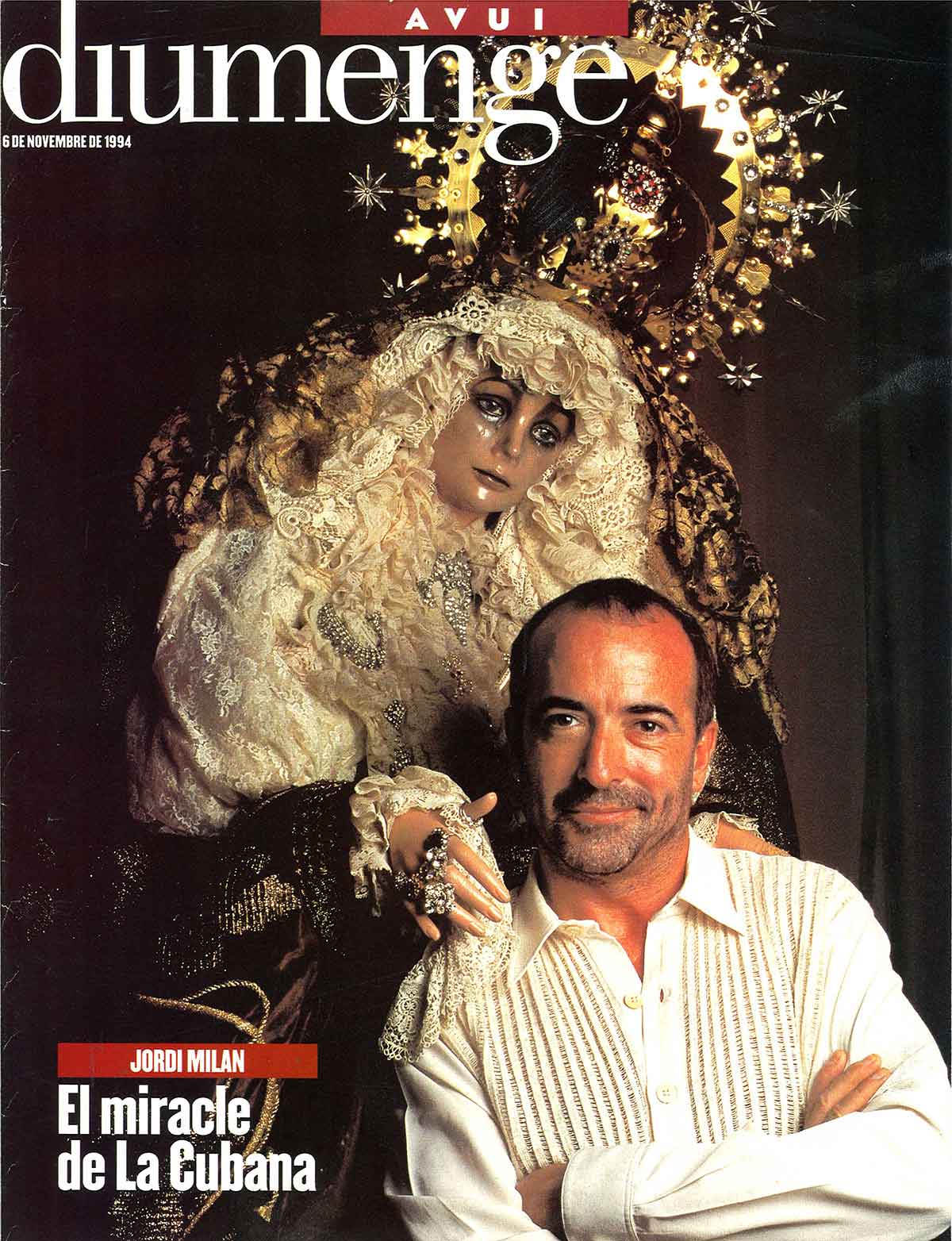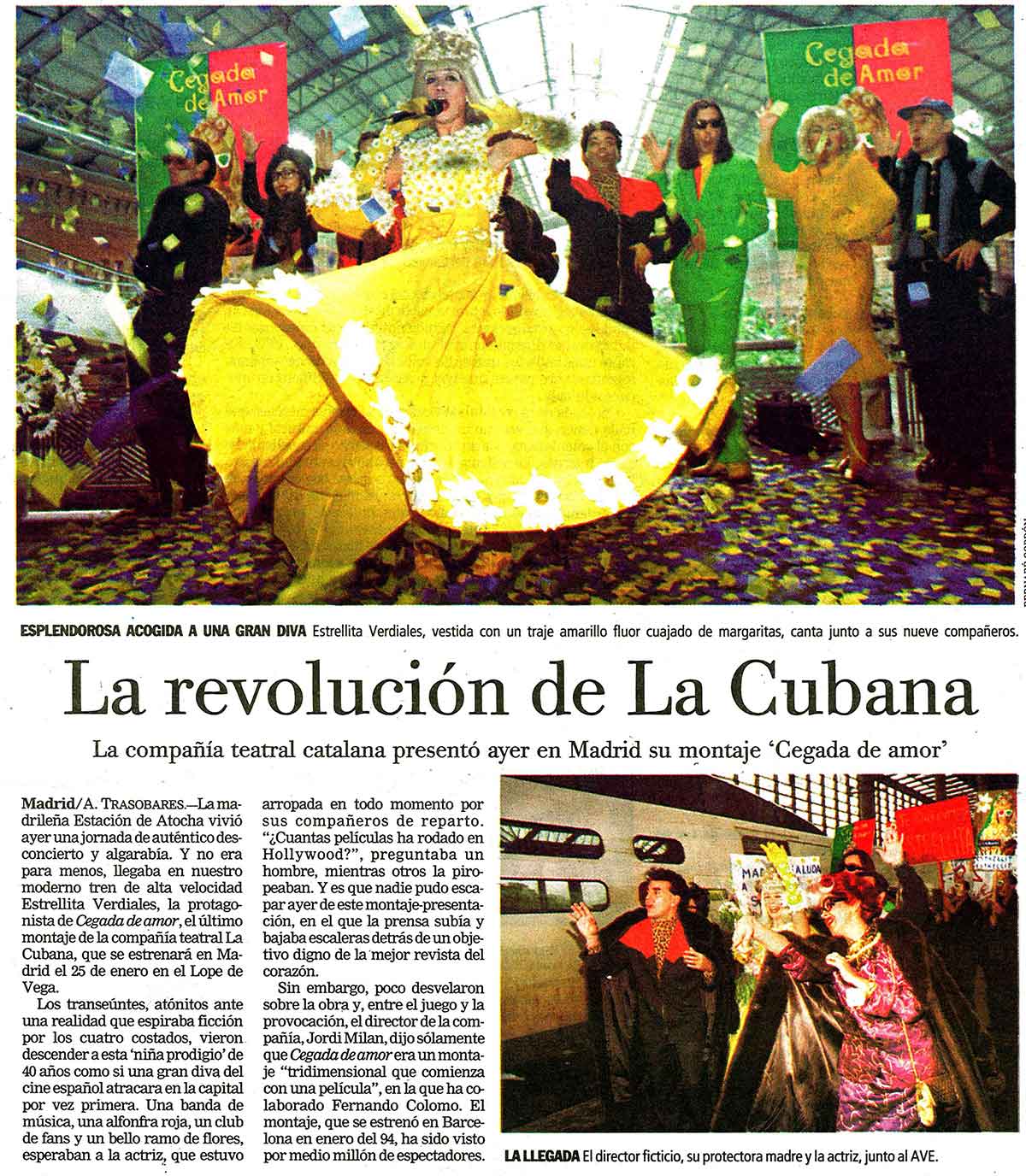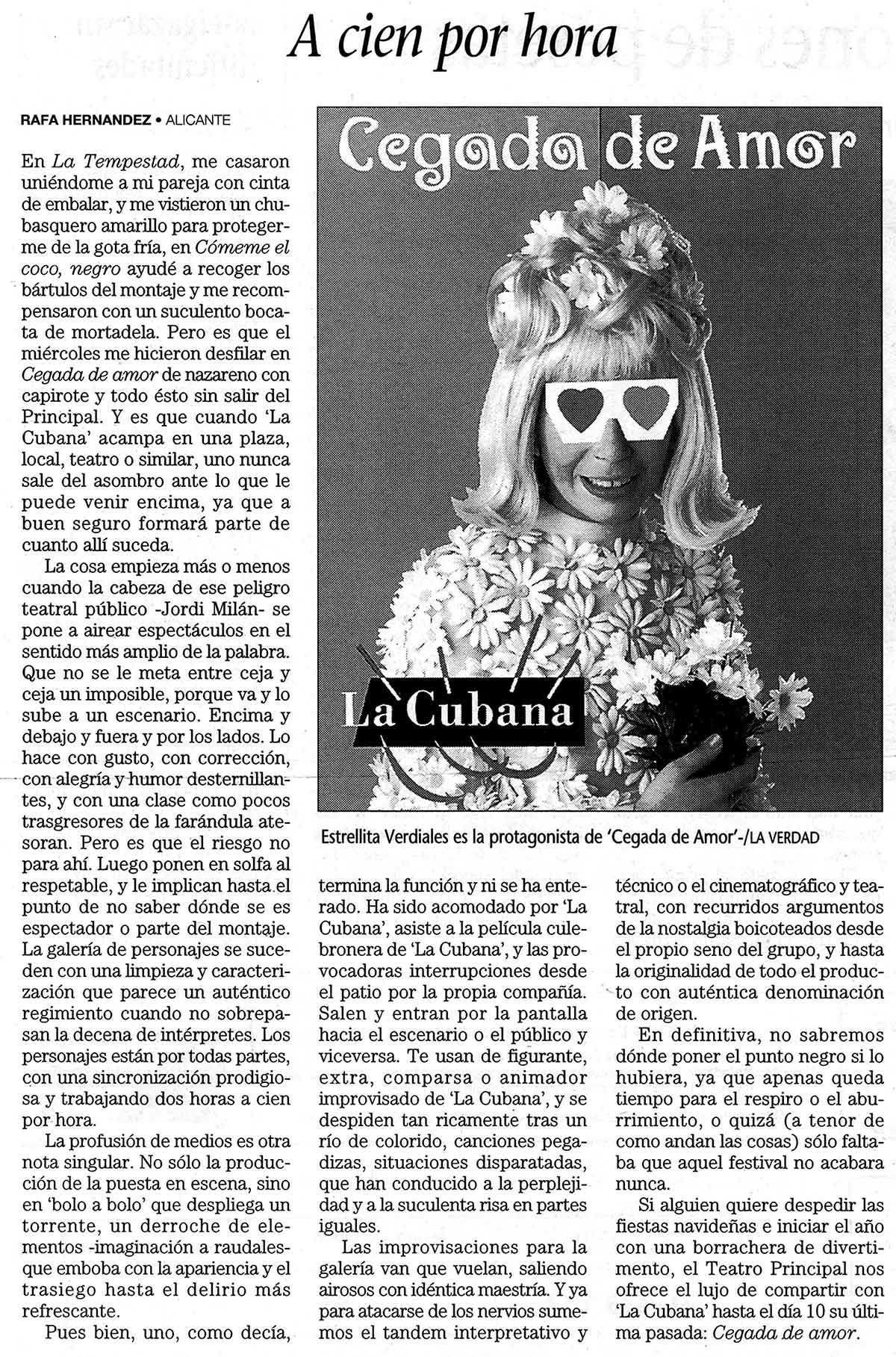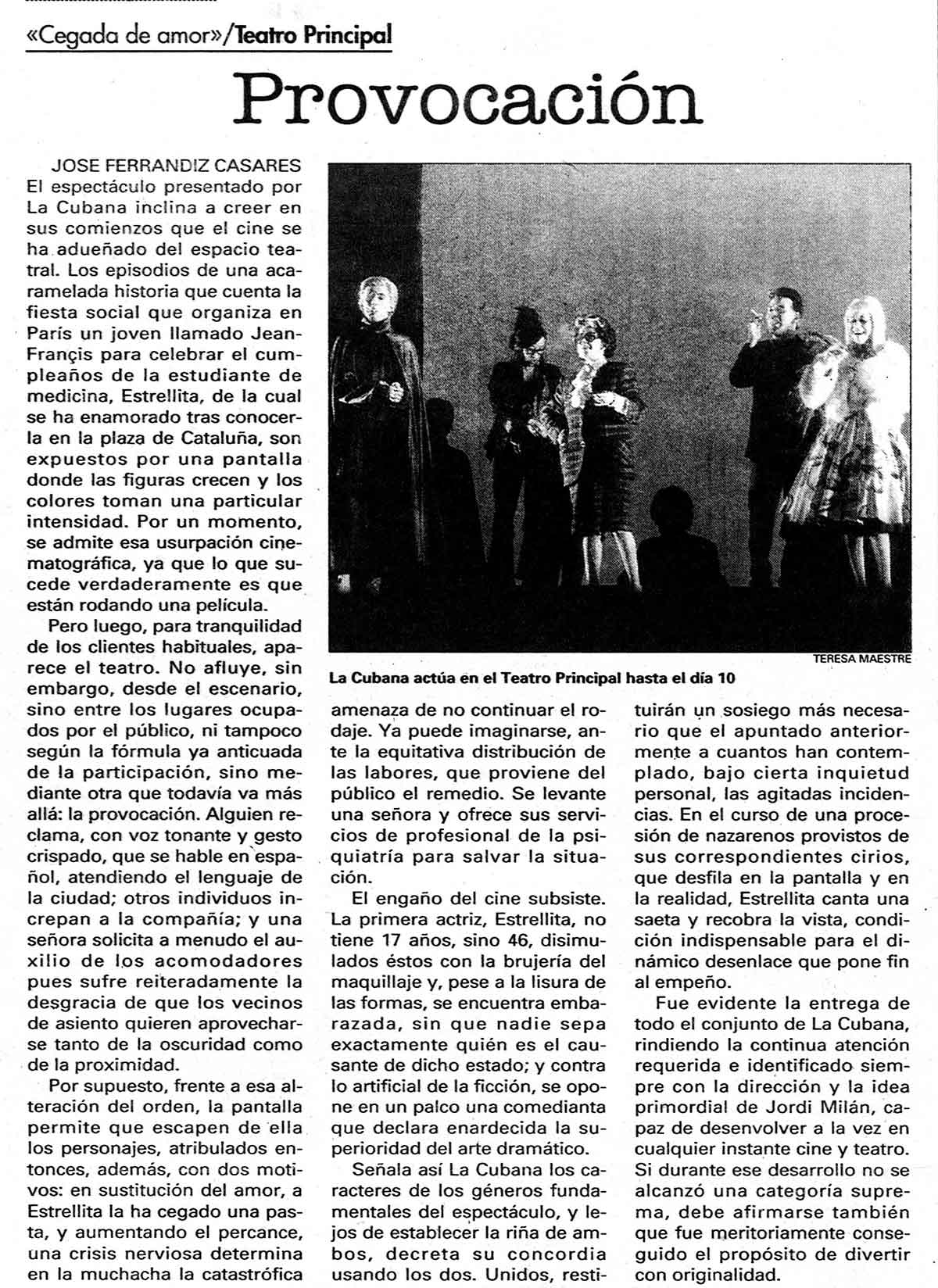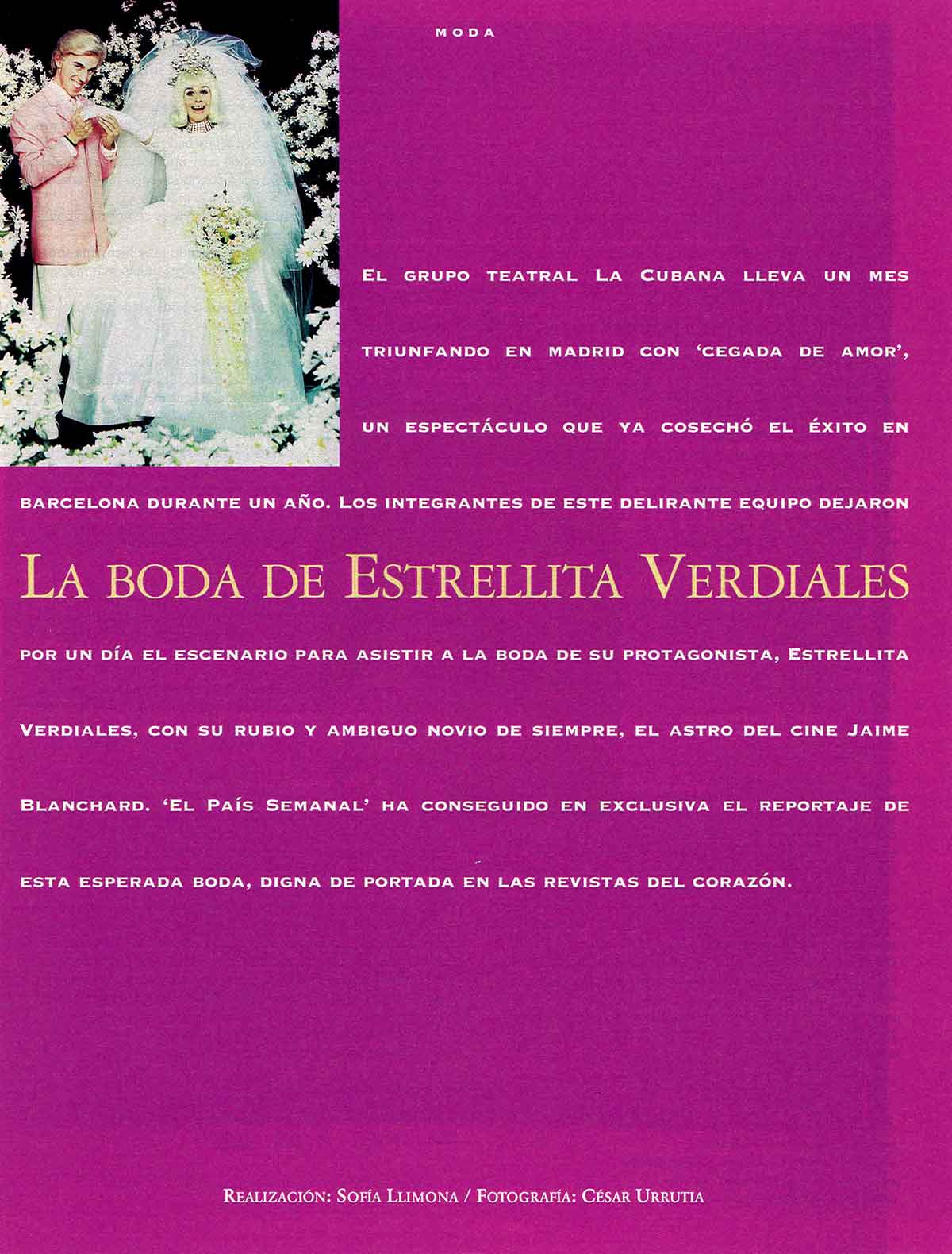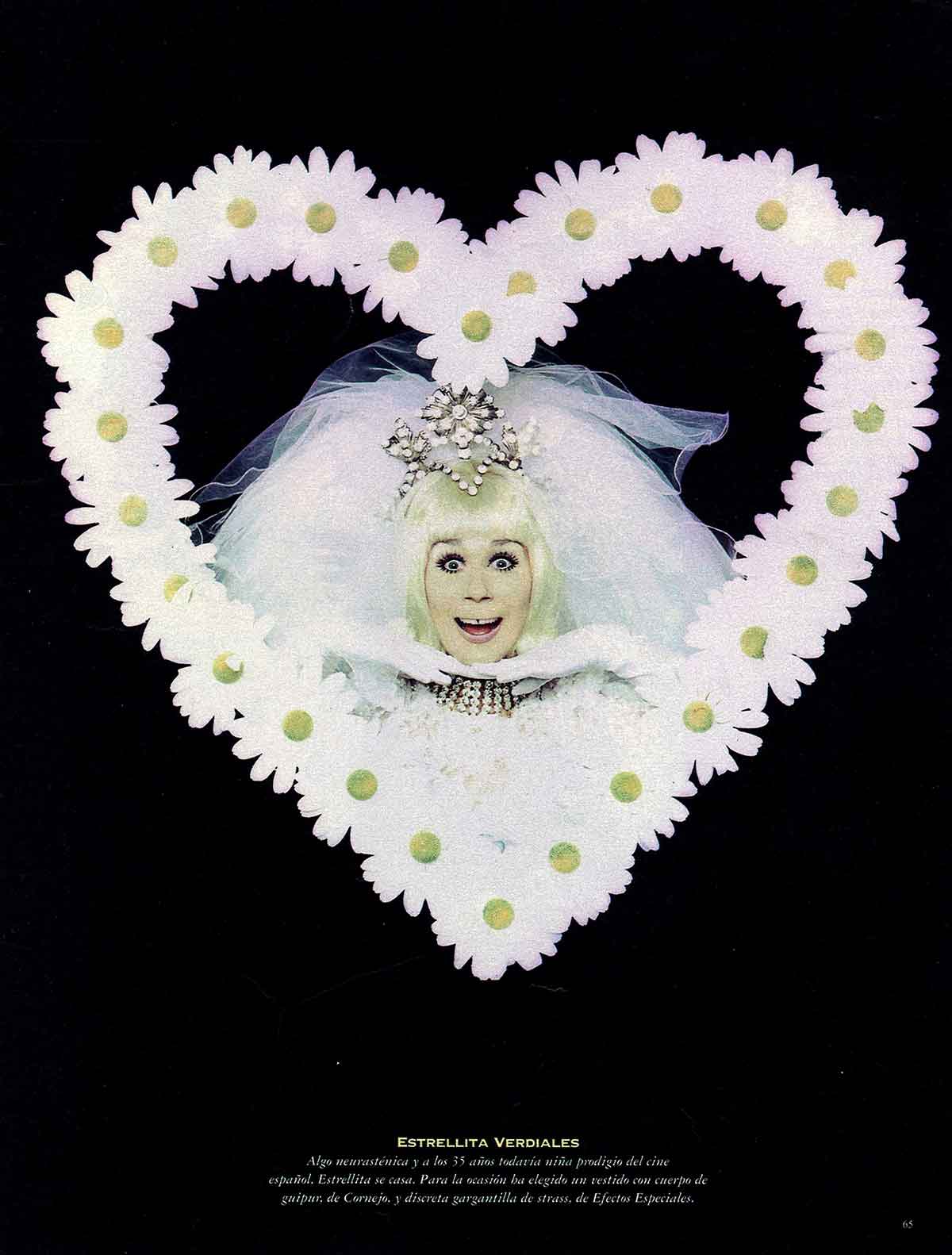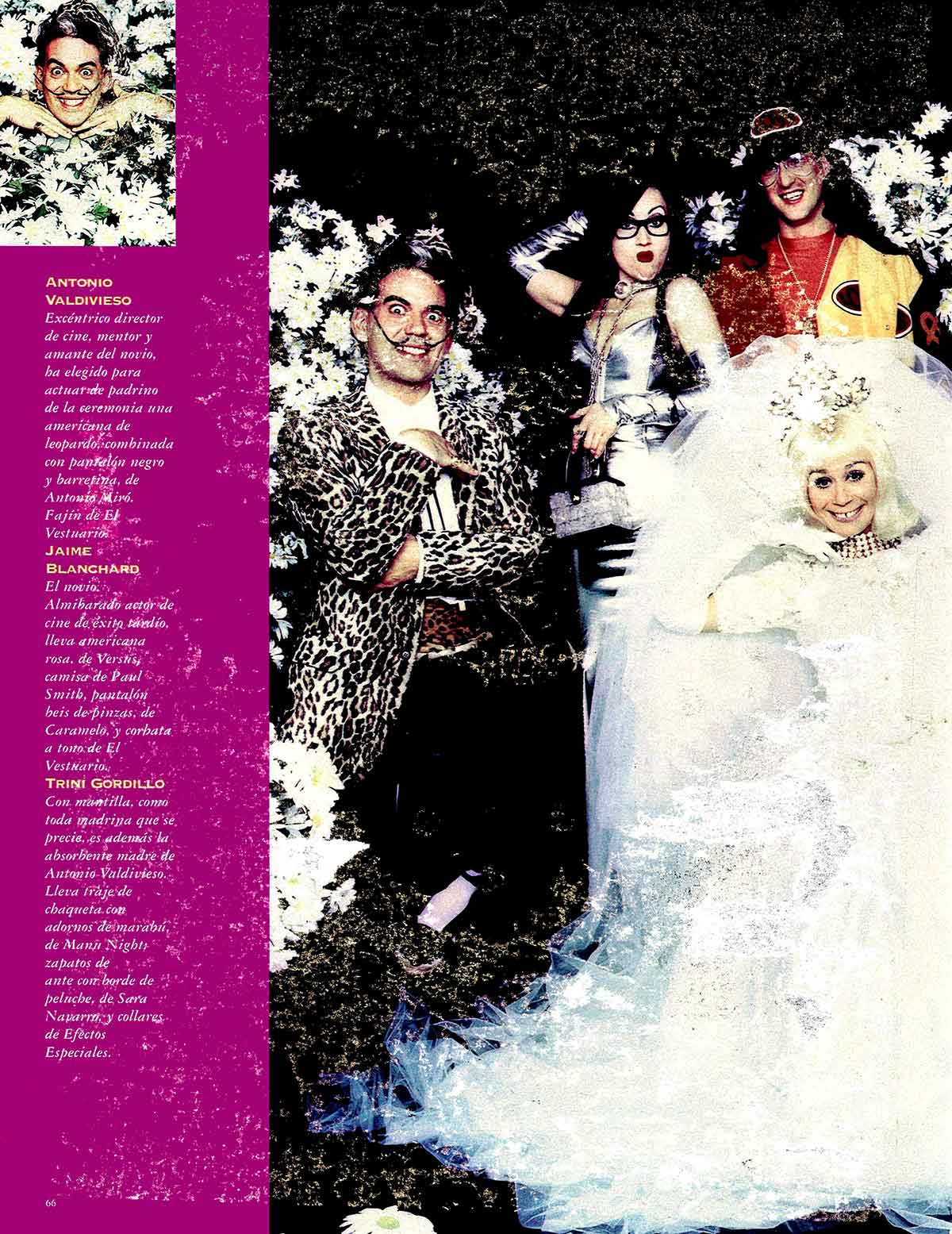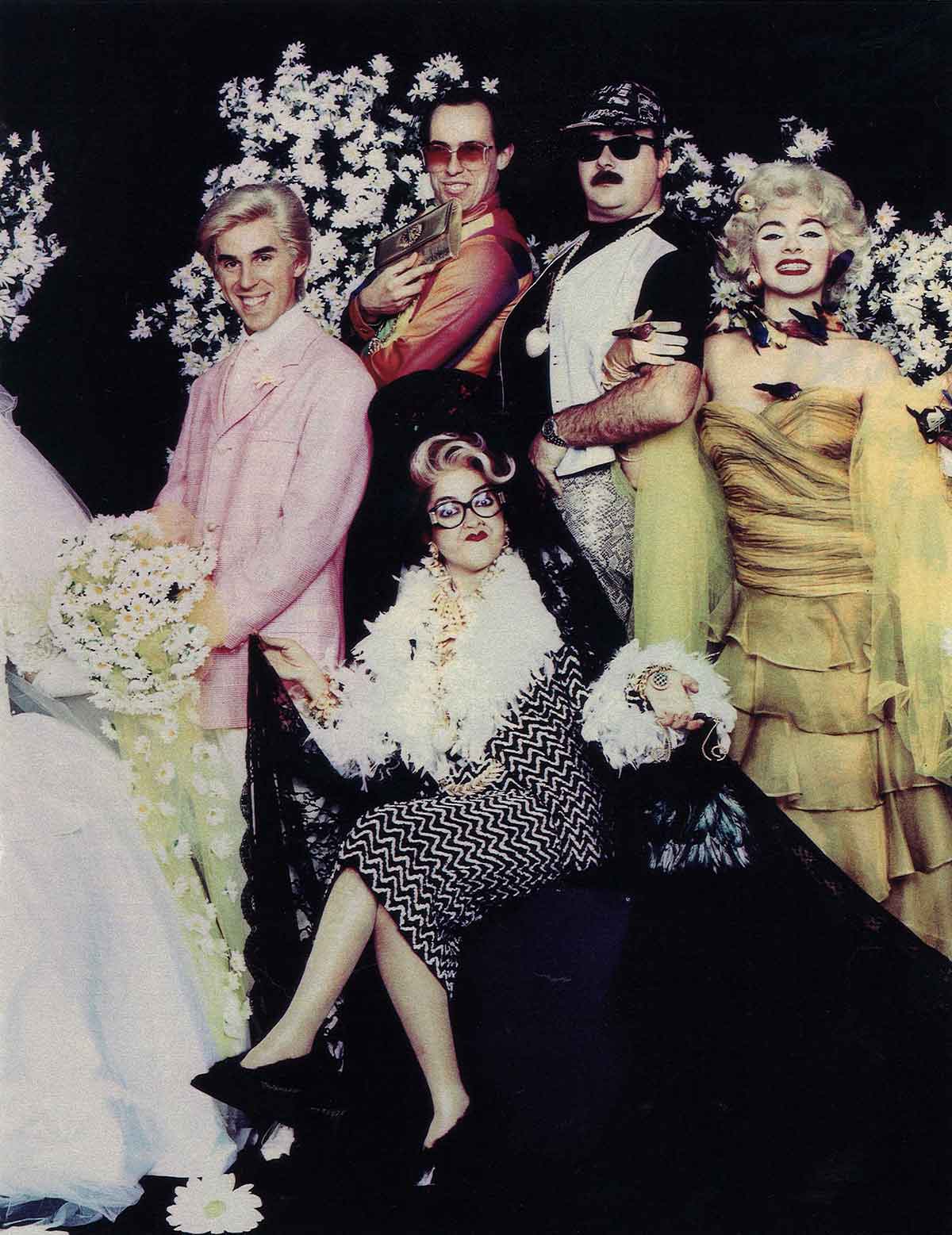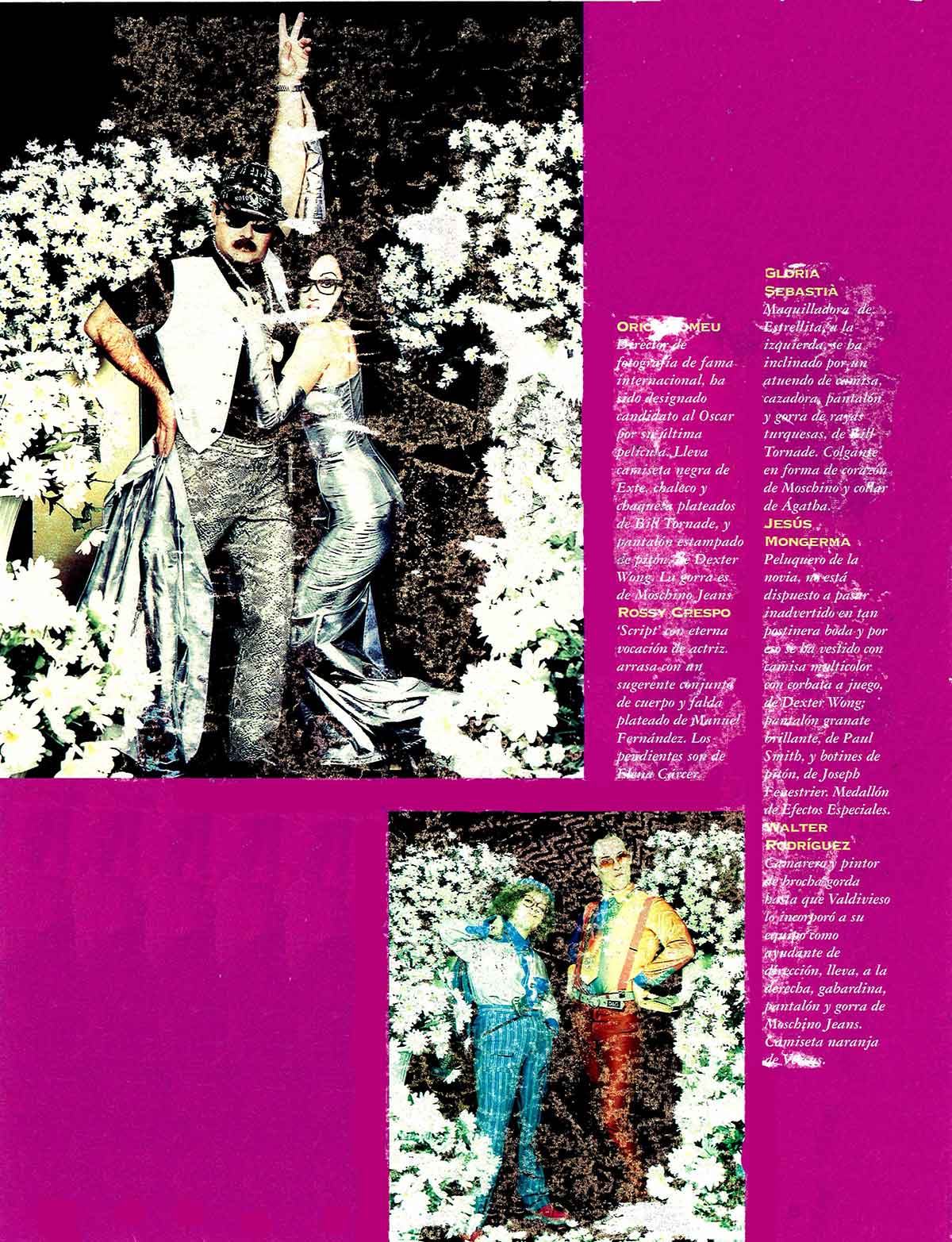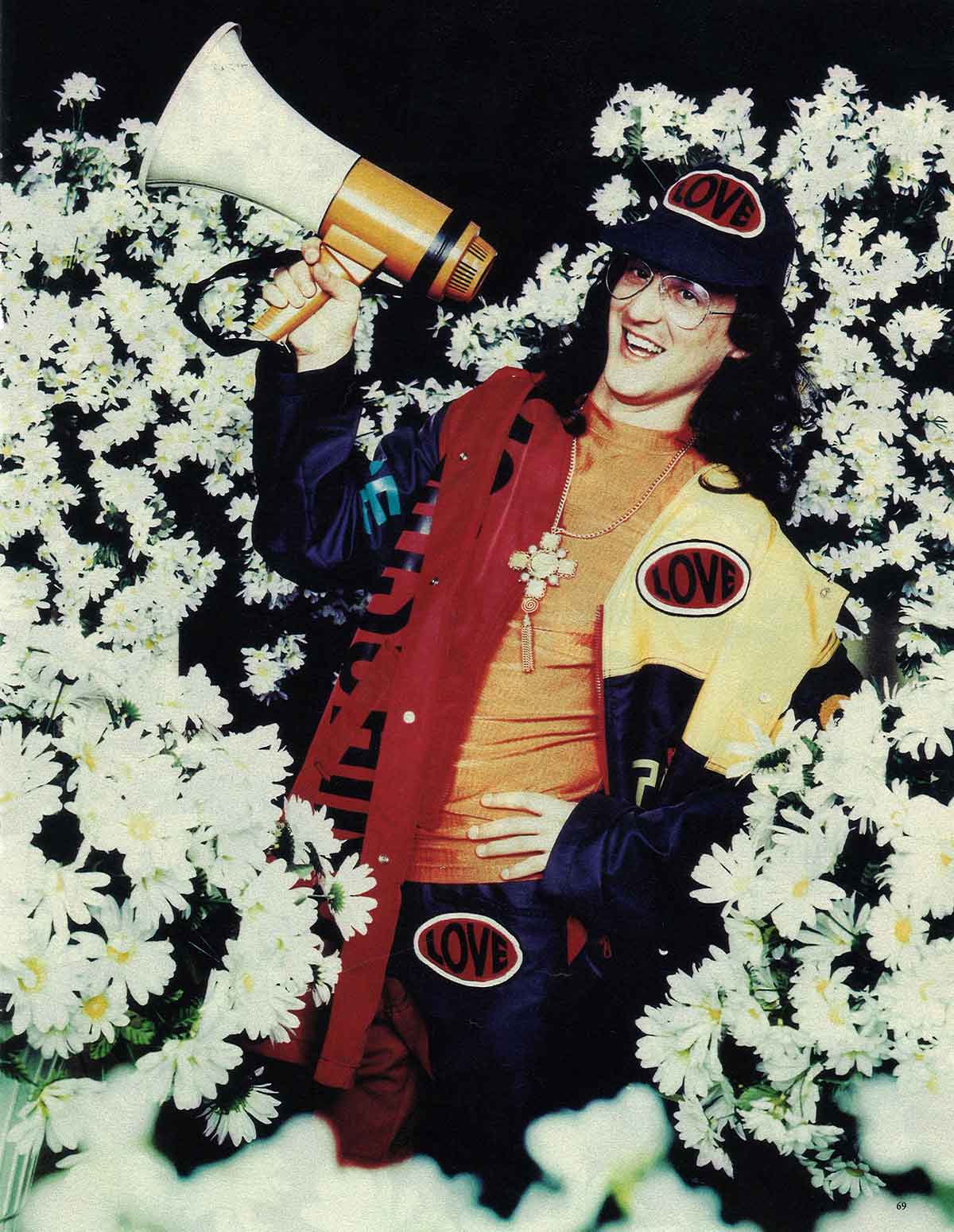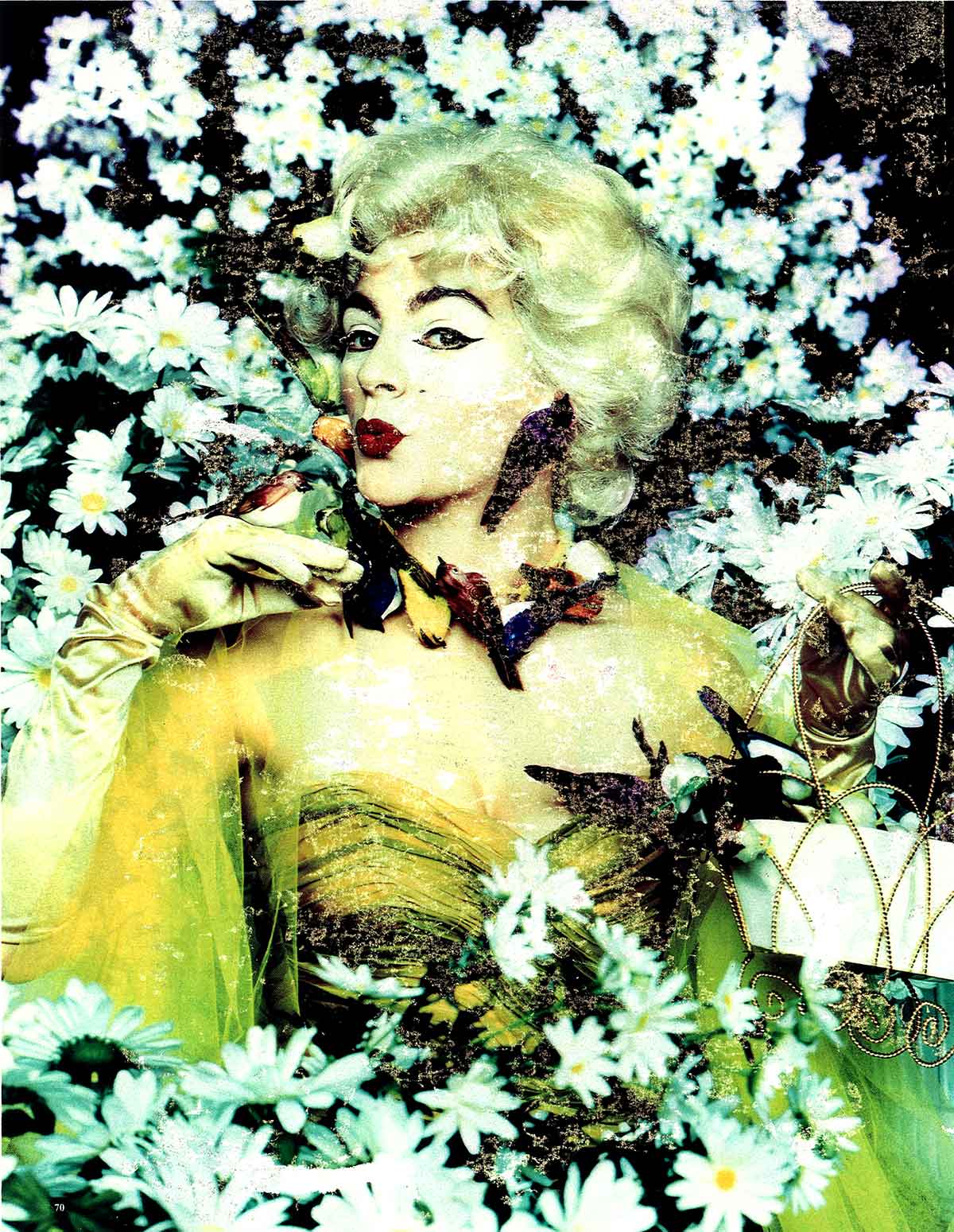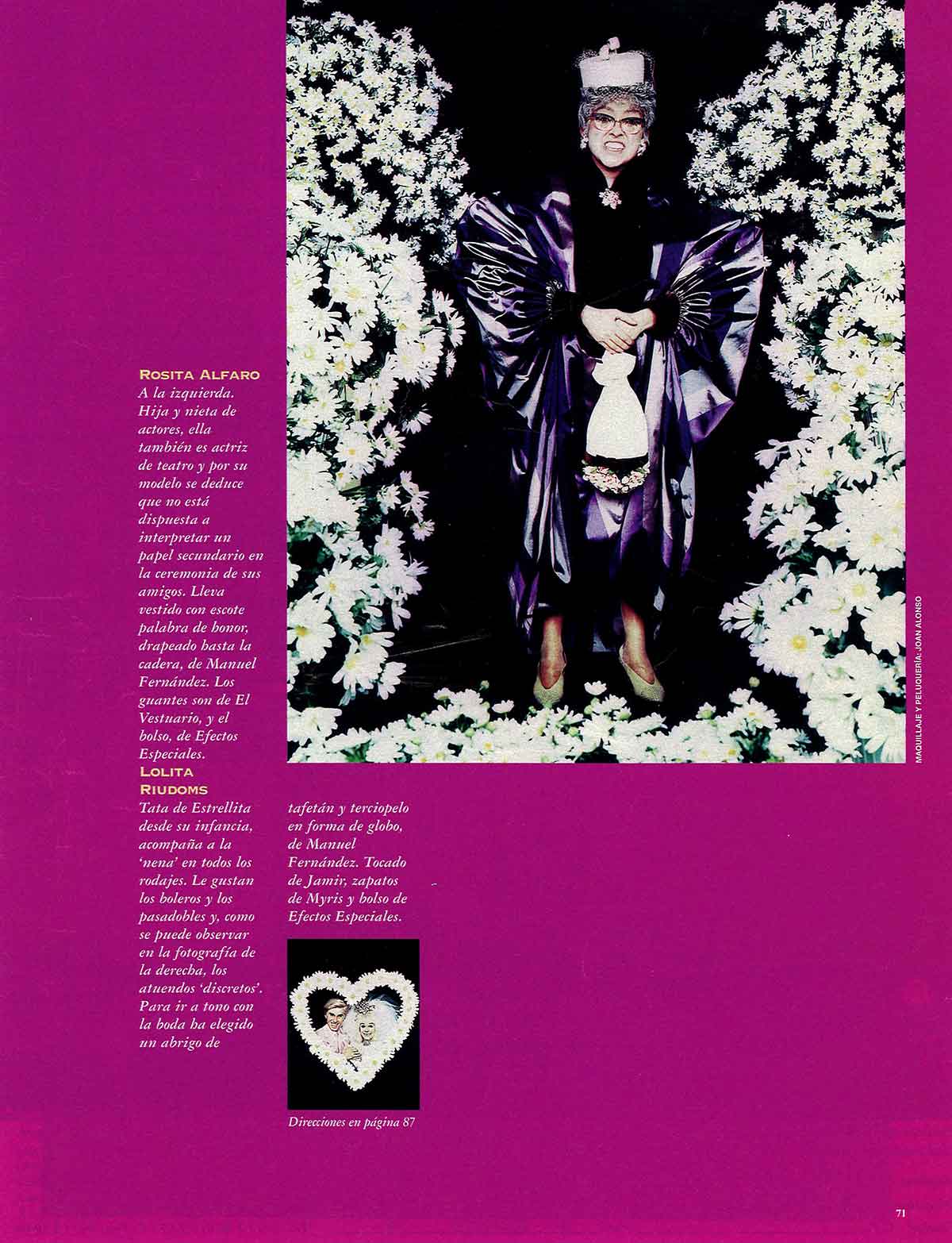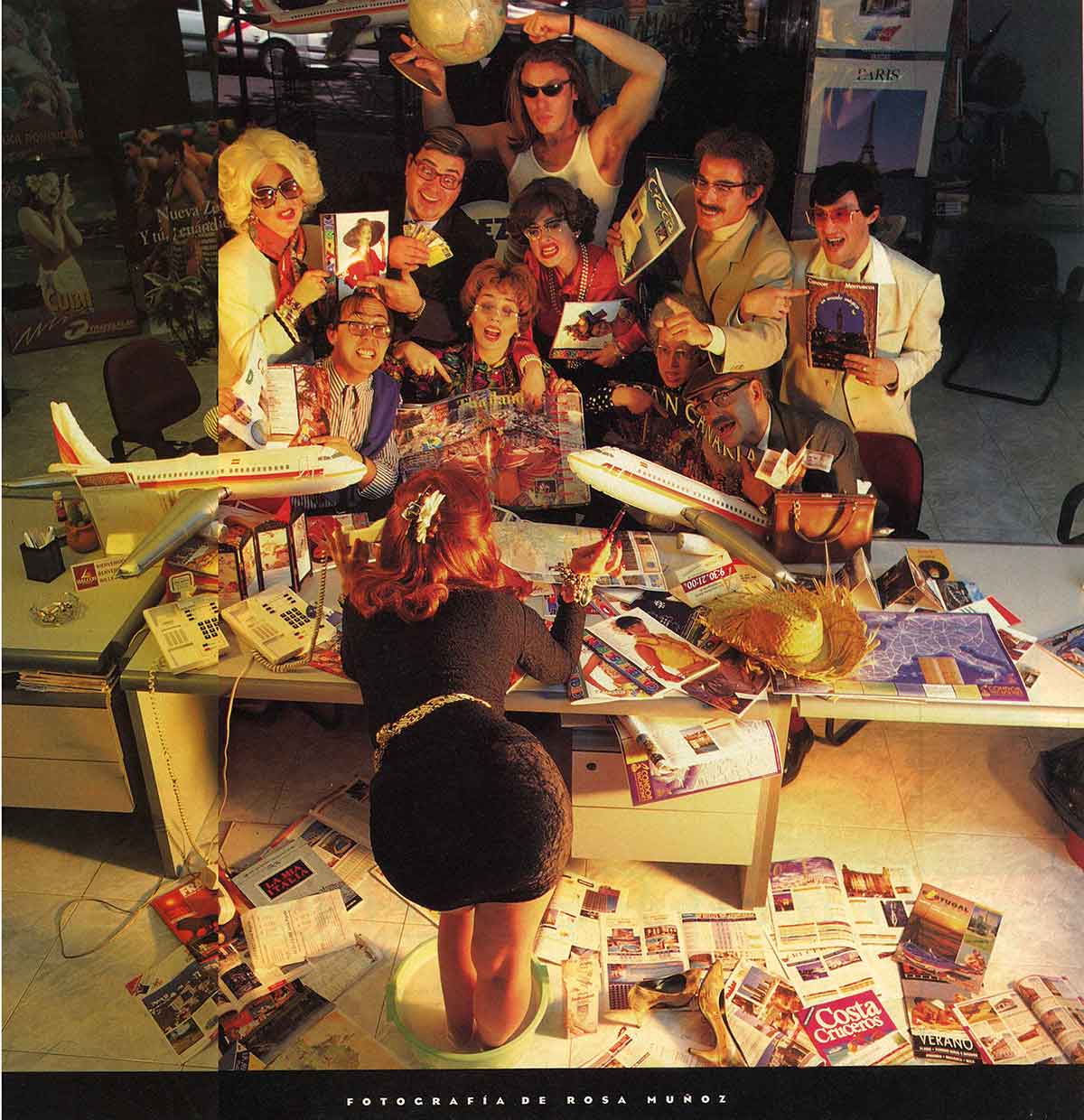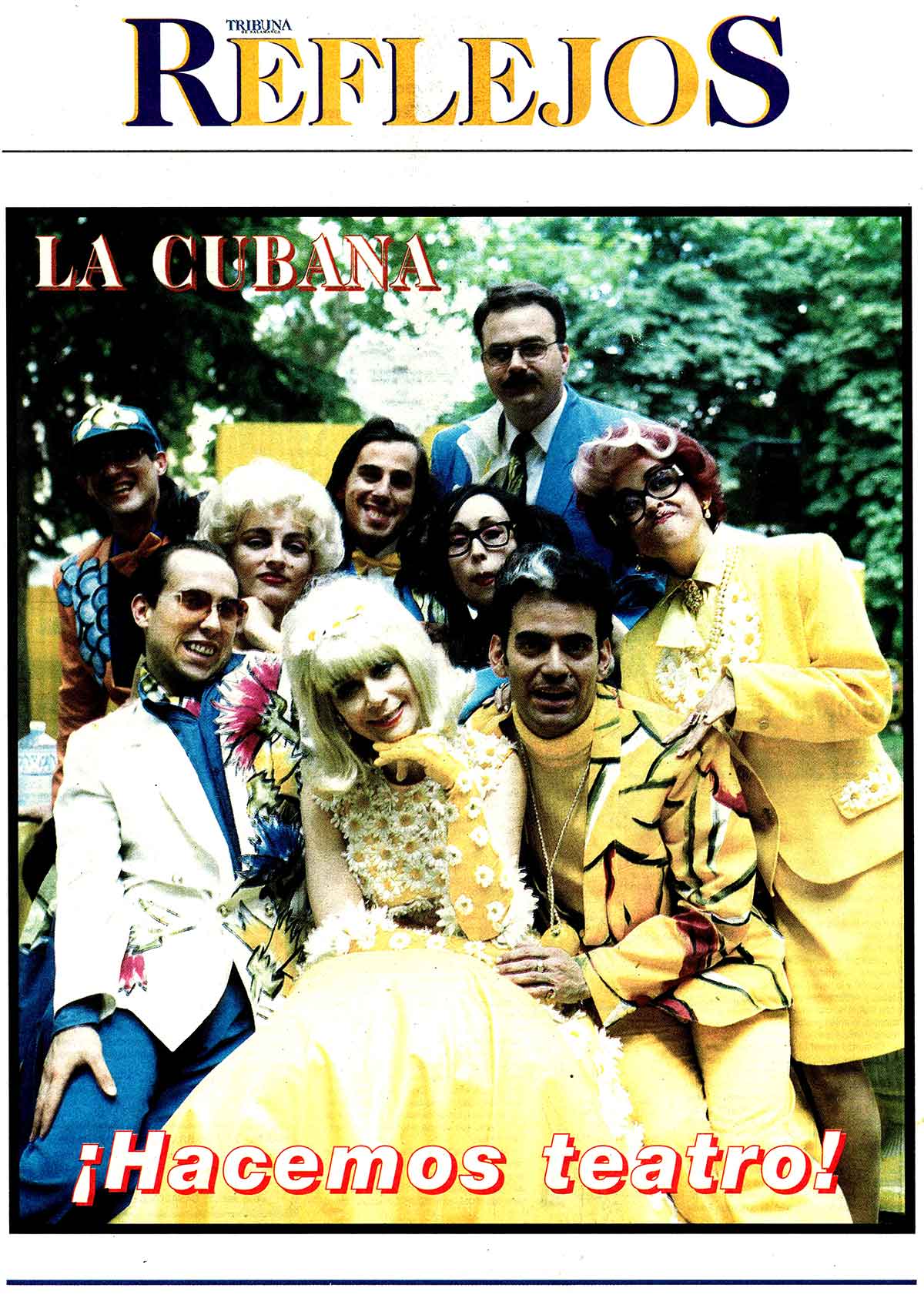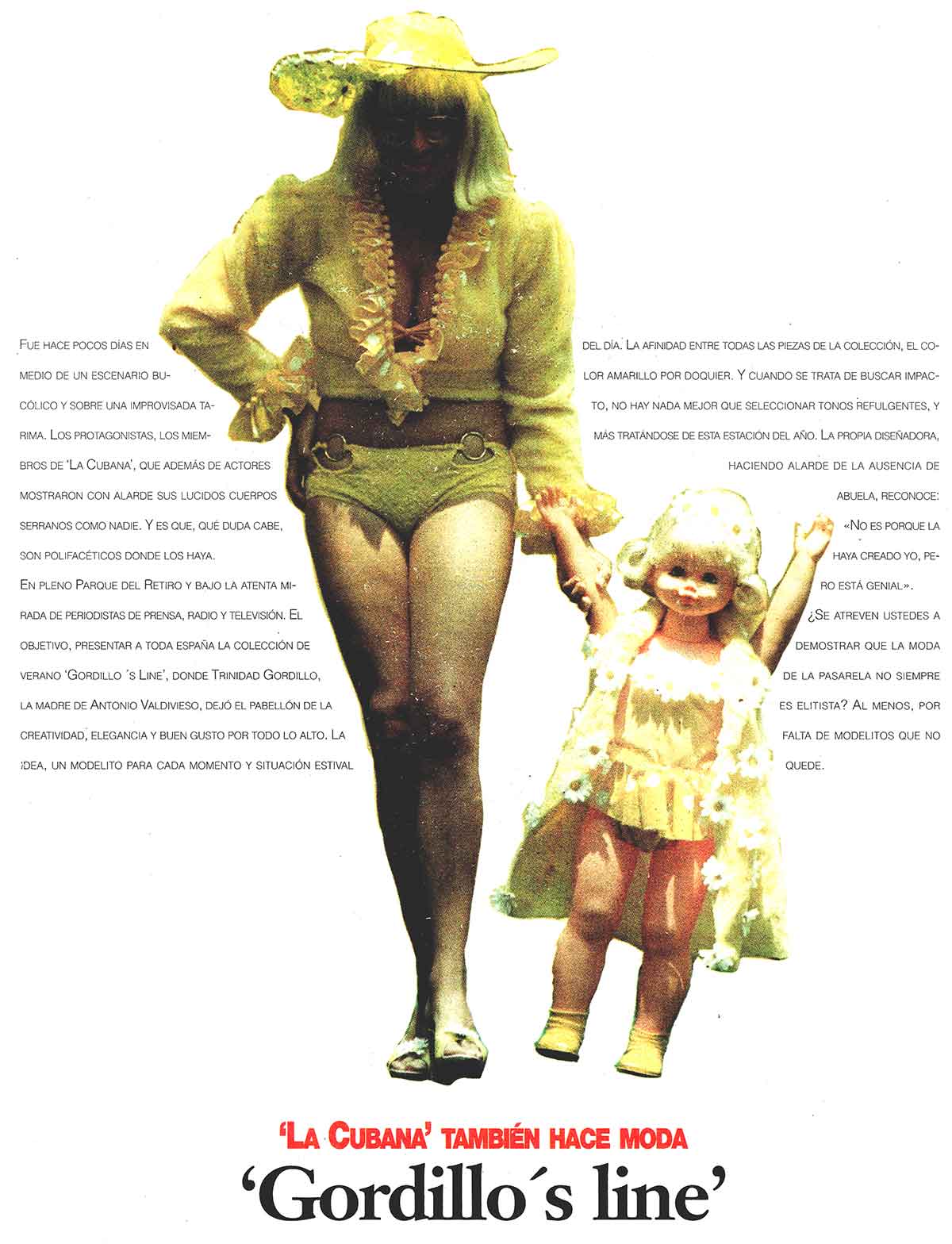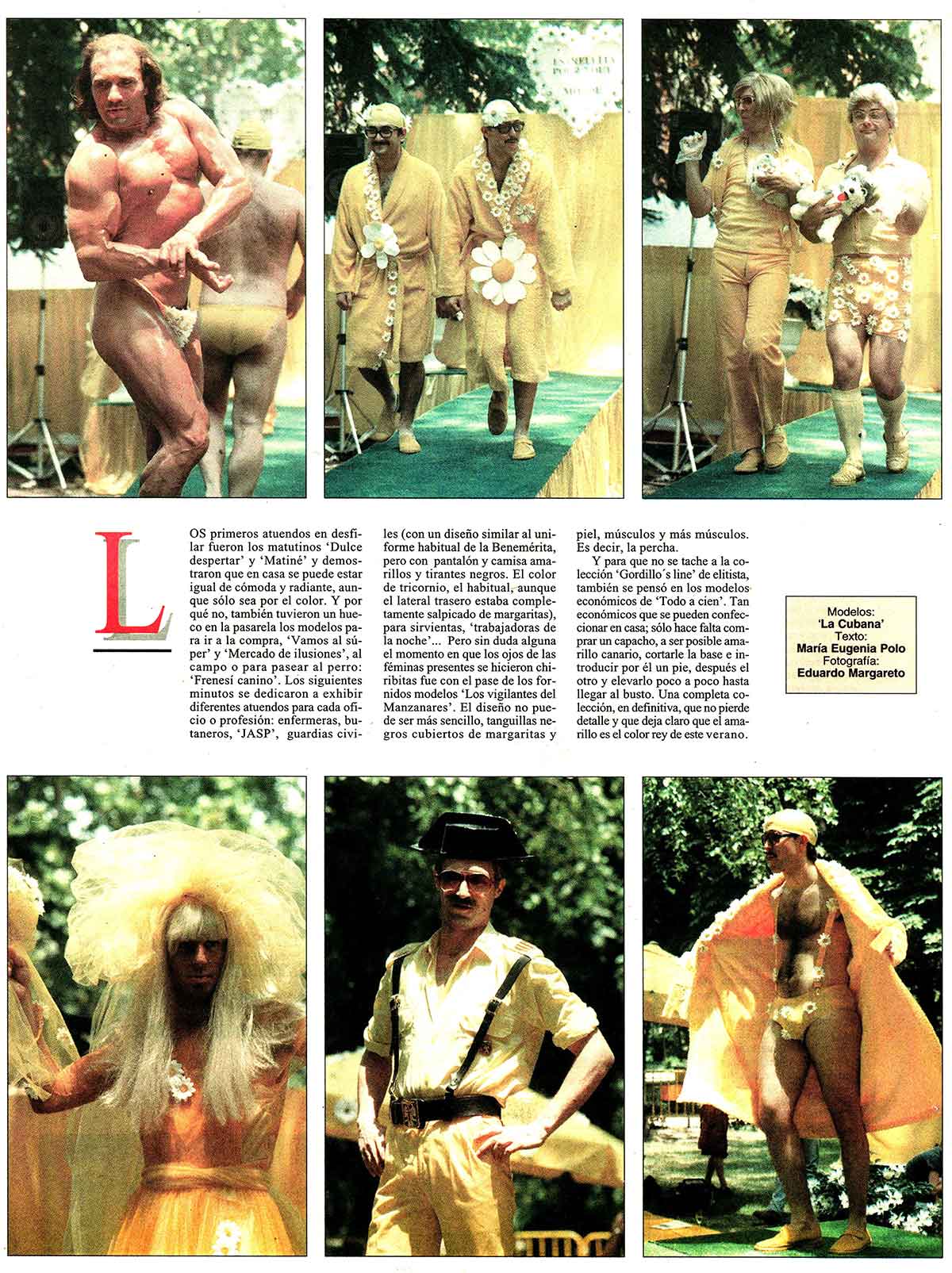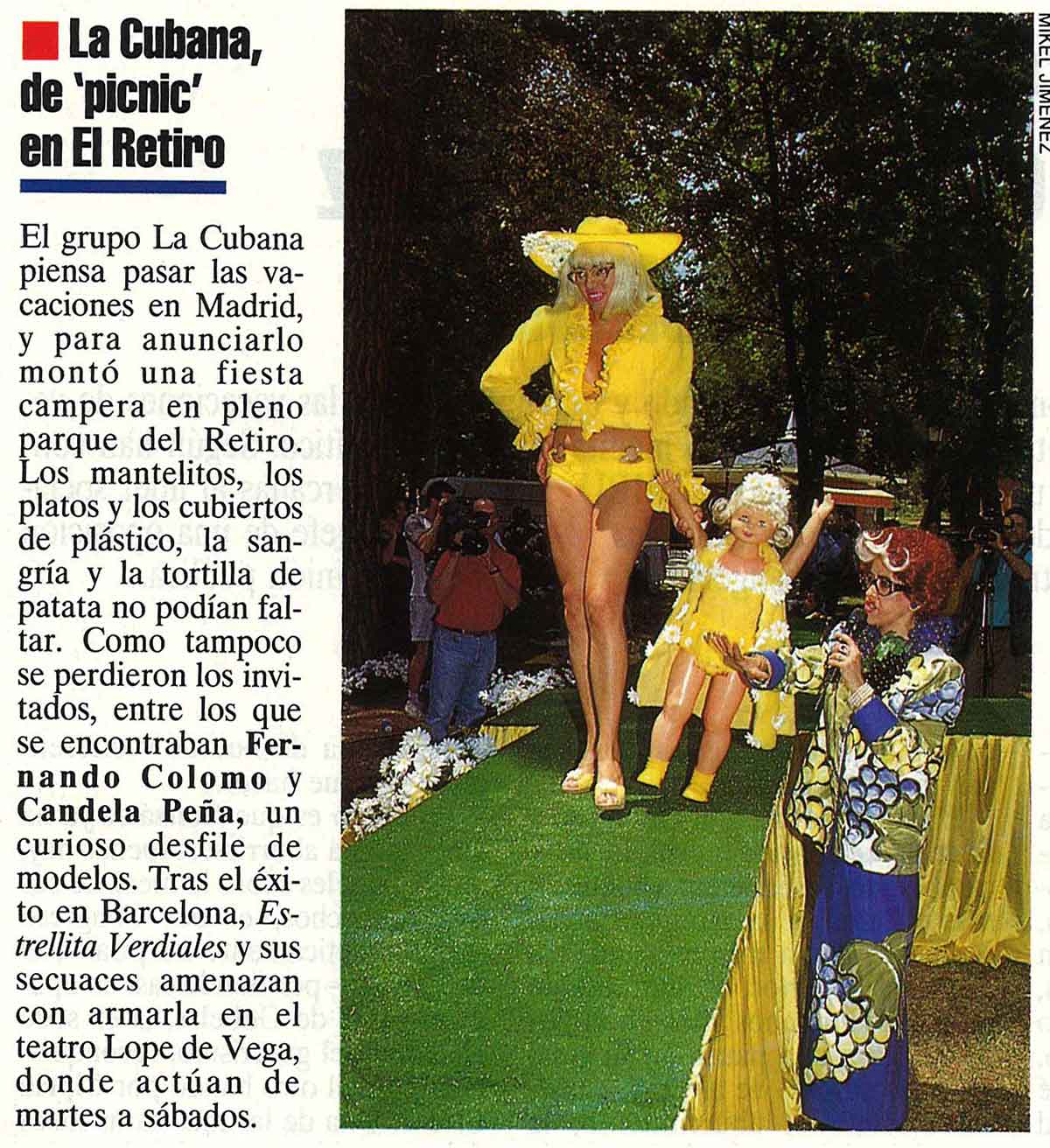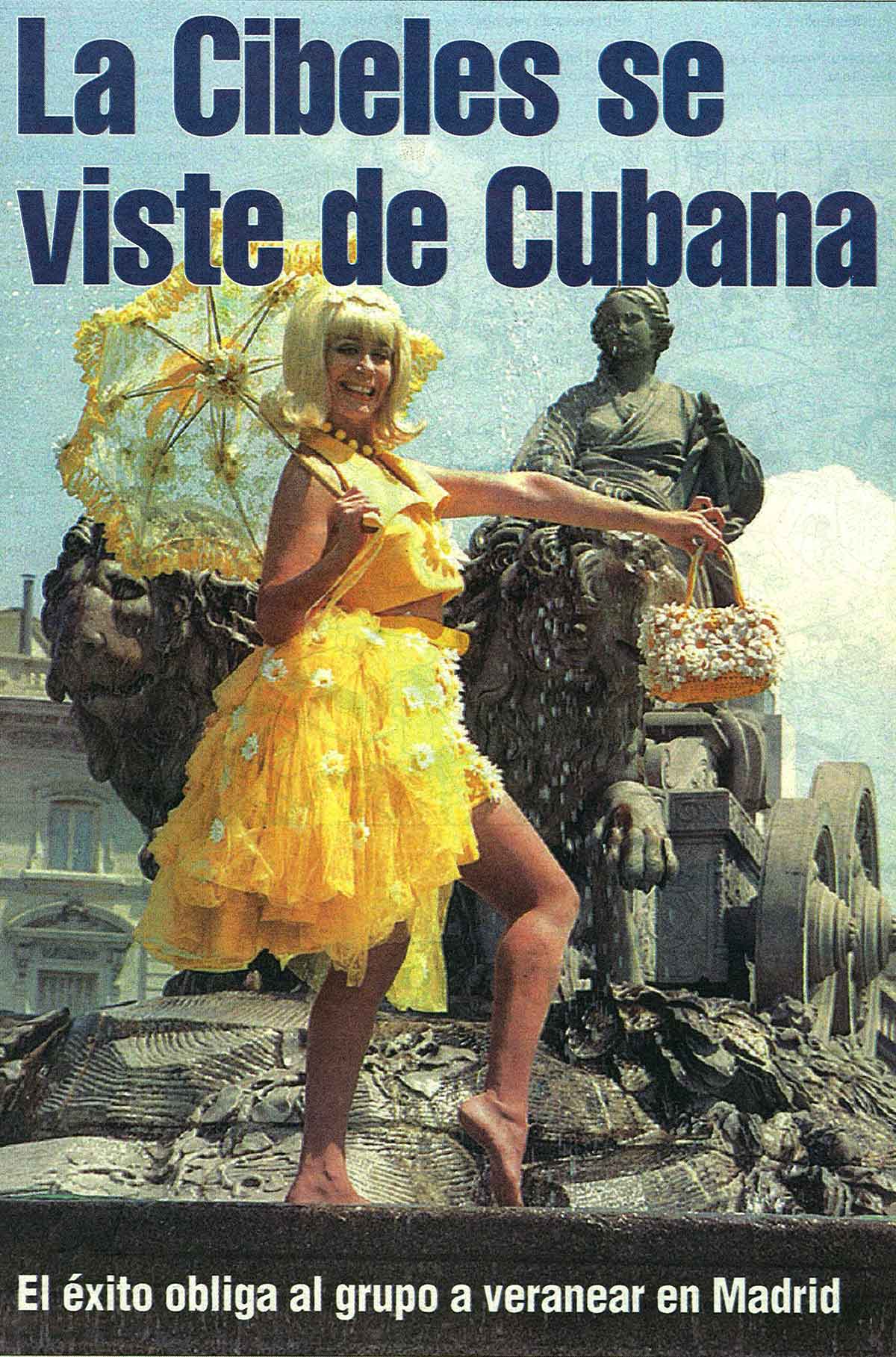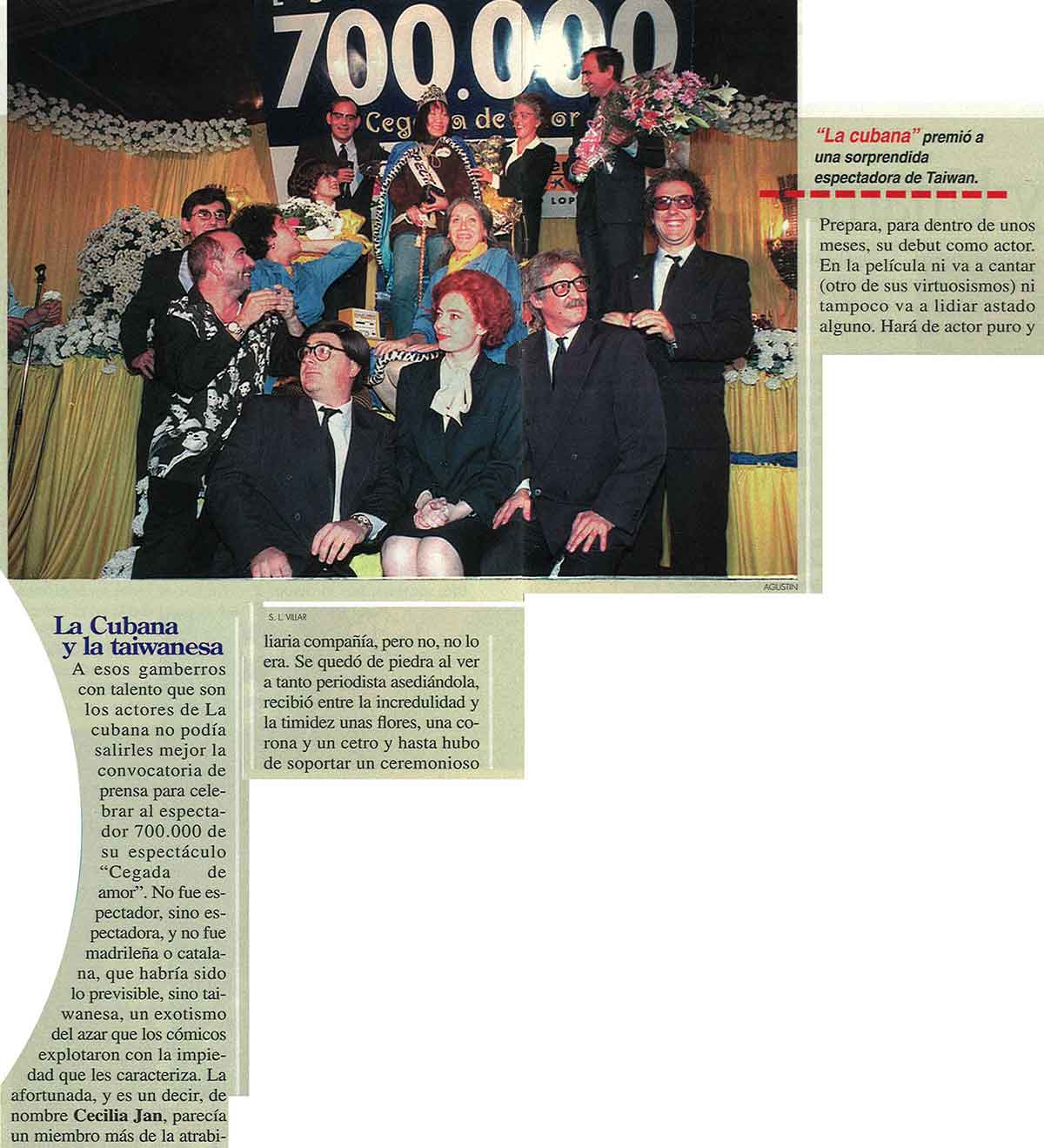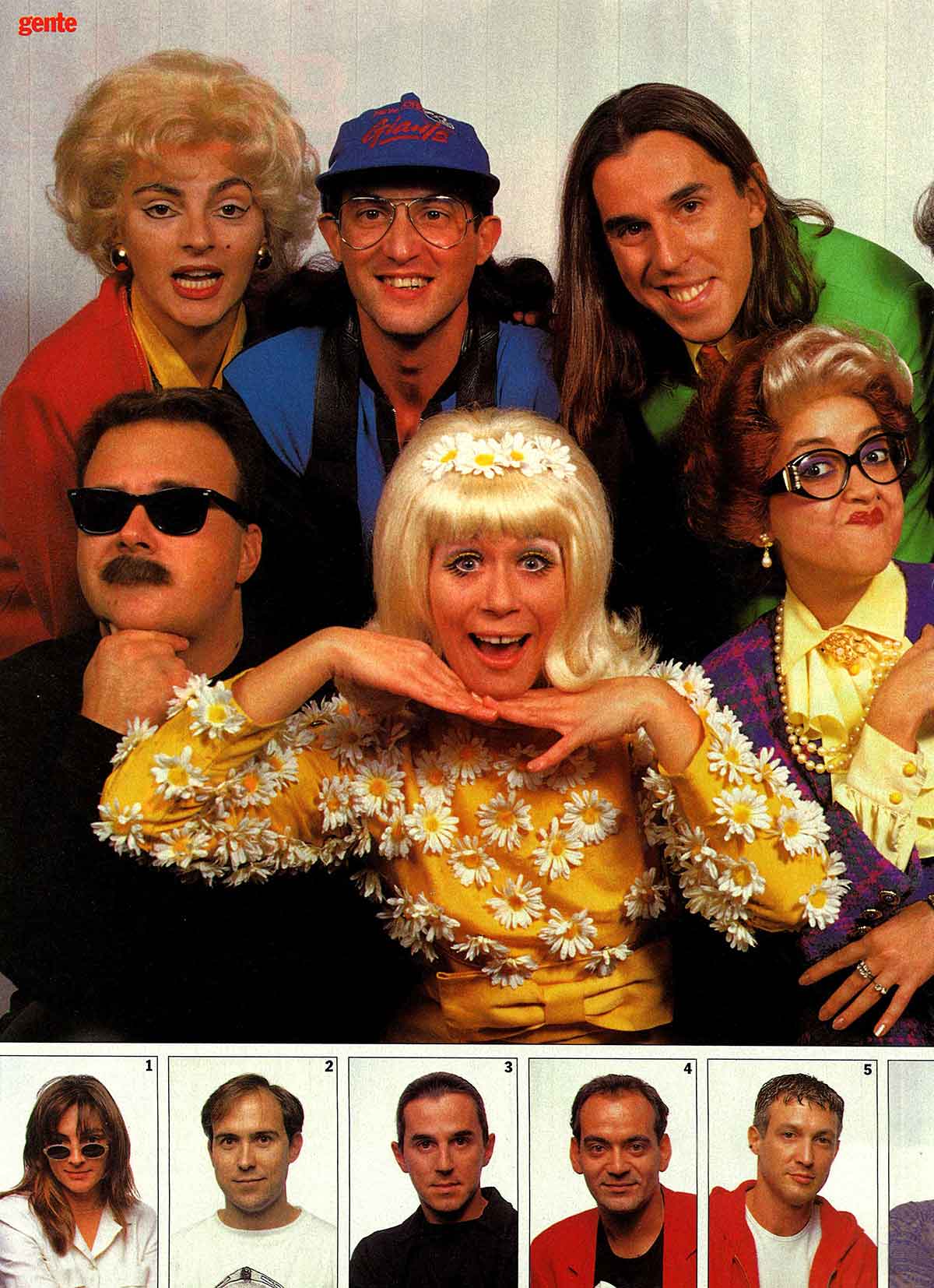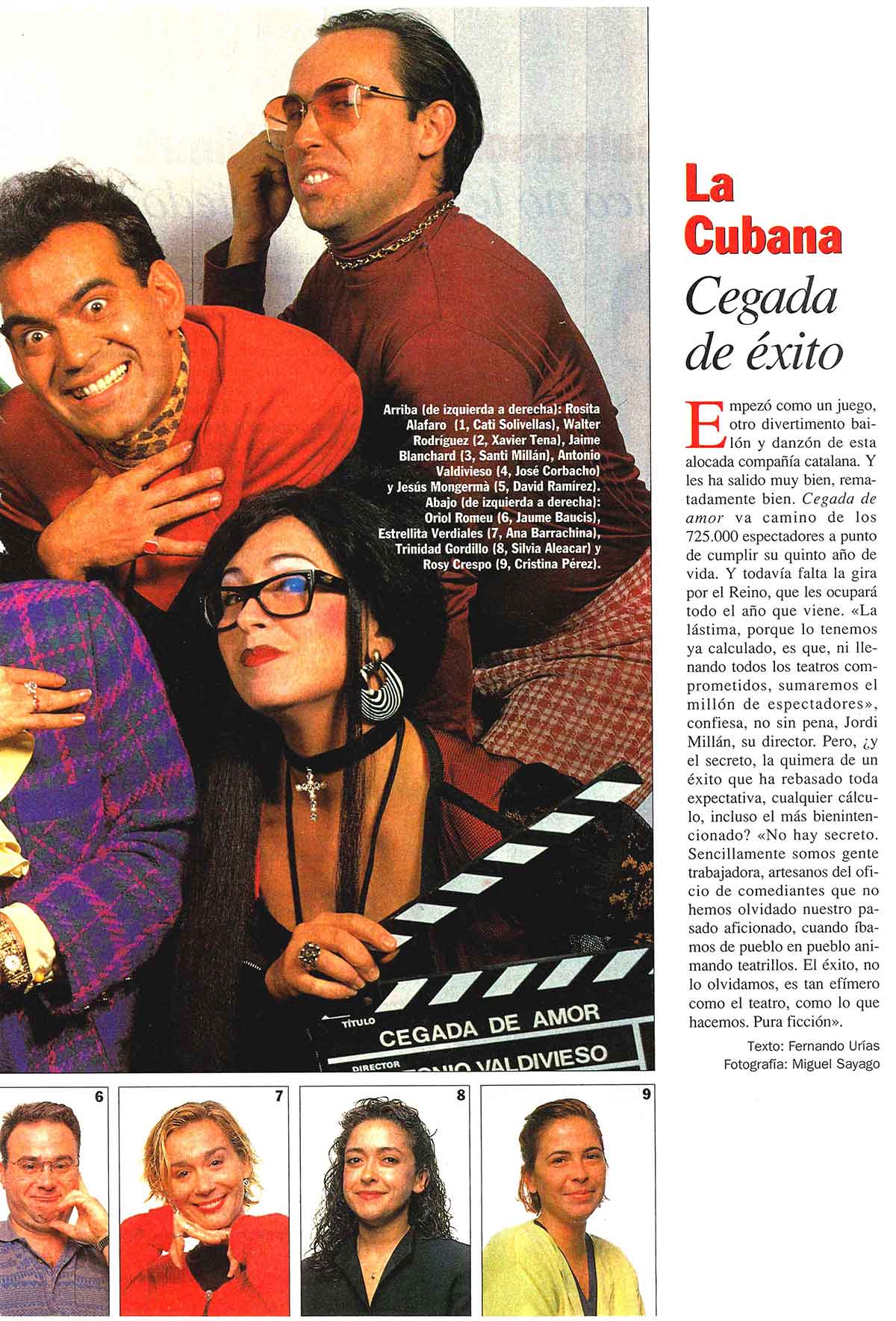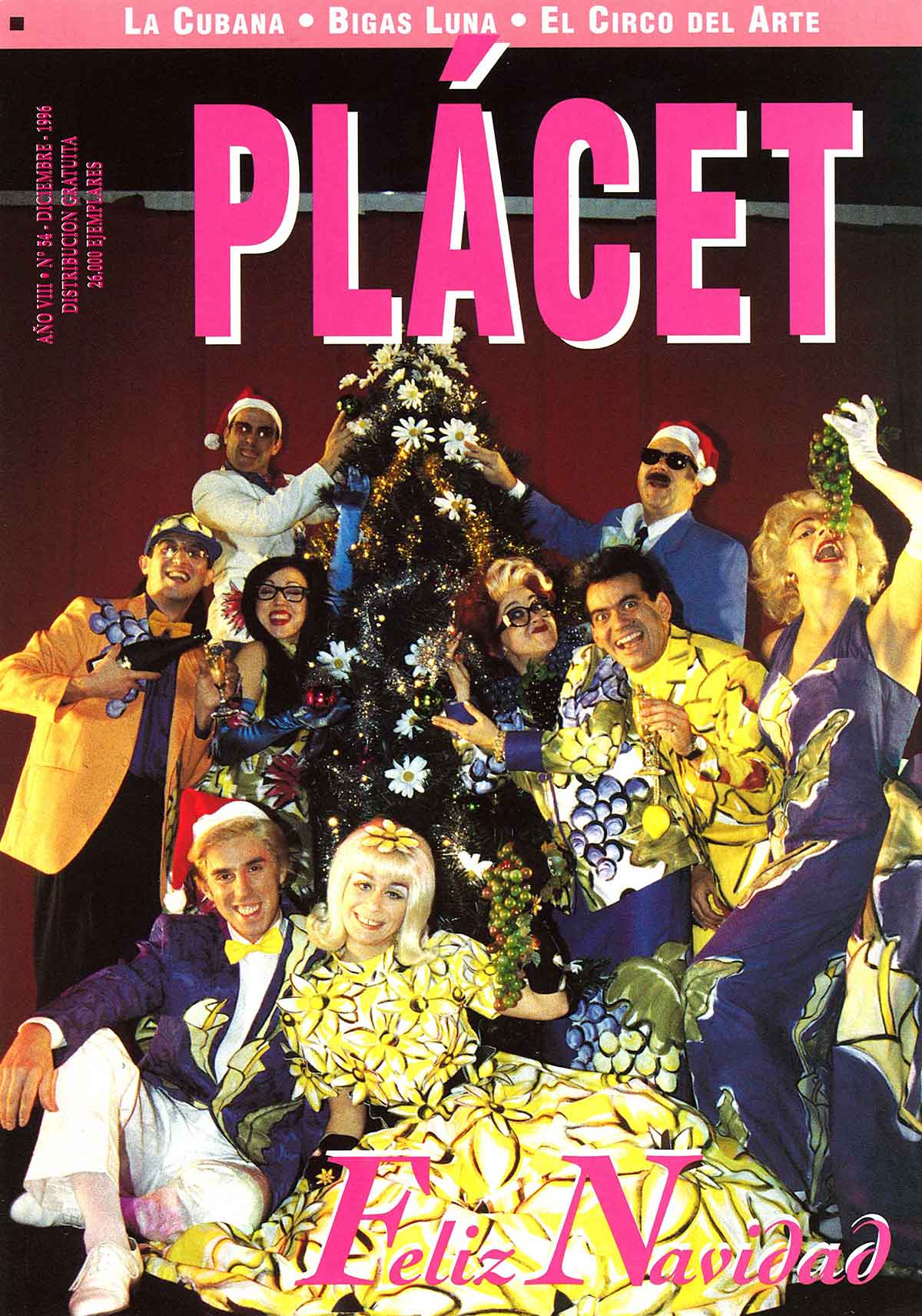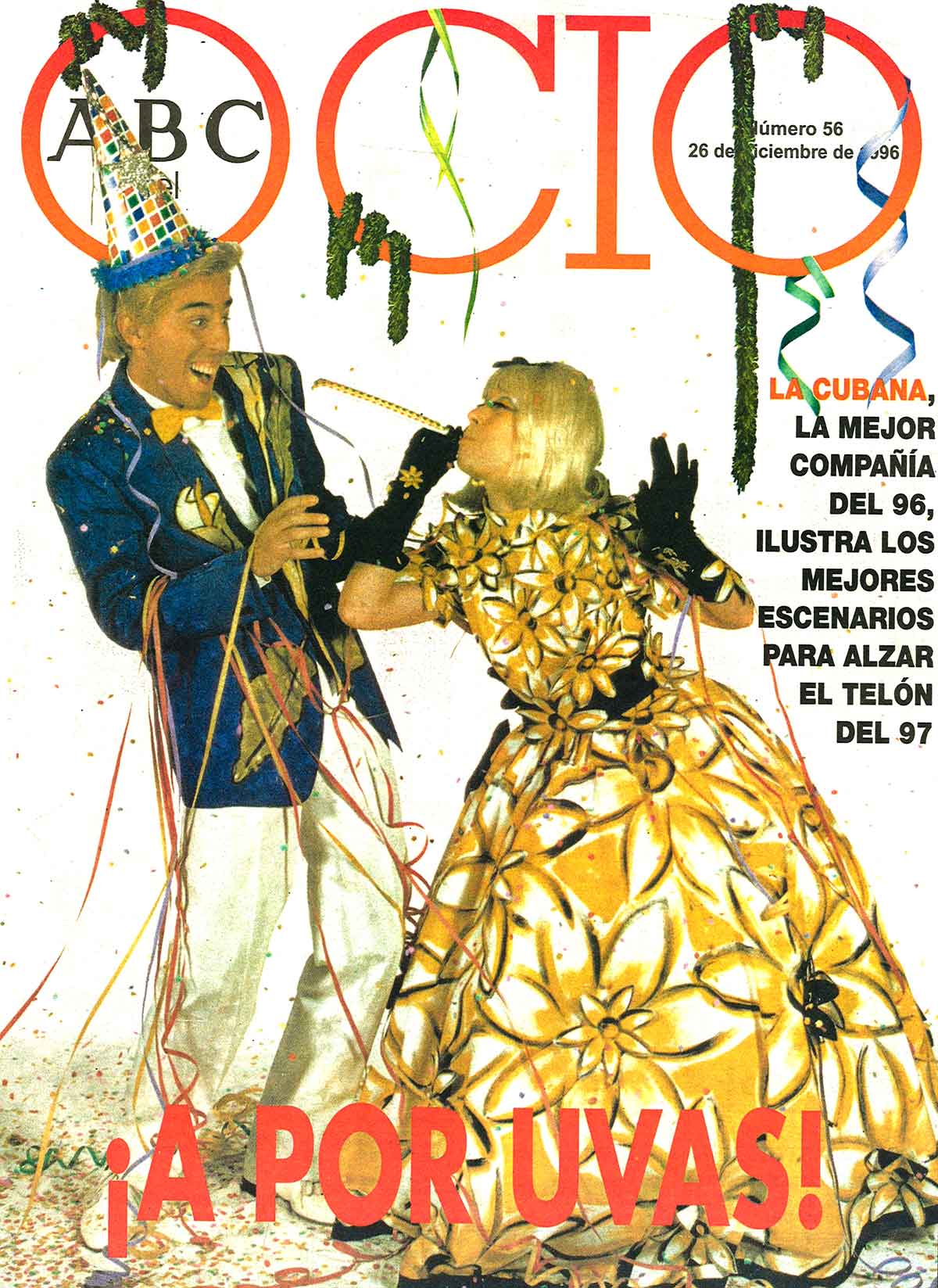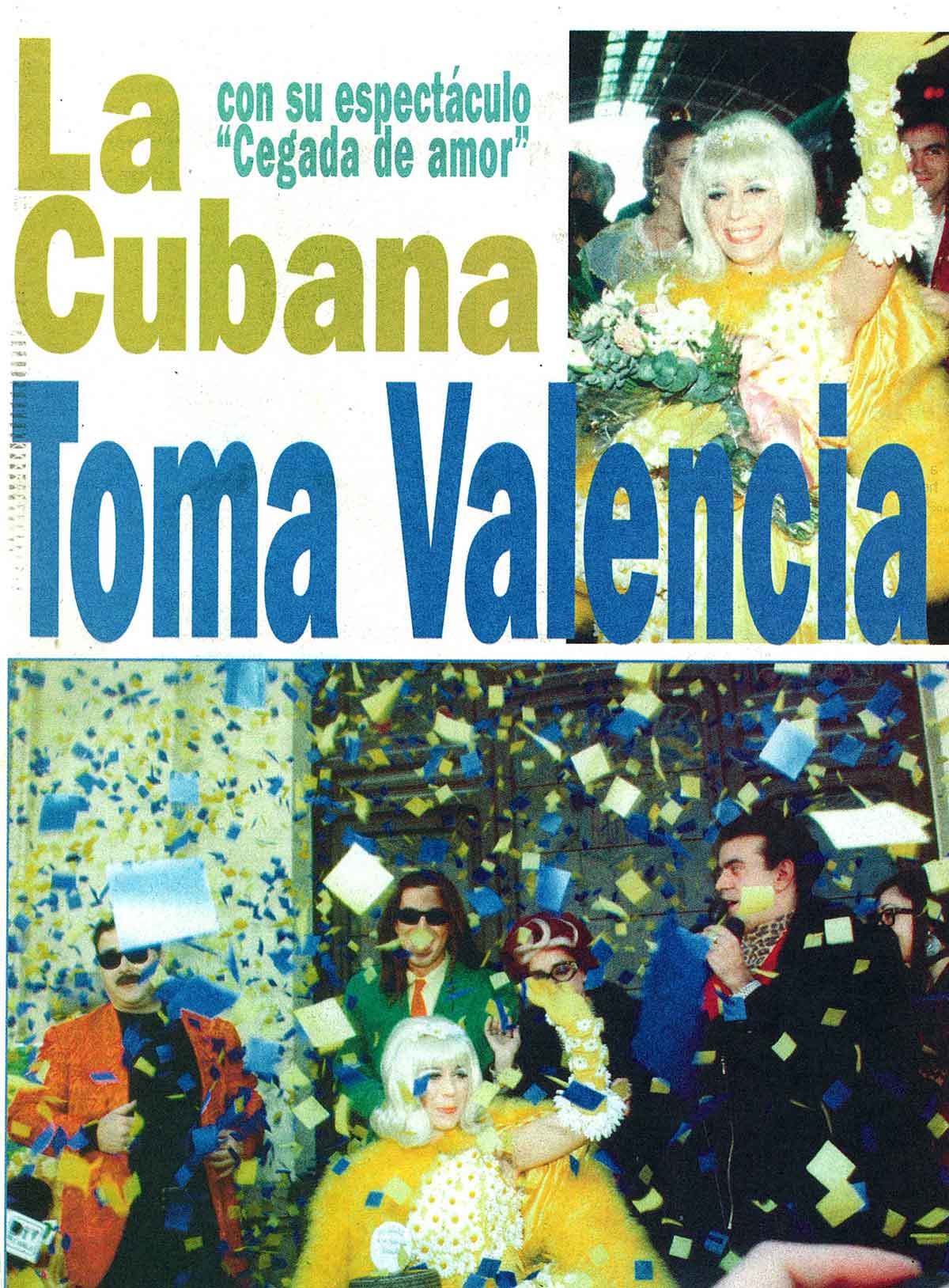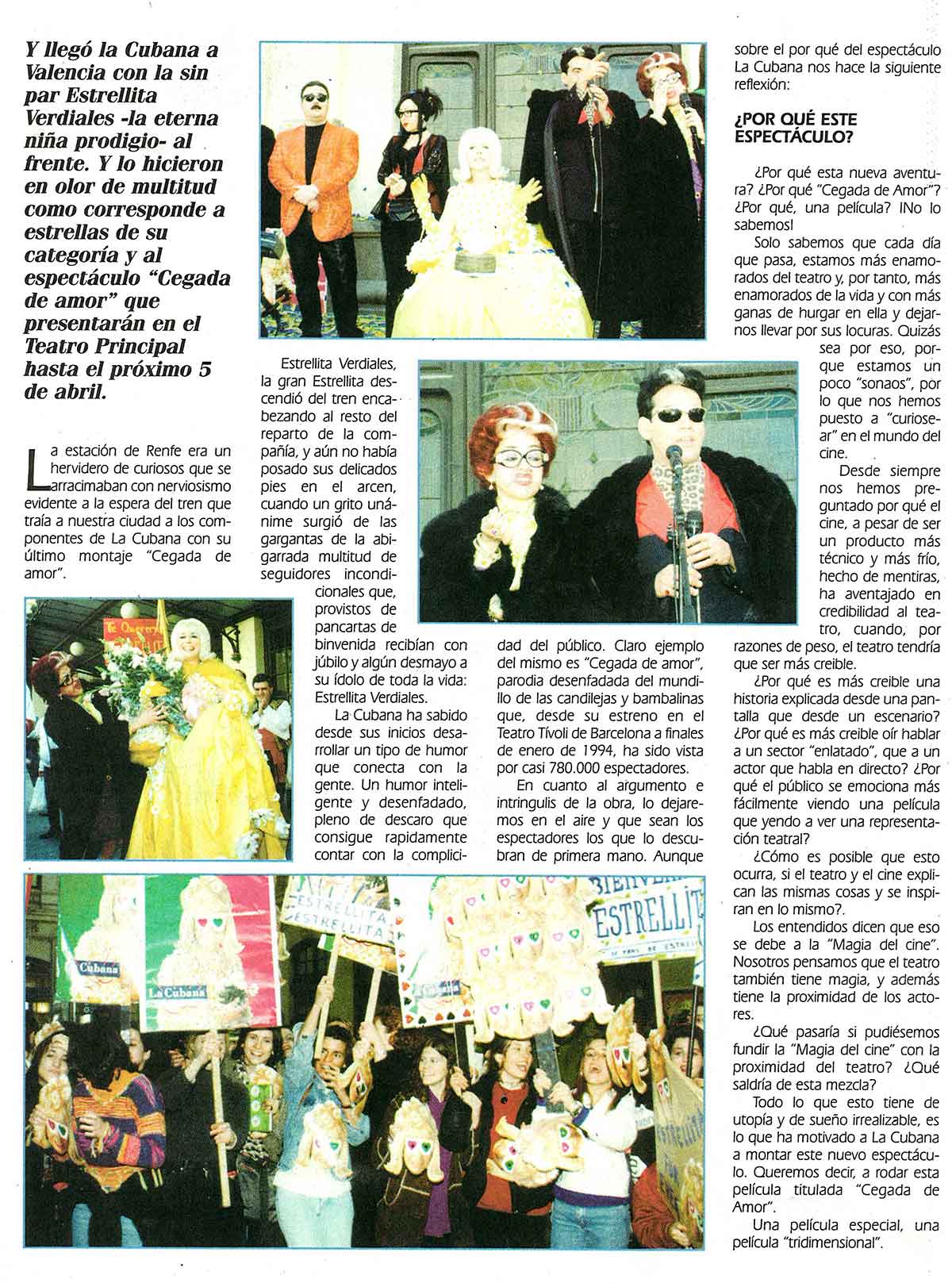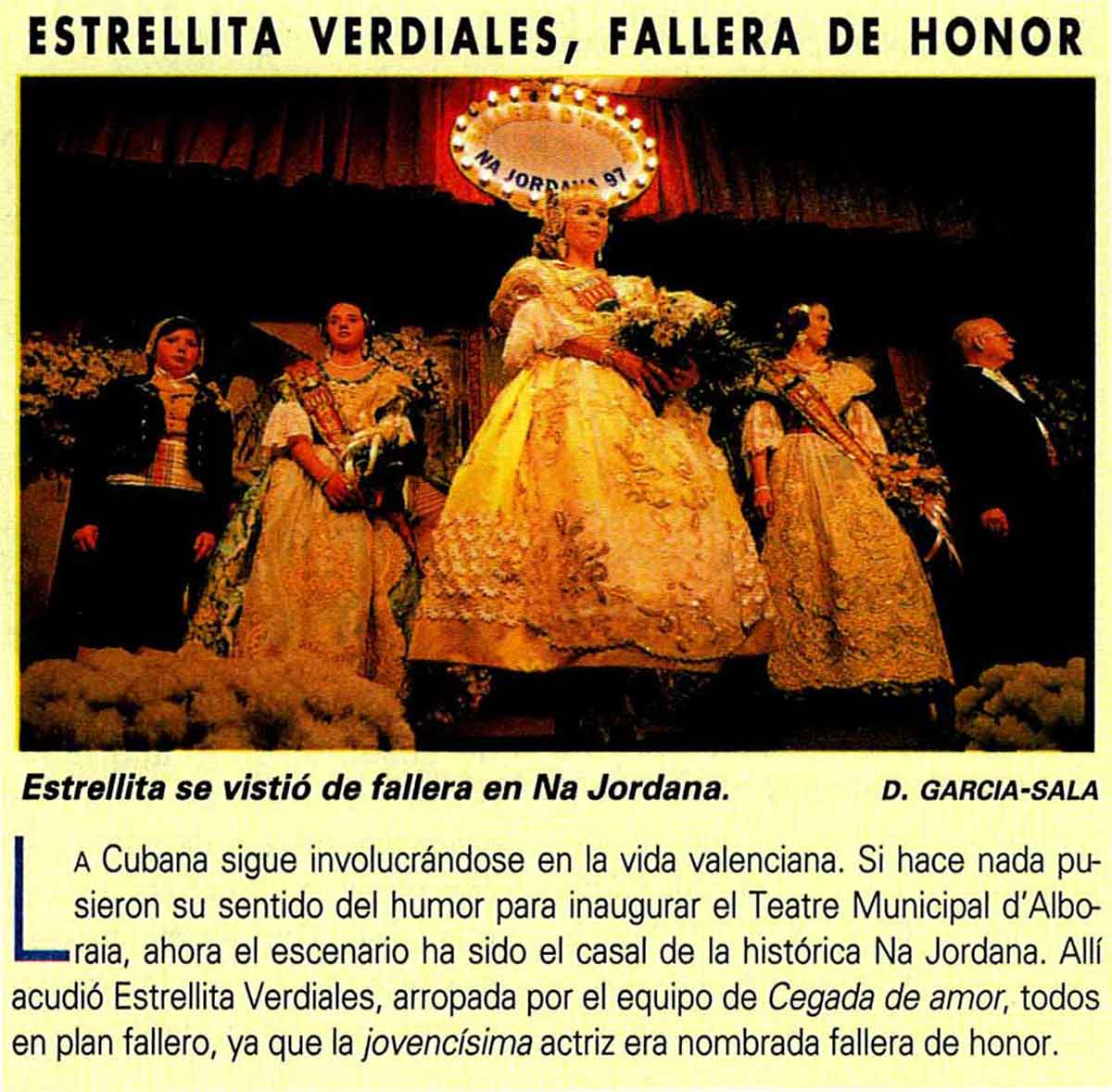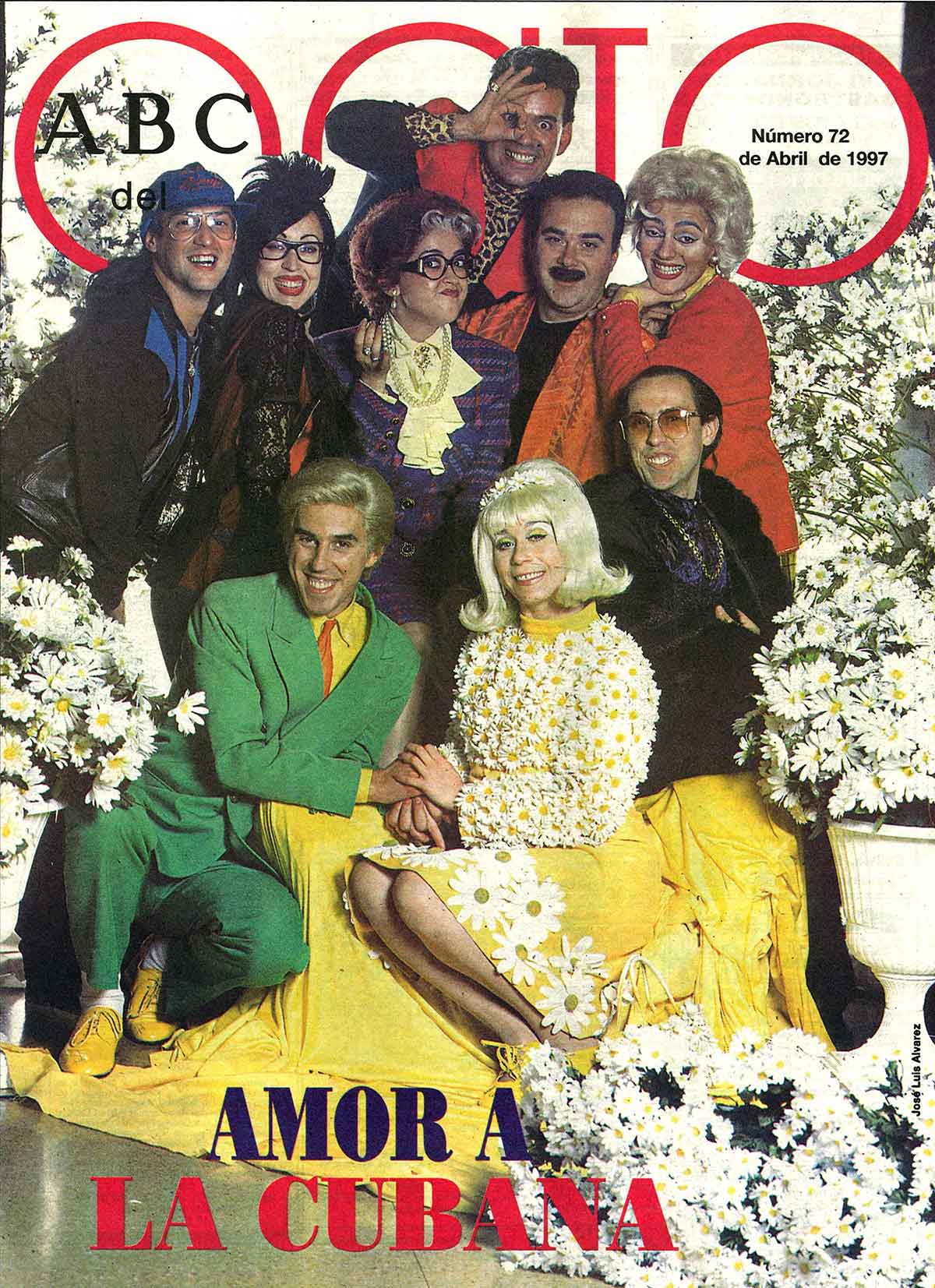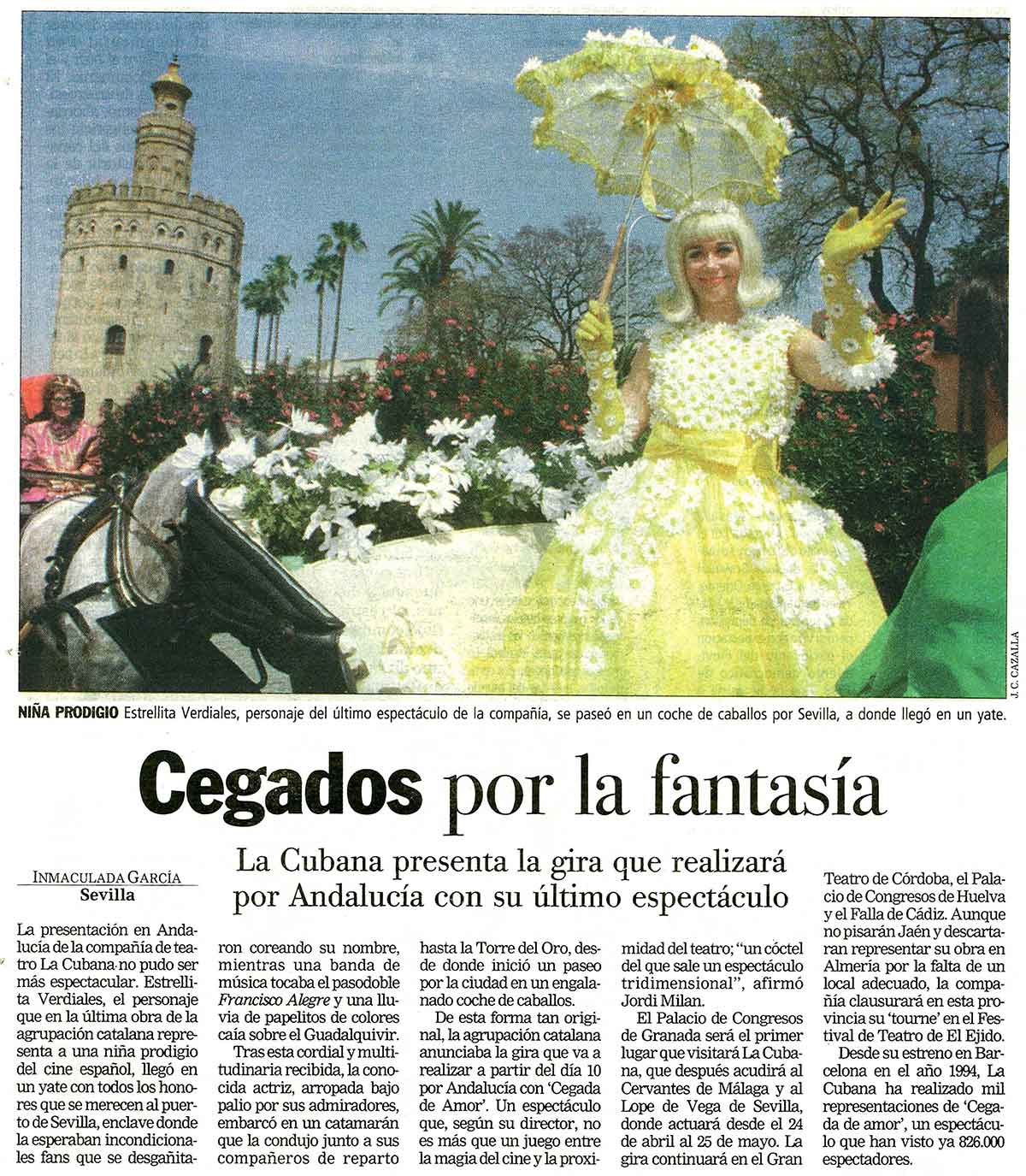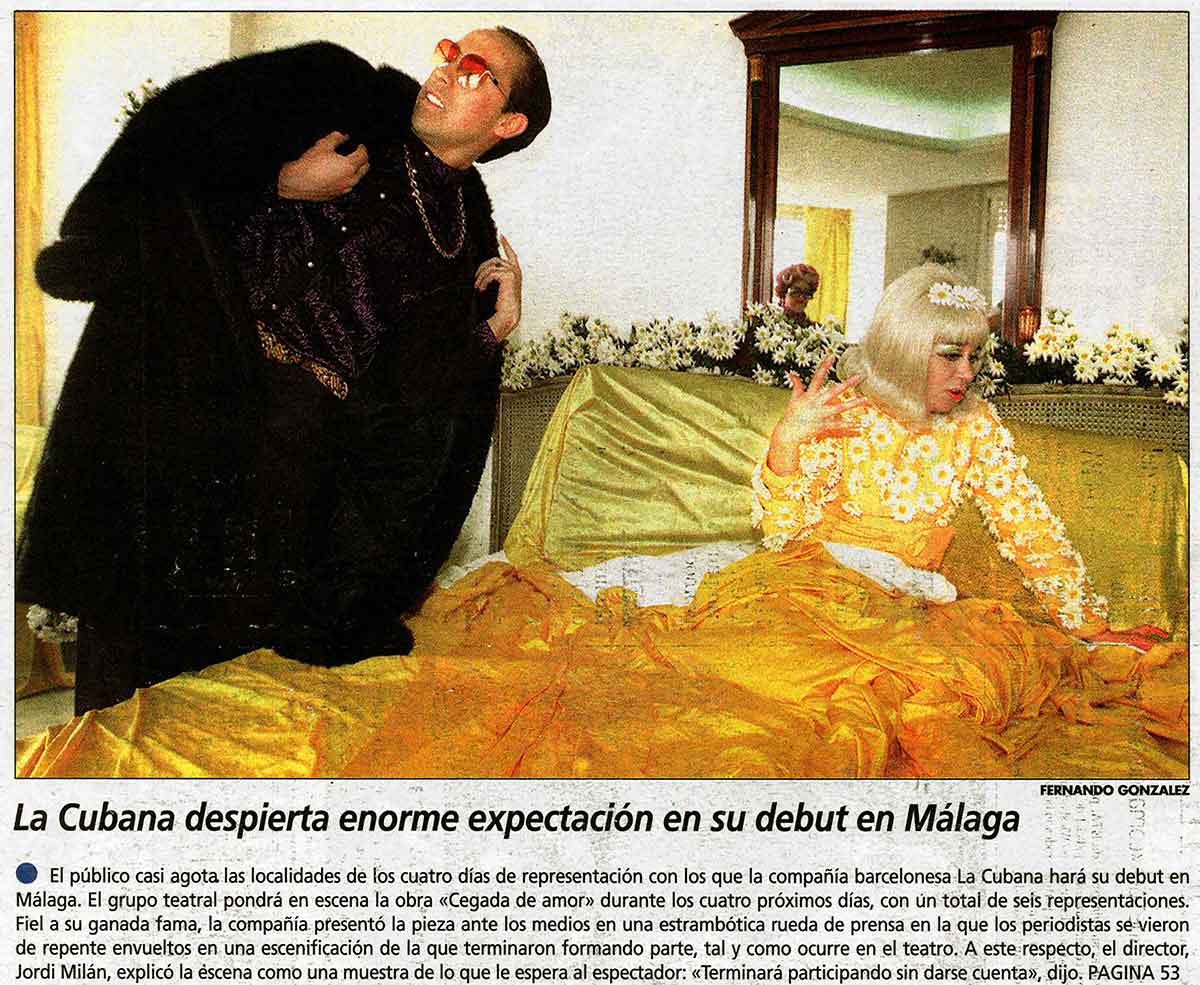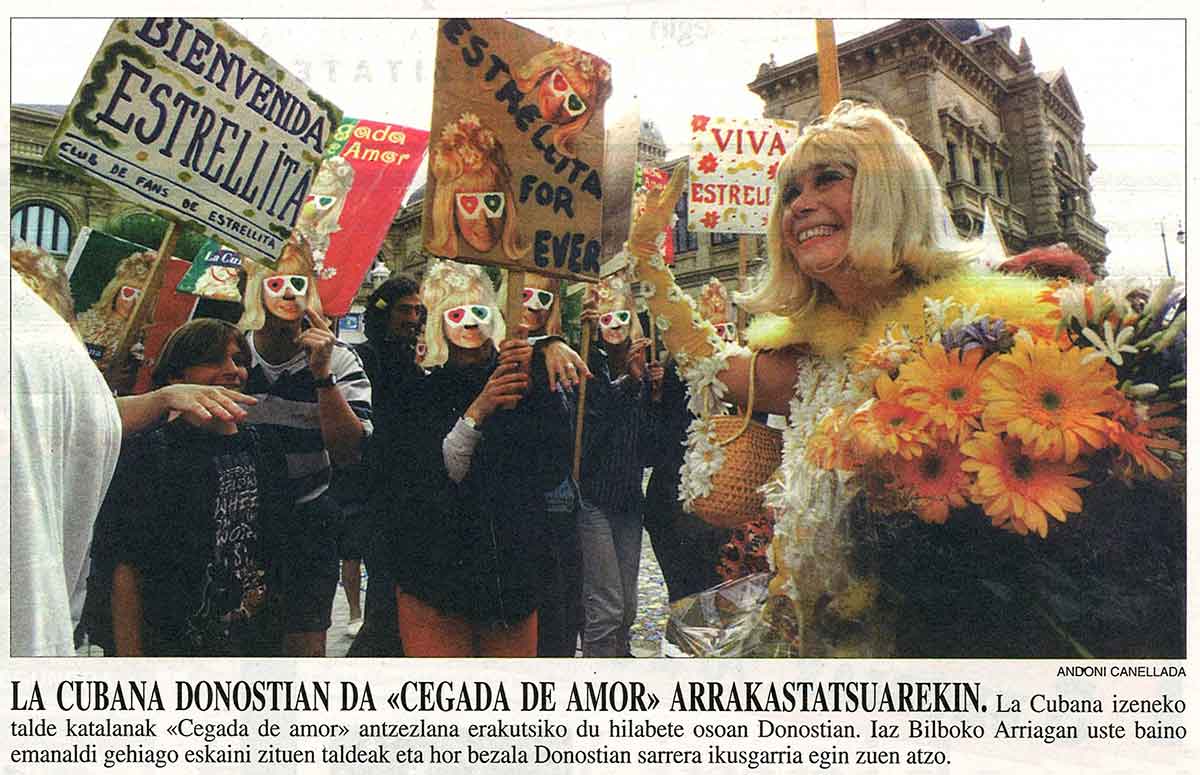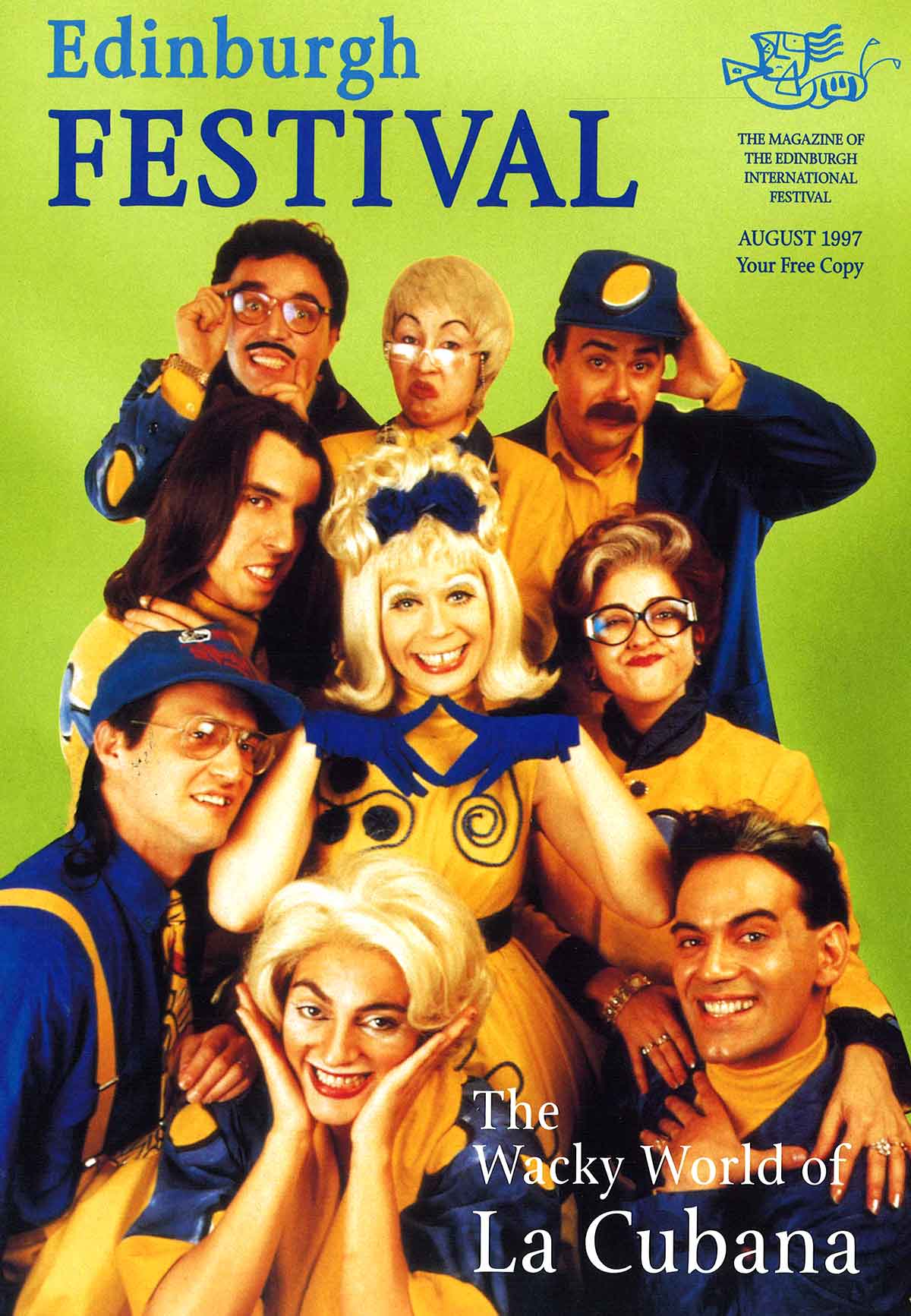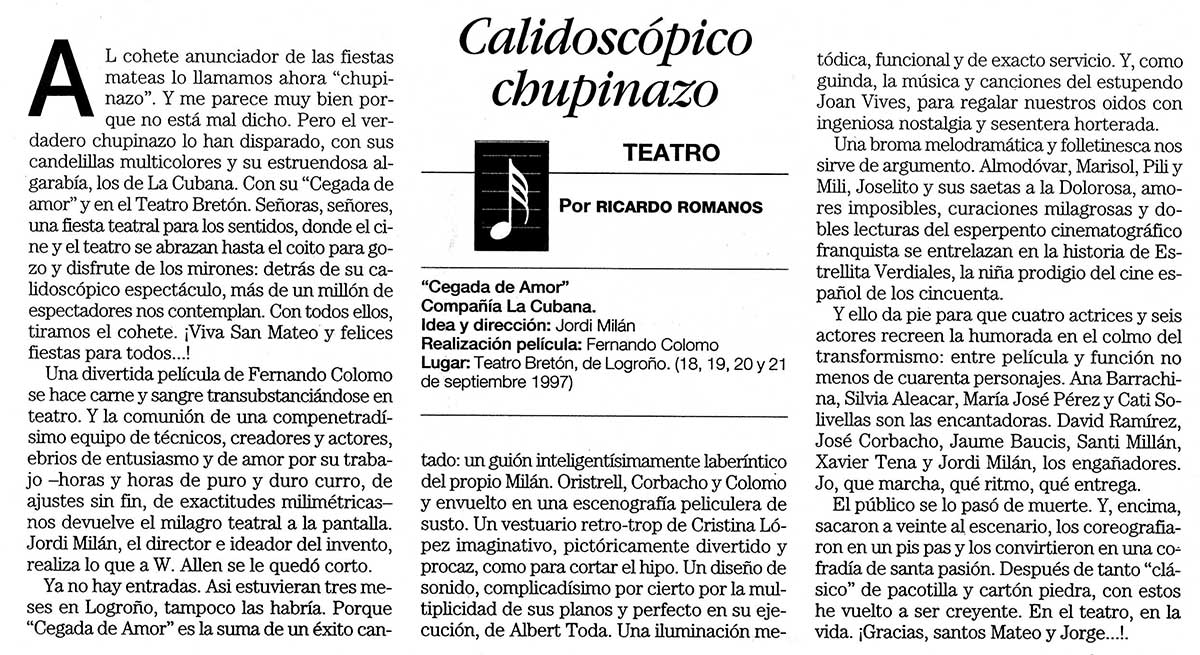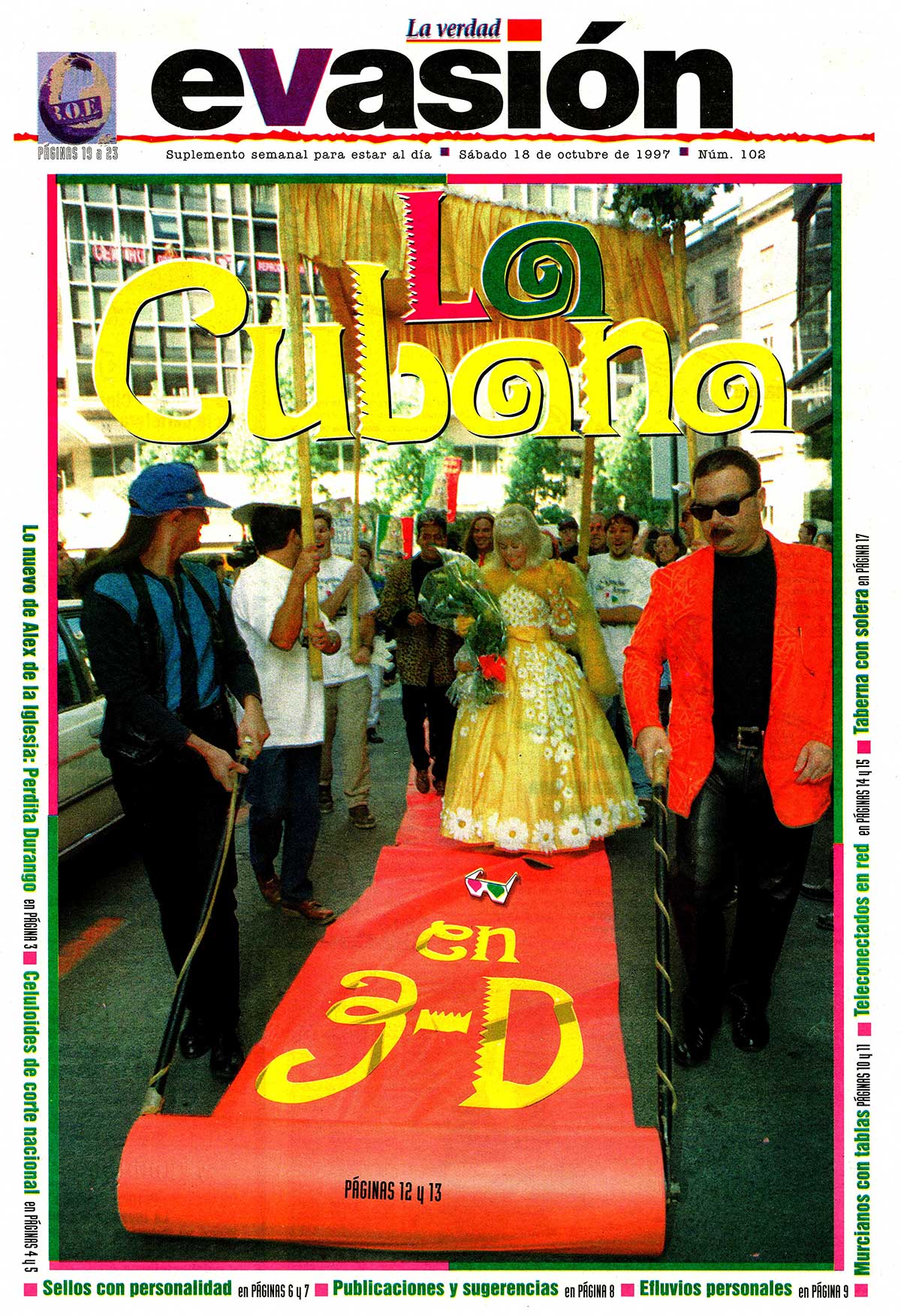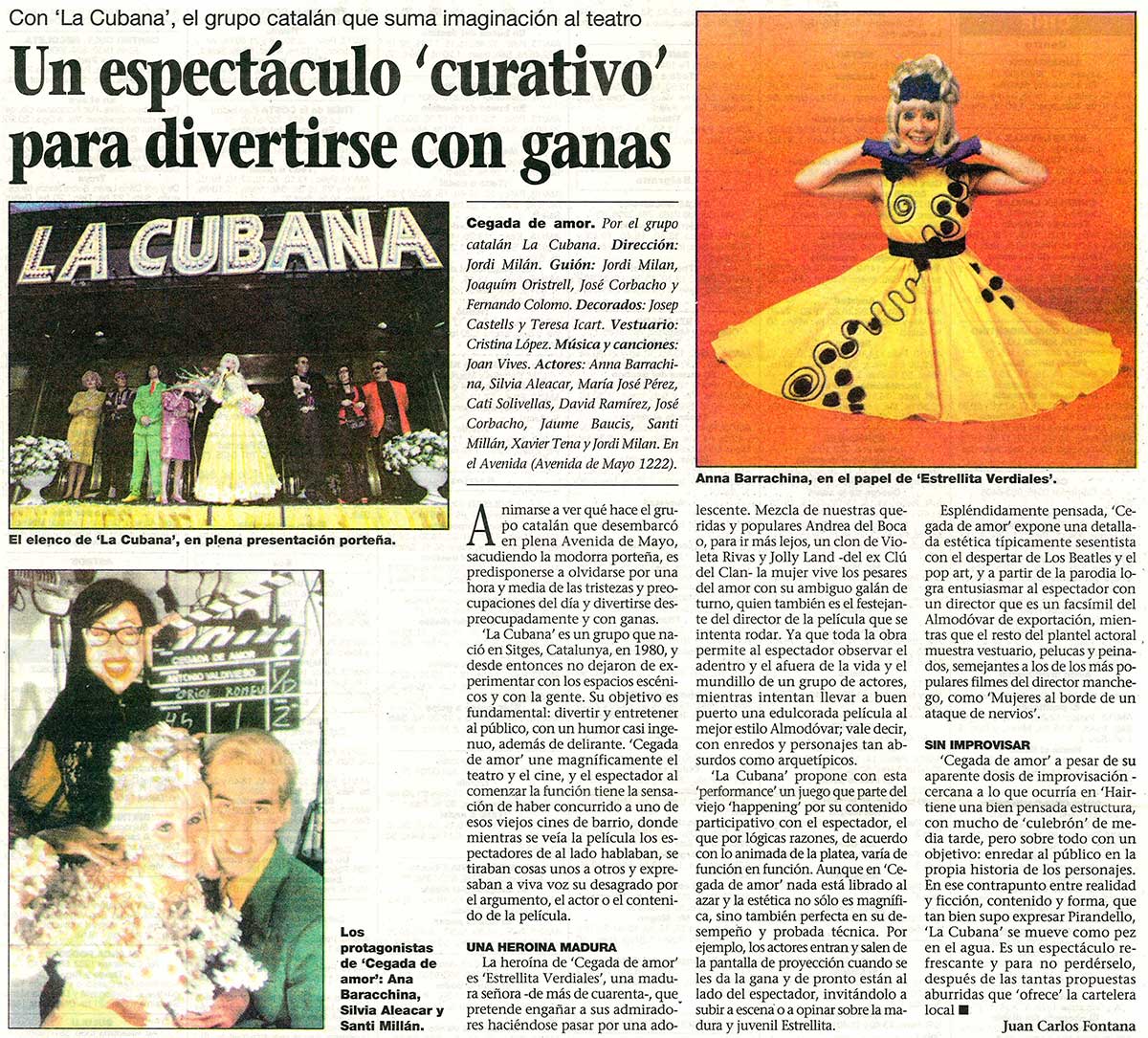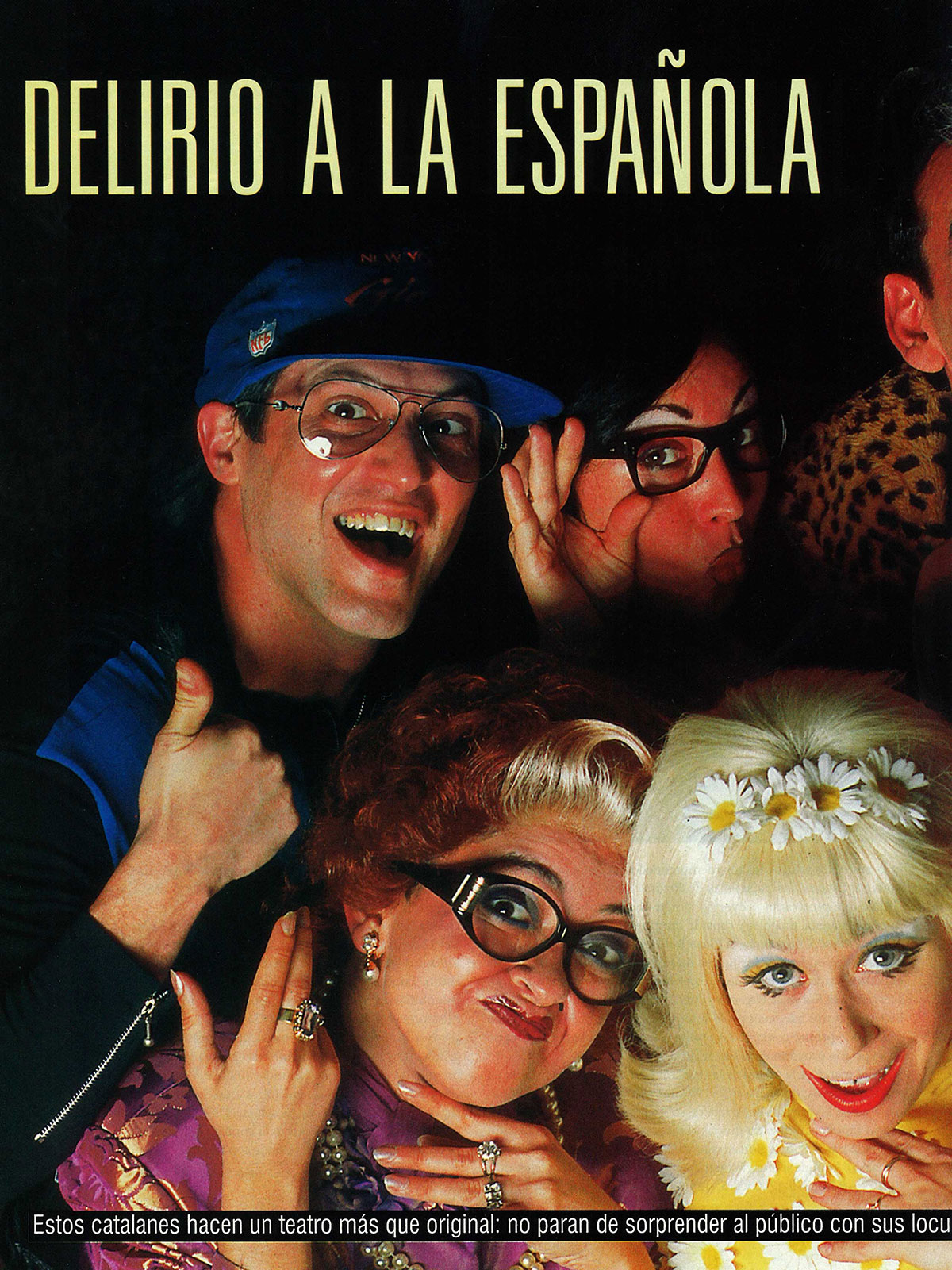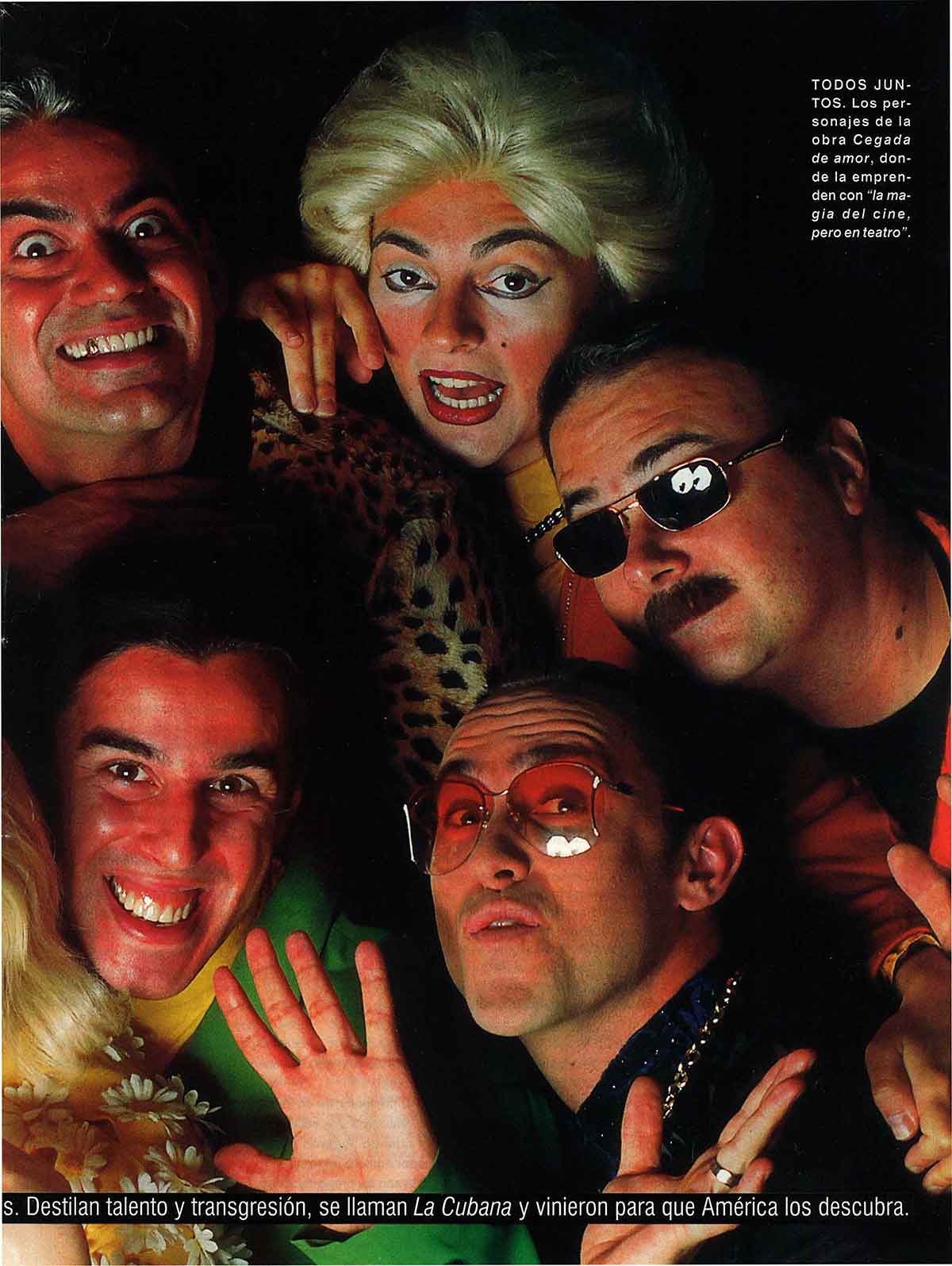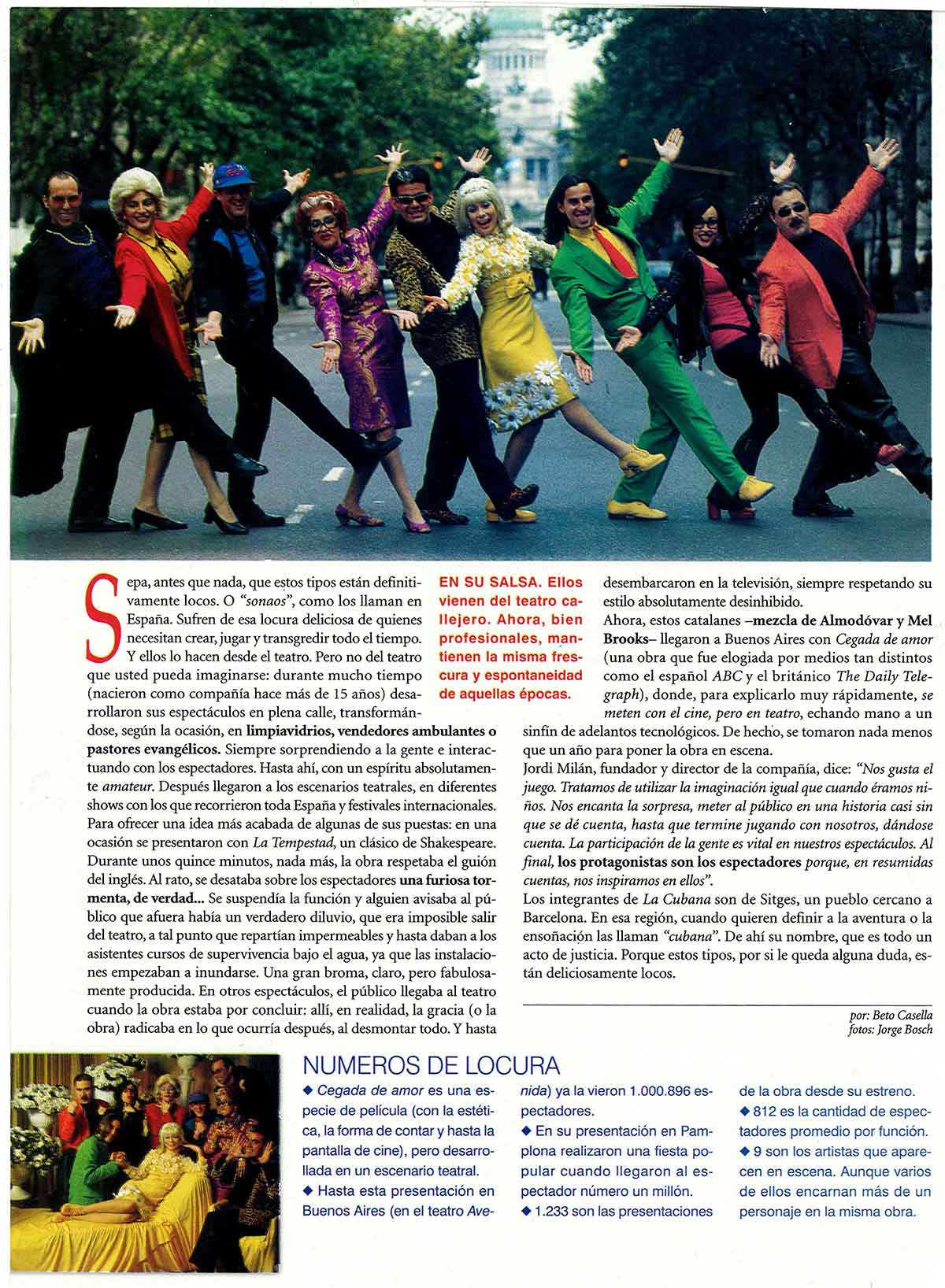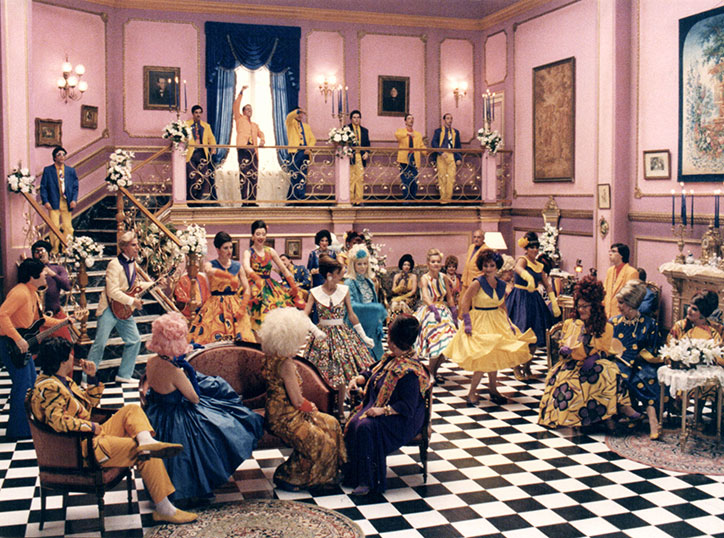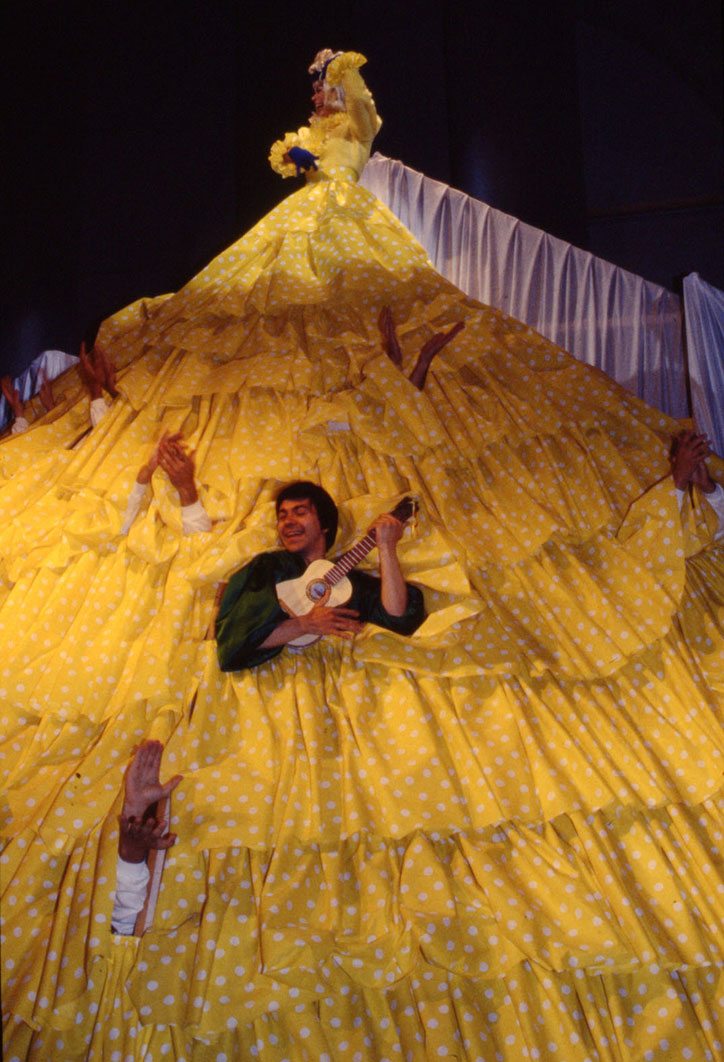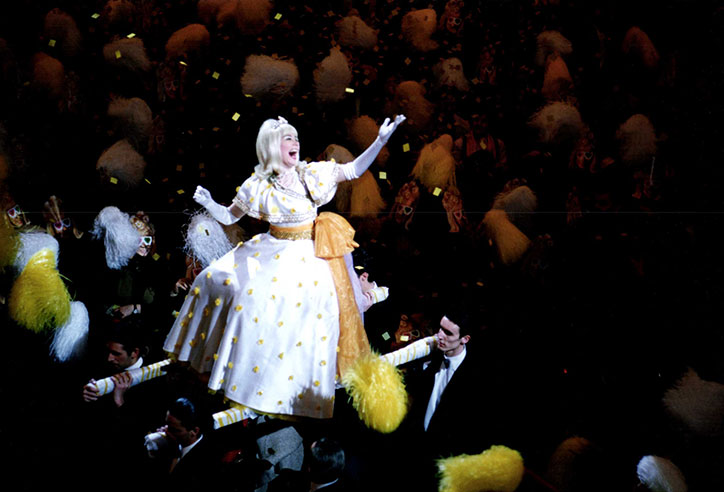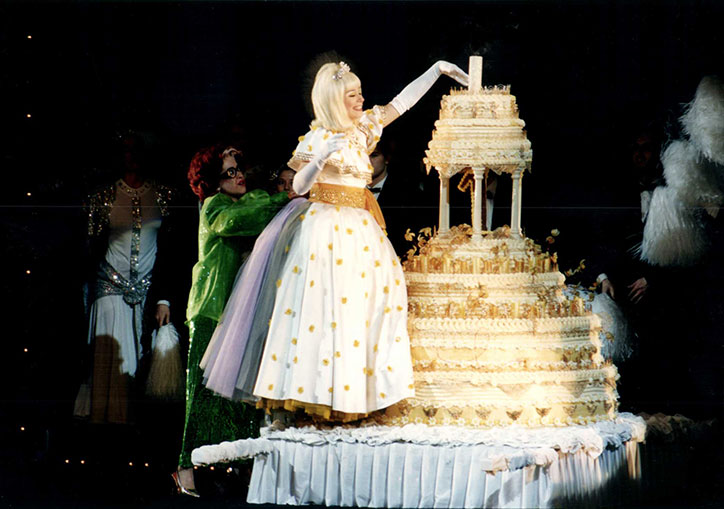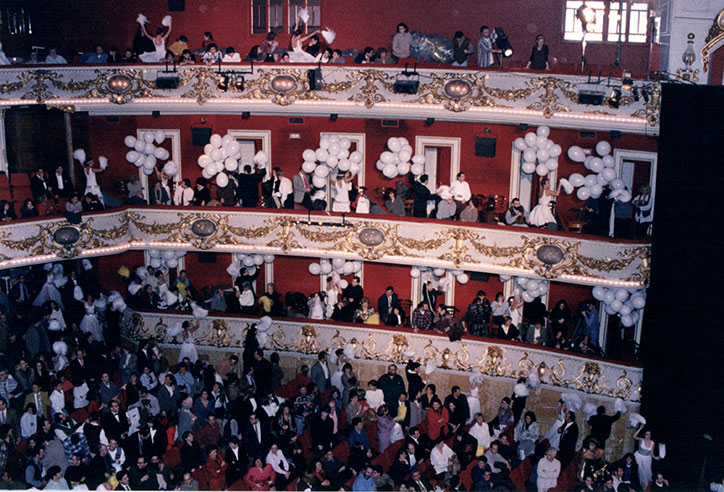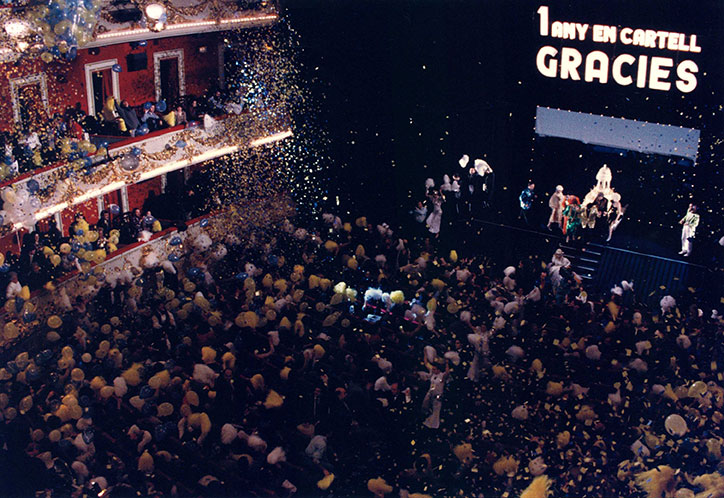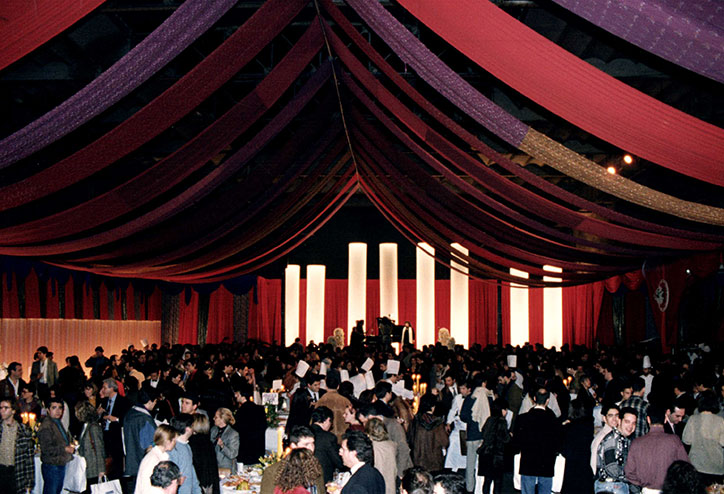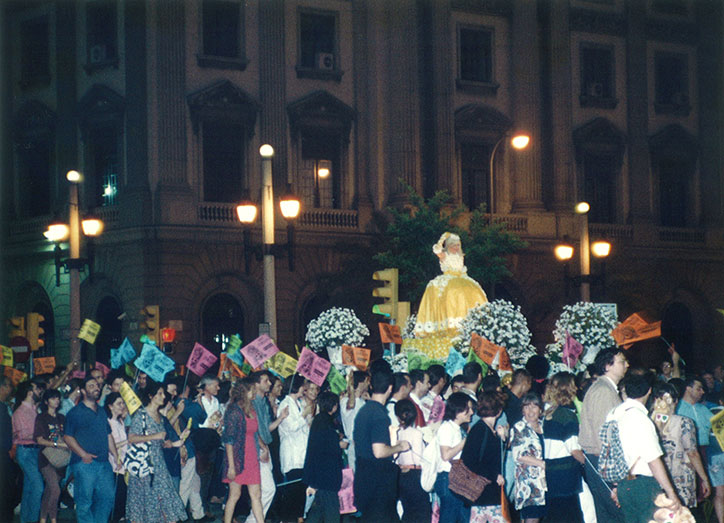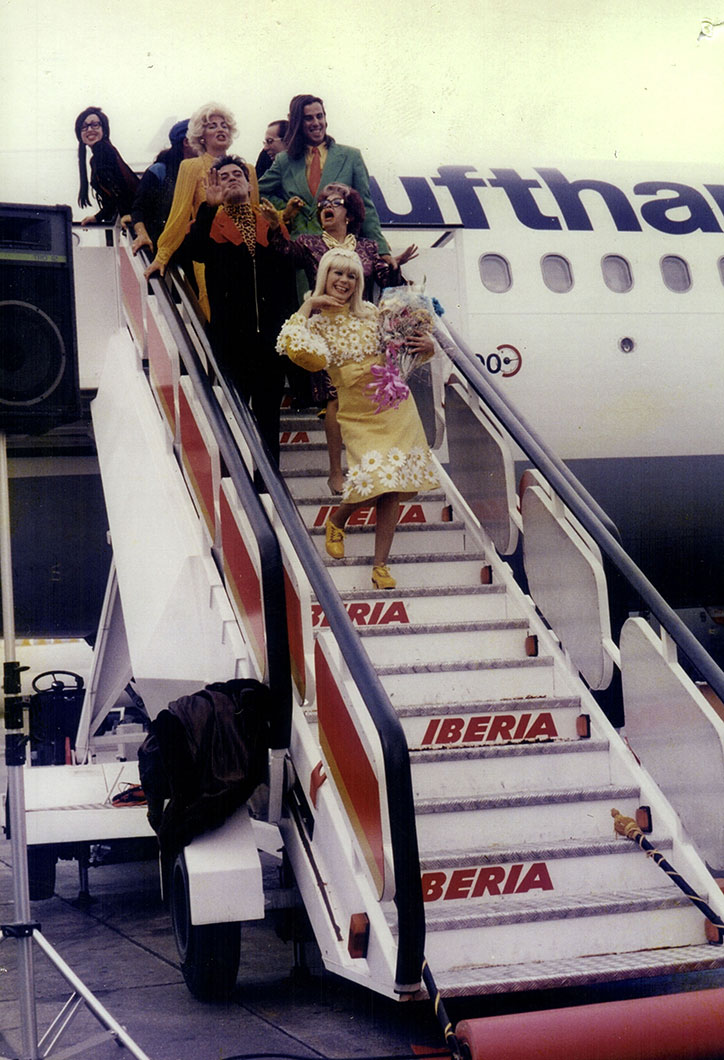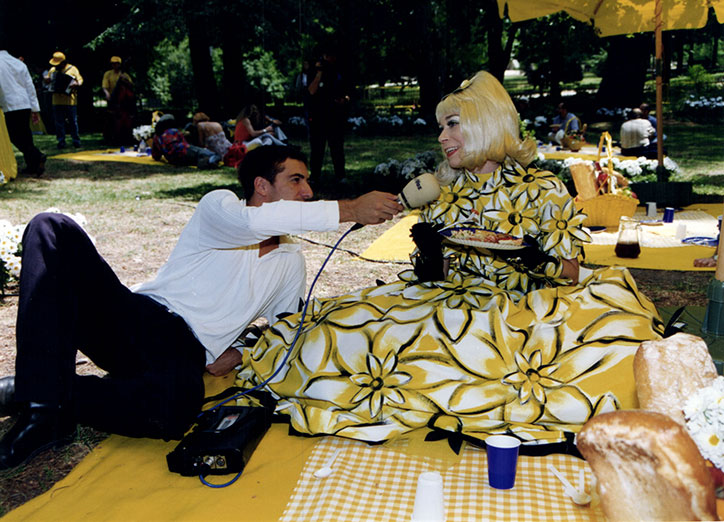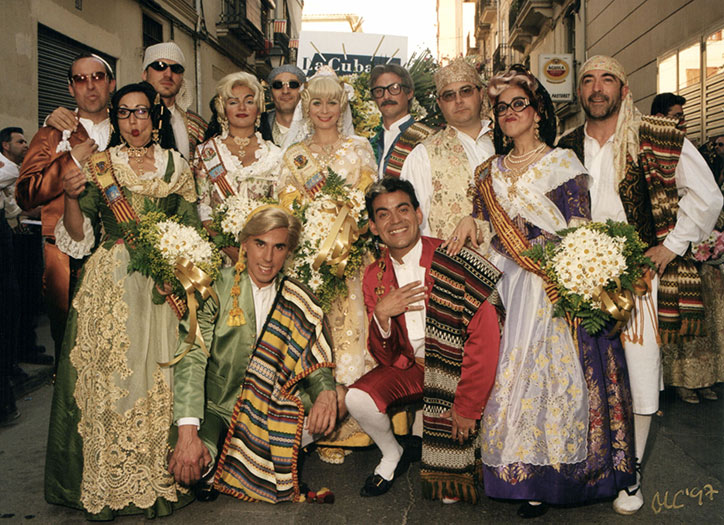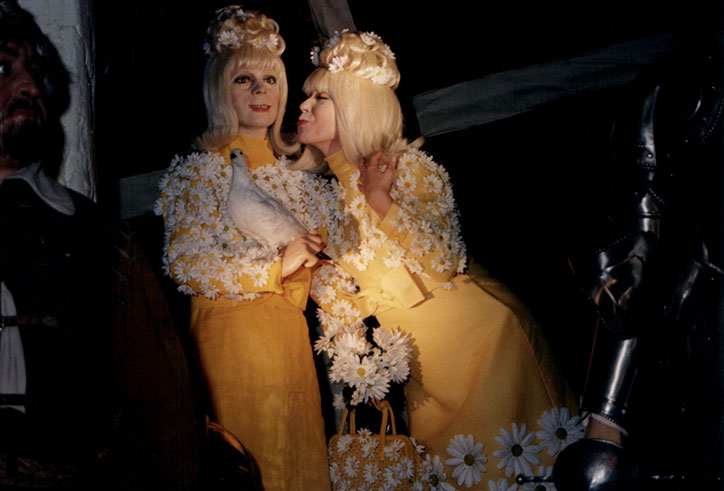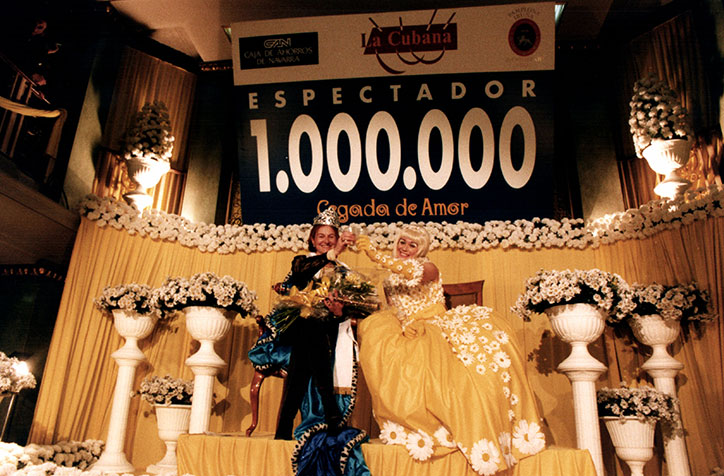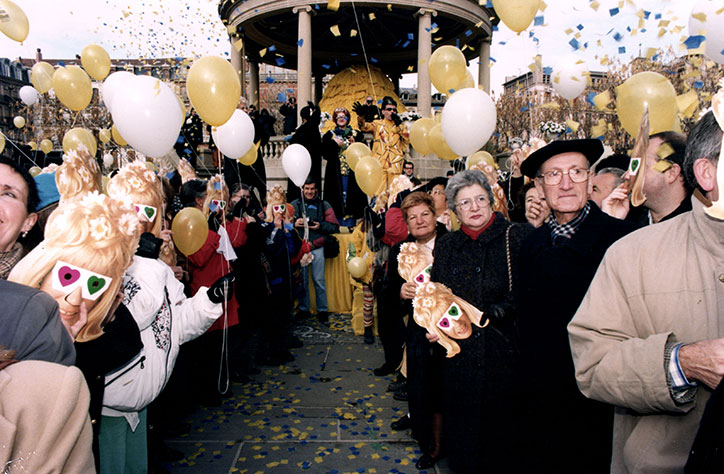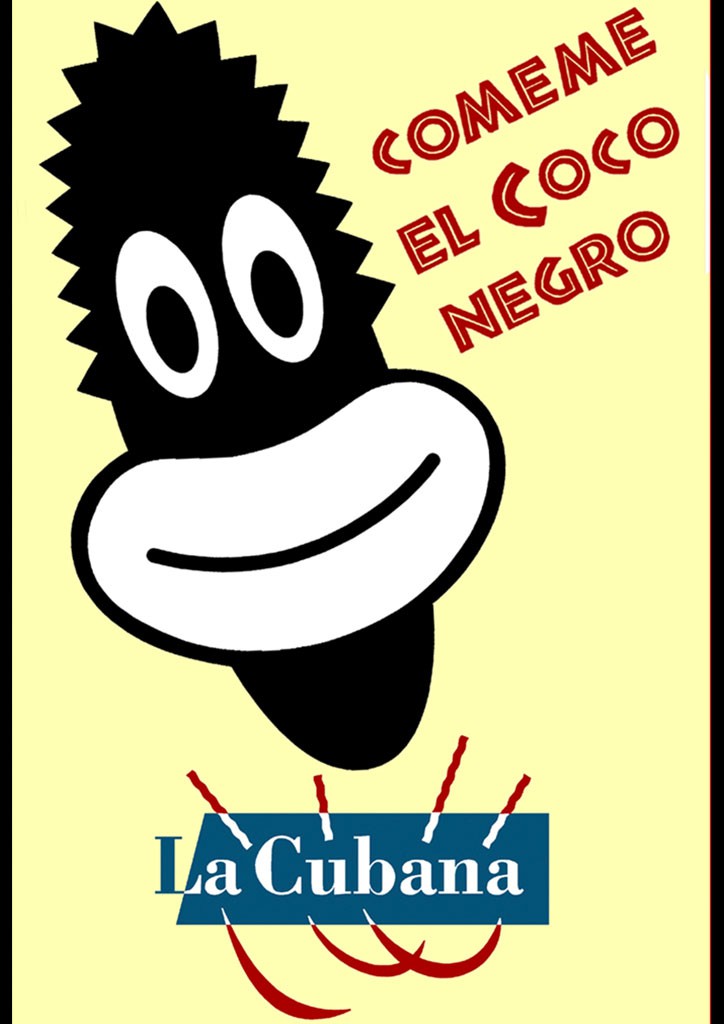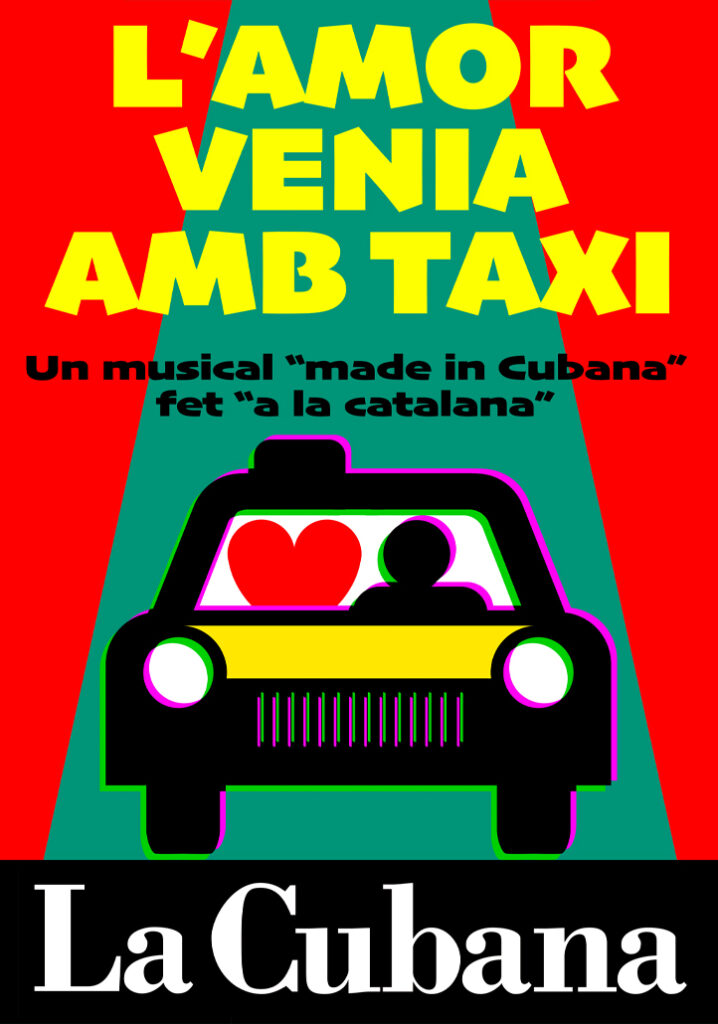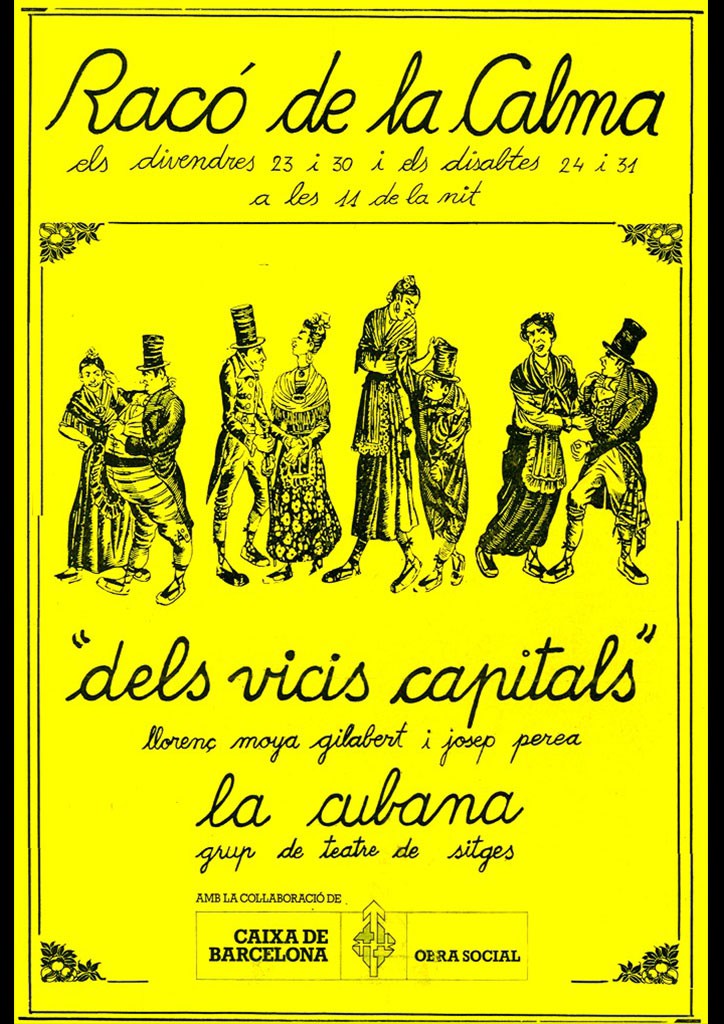Cegada de Amor (Blinded by Love)
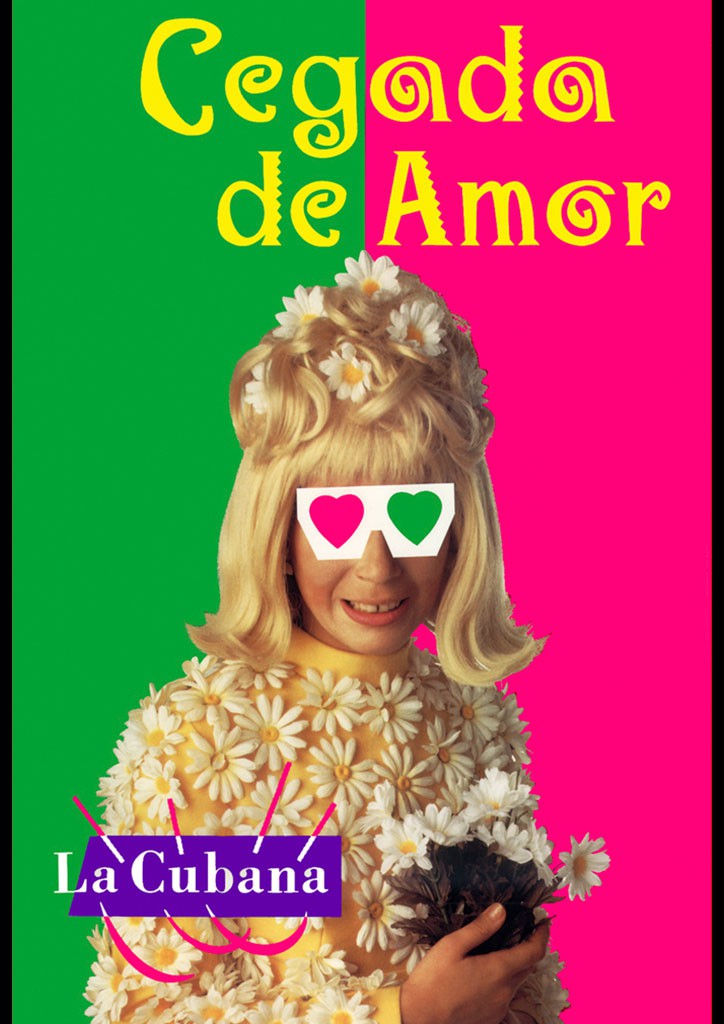
We have always wondered why the movies, even being far more distant, have won the theatre in credibility, which for obvious reasons theatre should be far more credible than cinema. ¿Why does the audience get more easily moved watching a movie than a theatre piece? ¿How can that be, since both talk about the same issues and are inspired alike? The experts say that it is all caused by the “magic of the cinema”. La Cubana has always been convinced that drama possesses its own magic too, and what is more, enjoys the closeness of the actors on stage. ¿What would happen then if we mixed the magic of the cinema with the closeness of the theatre? ¿What would come out of it? Well, a cinematography-theatrical experience.
The show is based on the projection of a film were the leading role is a fire-resistant “child prodigy” called Estrellita Verdiales. It is a Sixties pure film. Estrellita, an orphan girl aged 17, meets a French guy, who is a bad medical school student, in a student trip to Barcelona and they fall in love. After a while, the girl, just at her birthday, visits Paris. The French gentleman, Jean-François, organises a “pop-party” for her, with plenty of singing and dancing. Yet the tragedy arrives: the boy, as a trick, gives her a birthday cake with a bird case and two beautiful doves that they let free. One of the doves, unfortunately, shats over Estrellita’s eyes. The poor girl goes blind. The boy, quite desperate, swears her he will study hard in the Medicine School to cure her. Someone shouts: Cut! And they all stop acting, since it is not a “Child Prodigy” film but the shooting of a film with a child prodigy in, and the story line goes that way. Cinema within cinema.
Estrellita Verdiales is the prodigy girl, a 60 years old woman who through some treatments and some ornamental disguising, his producer, Andréu Marçal, has kept her young in front of the cameras. The Director of the film is Antonio Valdivieso, a very controversial one, self-centred, from the cinema cream of the country and whom his mother, Trinidad Gordillo, always accompanies him.
With the shooting going on, the audience, for many reasons, starts protesting: a gentleman criticizes the subject matter of the film, some folks start yelling, a lady accuses someone to be grabbing her… There is so much noise in the room, which even the characters from the film start getting nervous and demand some respect from the audience. The situation get worse and there is a dialogue between the audience and the screen. They reach such a tense atmosphere that a character from the film bursts through the screen coming out “life” facing the spectators.
From that moment onwards, the show is divided in many fields of action. The film stars come in and out the screen as if it were a natural thing to do and so do the staff from the theatre (cleaning ladies, the usher…) and even someone from the audience. The story line suffers constant changes. The script, from then on, turns quite crazy, as an interactive game, where the problems from the people inside, in the film, and the people outside, the audience, get so confused as to create yet another show by itself. At the end, with so much movement going on, the film burns up, leaving the actors charred. But, again, thanks to the audience involvement, the movie can reach its end, even if we find hard to distinguish what is going on the film and what is happening outside it.
You can watch the Edinburgh Festival version in the vídeo below:
PREMIÈRE: January, 28th 1994, Teatre Tívoli, Barcelona.
PLACES WHERE IT HAS BEEN PERFORMED: Ripollet, Sitges, Barcelona, Bilbao, Tarragona, La Corunya, Andorra, Mallorca, Girona, Las Palmas, Tenerife, Alacant, Torrelavega, Madrid, València, Granada, Màlaga, Sevilla, Córdoba, Huelva, Cadis, El Ejido, San Sebastián, Edimburgh, Gijón, Salamanca, Logronyo, Vitoria, Santander, Múrcia, Saragossa, Valladolid, Sant Cugat, Esparreguera, Vigo, Pamplona, Buenos Aires.
PERIOD: 1994-1998
PERFORMANCES: 1,308
SPECTATORS: 1.042,418 de spectators
SCRIPT:
Jordi Milán
Joaquim Oristrell
José Corbacho
Fernando Colomo
CAST:
Anna Barrachina
Silvia Aleacar
Maria José Pérez
Cati Solivellas
Miquel Crespi
José Corbacho
Jaume Baucis
Santi Millán
Xavier Tena
Jordi Milán
Andreu Marçal
* David Ramírez, substituted Miquel Crespi for leaving the company, right after the period in Barcelona Teatre Tívoli.
* Juanca Alegre and Jordi Milán, substituted for some performances Xavier Tena, for sick leave.
* Cristina López and Carmen Losa, substitued in some performances Maria José Pérez, for sick leave.
IDEA & DIRECTION: Jordi Milán
TECHNICAL STAFF:
Assistant Director: José Corbacho
Filmmaker: Fernando Colomo
Stage manager: Josu González
Light design: Jordi Planas
Light operator: Ramon Rey
Assistant light Operator: José Antonio Muñoz
Sound design: Albert Toda
Wireless sound design: Marc Sardà
Sound assistant: Alberto Pastor, Xavier Rodríguez
Screening: Josep Ma. Marín
Image adviser: Joan Alonso
Wigs: Carles Montosa
Hairpieces: Damaret
Prosthesis: Joan Margarit
Wardrobe: Cristina López
Choreography: Leo Quintana
Music and songs: Joan Vives
Stage set design: Dino Ibañez
Arm and mask: Lluís Traveria
Projector: Wassman
Graphic design: Raúl Pascuali, Raúl Rodríguez
Management and coordination: Carme Peris
Executive production, press, promotion and sponorship: Victòria Sanz
Assistant producer: Juanjo Sánchez
Administration: Natàlia Morillas
In Teatre Tívoli, Barcelona the show started as if it were a film projection. An old couple stood up and asked the usher whether that was really a film or if perhaps they will have a show afterwards, and that that’s what they came for. When the usher told them that that was a movie, nothing but a movie, the old gentleman told him that they didn’t use to go out much, but they considered the price quite abusive. After that, as the show went on, and the actors start coming off the screen, the old gentleman, sitting in his chair, any time he saw the usher blinked an eye on him or pat him on the shoulder with complicity.
Again in the Teatre Tívoli, Barcelona, at the stalls, a woman (an actress) accuses her neighbour of touching her; calls the usher in and they start quarrelling. The accused’s wife, confronted the actress on behalf of her husband, shouting: “What’s on your mind? He only touches me, you whore”.
Some other day, again in Barcelona a very Catalan spectator, felt offended by the comments that one of the actor-spectators, very Spanish, did on the Catalan language subject. The gentleman went straight to the lounge and ignored all our arguments; and stated that we were offending Catalonia. He wouldn’t listen to us and quite diligently phoned the police. When the police officers got there, first thing that he told them was that there was about to be a riot inside the theater. The police officers came in and saw the audience laughing. The gentleman insisted and the police officers found hard to understand the situation. Finally the gentleman left, sick and tired of insisting over it.
A very important anecdote from our stage on the Teatre Tívoli in Barcelona happened when, during a performance, a massive storm fell on the city. A lightening thumped nearby breaking down our sound system. But we still had the light working, so the film continued on. Jordi Milán had to step forward to tell the audience that due to a lightening storm nearby, the sound wouldn’t work anymore so at that point we would have to cancel the show. The audience started laughing, clapping hands, and some decided to go for a drink at the lounge at all times ignoring the storm and the lightening, assuming it was another joke from La Cubana. “An original way to announce the intermission”, said somebody.
In Teatro Lope de Vega, Madrid, one spectator sat beside an actress acting as a shrink. Once he heard the actress making comments out loud on the audience and the actors behaviour, as if she felt appalled, he told her: “Don’t worry, lady: I happen to know that the ones behaving like that are just actors camouflaged among the audience…” When later on, the actress had to take part of the show, the gentleman felt speechless.
Also in Madrid one spectator felt offended by the usher (actor) and called the police. When the officers got there, first thing they were told was: “A very impolite usher has offended me”. Then he was told that the usher was indeed an actor. He replied: “He is not an actor. He is an usher, since he is holding a lantern”.
“Cegada de Amor” premiere made a great stir in each city. We invited our guests in and encircled them with cameras, spotlights, and faked photographers all around, all together very glamorous. To the Madrid premier’s we had in the “cream of the crop”. The lounge was packed with people. A small group of celebrities were chatting away in circle up in a corner. Suddenly a what seemed a focus turned on and the group opened in half circle and went on posing as if a camera was filming them. It wasn’t a focus; it was only a quartz used to illuminate a flower jar full of daisies, but somehow the light was somewhat loose and it turned suddenly on. When the celebrities realised there was no camera, they couldn’t cope with it .
In the Teatro Lope de Vega, Seville, The Duchess of Alba came to see the show. She came on her own. Half way through it, when the actors came off the screen, she stood up distressed and left. When we asked her if there was any trouble, she said: “I’m afraid, they’re too noisy. This show frightens me.”
In València, the press conference was to be held at the train station. Estrellita would arrive by train and so the journalists would be waiting for her on the train’s platform. That is why all the actors had to take the van and get in the train in a nearby village 30 Km from València. But the van engine broke down half way to the village. We had not time to wait for the cranecar to arrive. If Estrellita lost that train, it would arrive without her and so the journalists sure would not understand a thing. Well, there we were hitchhiking on the road dressed as characters, and of course, no one stopped. Finally, an ambulance did, but they were full, so it took just Estrellita along, and luckily she could take the train. The rest of us got there at last!
Oddities Cegada de Amor’s tour
Antonio Valdidieso and Trini Gordillo (in the play were the director of the film and his mother) always said they were from Carmona, (Sevilla). And precisely, whilst we were acting in Sevilla, the Carmona’s City Council appointed Antonio and Trini as favourite sons of the city. The whole company moved to Carmona by bus. Once in the town, there was a party expecting us. All city council members and a music ensemble were there, as in Berlanga’s film “Bienvenido Mr. Marshall”. They took us to tour around the town and the Mayor and his attendants saw that, indeed, Antonio and Trini knew about every single detail of each building, person or tradition. The Mayor went onto Jordi Milán and said: “I don’t understand! They know more about Carmona than I do myself! Are they, or are they not from here?” What the Mayor didn’t know was that, the day before, Antonio and Trini (José Corbacho and Sílvia Aleacar) had gone to pay a visit to Carmona dressed in everyday clothes to find out all they could about it.
Ms.Trinidad Gordillo in the play was defending the homosexual orientation of her son Antonio. She was appointed the President of Honour of the Gay and Lesbian Organisation of Catalonia in a big camp party.
Cegada de Amor Press Conference (December 1993)
A month before the premiere, we had gathered the press conference in a cinema set in Barcelona. We pretended that the next work of La Cubana it was going to be a film instead of a play. So we went on pretending that was the shooting’s first day, and we introduced the directors Fernando Colomo and Antonio Valdivieso to the press, as well as the star Estrellita Verdiales. We invited them all to stay for the first scene that, by the way, it ended in madness! But, it was such a success, that everybody wanted to come to the premiere…
Presentation of the record Cegada De Amor at the Teatre Tívoli (1994)In order to promote the record, we gave a party in the stage, just right behind the screen in front of which we performed every night. The guests were invited to go through the screen from the stalls while the projection was on. Once they were inside, in the other side, they met with Estrellita Verdiales standing on the top of a gigantic skirt. The guests had to climb up to greet Estrellita who, on her behalf, gave them a present of the record. Afterwards, Estrellita sang a song and from inside the skirt appeared some “palmeros” accompanying her. At the end, the huge skirt was unfolded and everybody danced and sang.
Celebration for the 1st Anniversary on the run in Teatre Tívoi (January 1995)
To celebrate it, we invited the same people we did at the premiere a year before. The show went on as always. But, at the end, a big surprise: Estrellita came in marching victoriously, with over a hundred dancers, all of them spread around the theatre, and a big entrance of the cake which Estrellita blew. Then we invited the audience to step outside at the street: they found the same ceremony as they did at the premiere. A big red carpet, plants, focuses, spokesperson, etc that guided them towards another place, a garage inside the Teatro Novedades transformed in a ballroom. We gave a dinner for 1.000 people, with dance and orchestra, a raffle and many surprises. Standing on a podium, Estrellita accepted kindly the kisses from the audience.
Barcelona Farewell Party of Cegada De Amor (June 1995)That day, after the play was over, a big amount of people accompanied in procession Estrellita Verdiales to the Maremagnum to kiss her goodbye. In front of her, a music band and her fan club flying flags accompanied Estrellita, who was sitting in a carriage full of daisies all the way down La Rambla to the Maremagum. There she embarked on a boat singing “Goodbye Barcelona”, a song created by herself, whilst a huge pyrotechnic show commenced. Afterwards, a dance with orchestra closed the party.
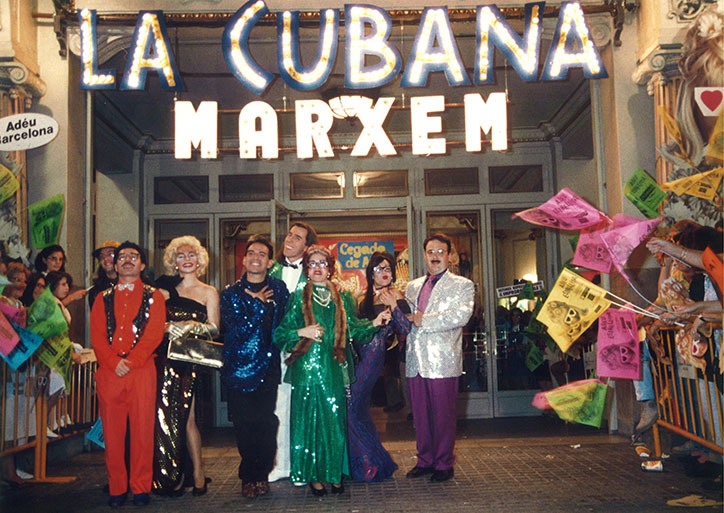
Press Conference of Cegada De Amor in Bilbao (August 1995)That was a very curious press conference. We met the press at Bilbao’s Airport. We made them believe that Estrellita was coming by plane from Barcelona and so it happened. The plane landed and the journalists were allowed to go to the landing field to greet Estrellita Verdiales as she came out from the plane. Then she sang something as in the old times, and there she answered to the questions. Press conferences like this one were given all the time during the tour, so Estrellita was received by the media in train stations, airports, docks, etc.a ser una roda de premsa curiosa.
Picnic at Parque del Retiro in Madrid to promote Cegada De Amor Summer Campaign (June 1996)To promote the summer campaign in Madrid we gathered the media at the Parque del Retiro. We build a fenced area inside the park and filled it up with artificial daisies, and organised a picnic, so the journalists were seated on the ground, surrounded by baskets and daisies and attended the presentation of the Estrellita Fashion created by Doña Trini (Antonio Valdidieso’s Mother). They also attended the presentation of her new summer song made for the promotion.
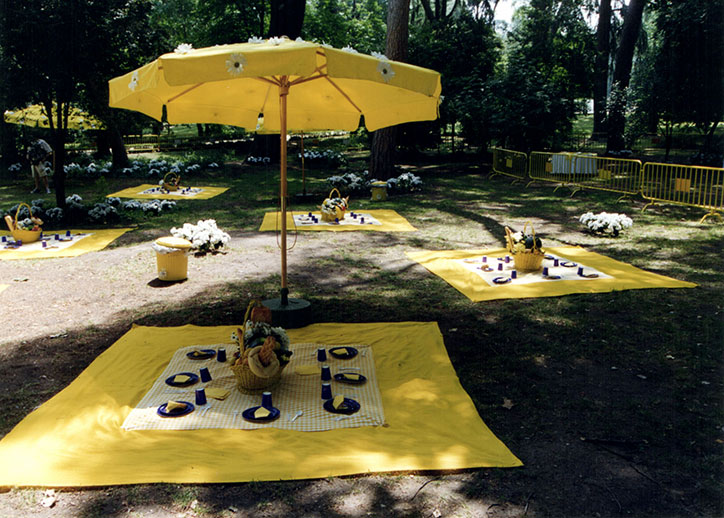
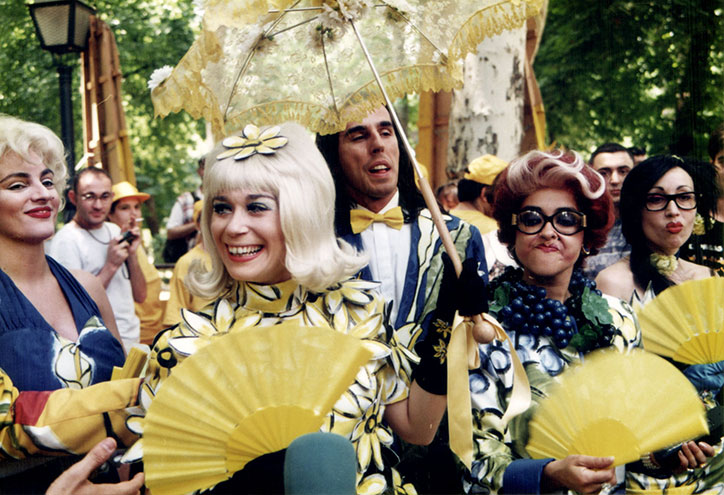
Proclamation of Estrellita as “Fallera of honor” of “Falla Na Jordana”. Valencia. (March 1997)
For the time we stayed in Valencia, at the Teatre Principal, the Falla Na Jordana Organization approached us to nominate Estrellita Verdiales for the “Fallera de Honor”. We organised a party to enthrone the proclamation at the Falla’s headquarters. We also built from scratch the stage design to go with the enthronisation. Estrellita had a special dress made for her, and the whole company participated in the events, including the traditional flower giving to the Virgin of the Hopeless.
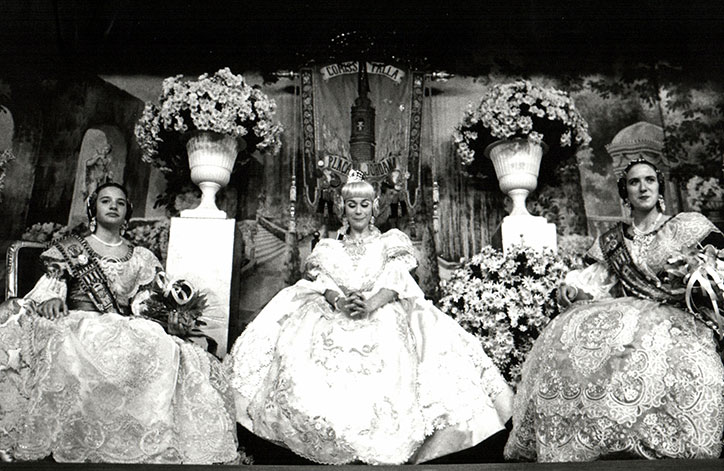
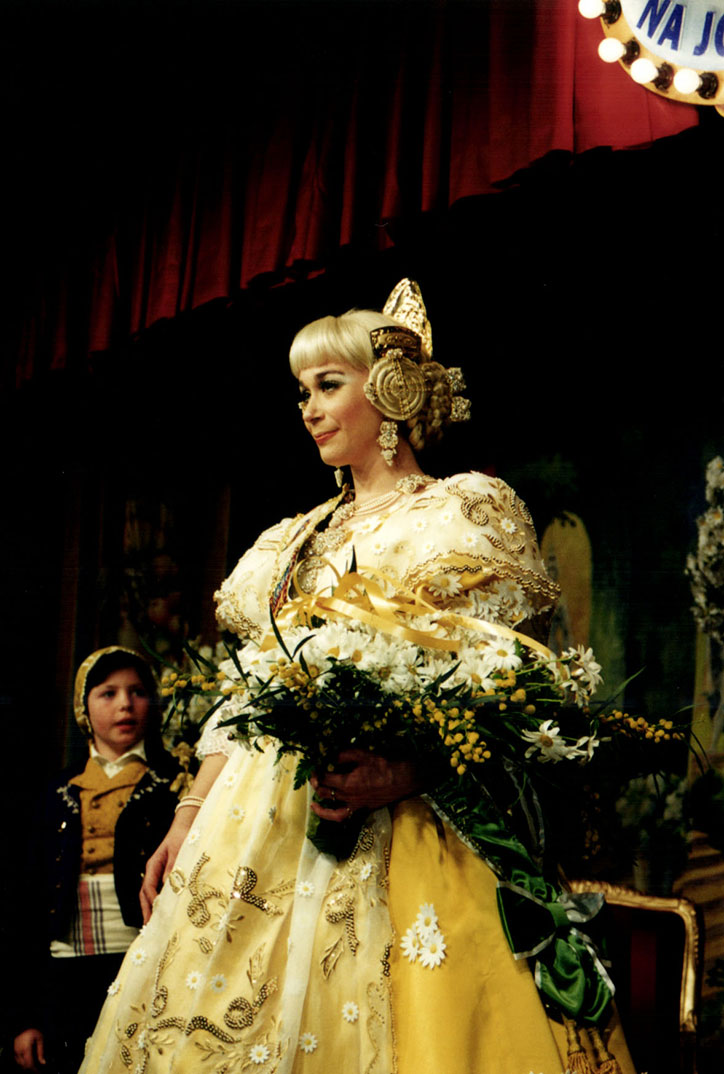
Presentation of the wax statue of Estrellita Verdiales at Barcelona Wax Museum (December 1997)
As we were reaching the end of the Spain Tour, the Barcelona Wax Museum made a replica of Estrellita Verdiales. A press conference was organised to inaugurate, where they showed all the process of how they had made such replica with Estrellita. At the end, the wax statue of Estrellita was placed at La Mancha’s cyclorama with Don Quixote and Sancho Panza.
Celebration In Pamplona Of The Spectator Number 1.000.000 Of Cegada De AmorWe had had similar celebrations in many other places; as it was the celebration of the spectator number 200.000 in Barcelona, spectator number 700.000 in Madrid, etc. But it was only casual that the celebration for the spectator number 1.000.000 happened at the Teatro Gayarre in Pamplona, city that we really love.
The audience was numerated as they got in the main door. When we reached the number 1.000.000, a music band played a march and the lucky spectator (a girl, that time) was enthroned at the hall, where she received a big amount of presents, and was brought to the stalls with all the protocol, red carped included, right to her seat. At the end of the show, a ball dance was ready in the hall of the theatre.
Farewell of the show in Spain with a popular “chorizo” meal at Plaza del Castillo in Pamplona Pamplona was, after all, the last place where we performed before taking off to South America, to Teatro de la Avenida in Buenos Aires. The farewell took place a Sunday afternoon at the crowded Plaza del Castillo. The party consisted of a huge gathering to eat chorizo and to enthrone Estrellita under the popular bower in the middle of the square. Estrellita, sitting on her gigantic skirt, received one by one all the people from Pamplona that wished to kiss her goodbye. At the end, as always, we closed the party with a big pyrotechnic scandal.
